BBC Radio – Rabia Balkhi and Mahsati Ganjavi >>>

BBC Radio – Rabia Balkhi and Mahsati Ganjavi >>>
THE RED ROOM – a portable opera for three voices. Set in 1930s Iran, The Red Room is an intimate drama with overtones of Gothic horror that explores nihilism and philosophic despair. It is based on a short story (The Darkroom) by the Iranian modernist master, Sadegh Hedayat, published almost 80 years ago in the collection of short stories called The Stray Dog. With a narrative that has echoes of Franz Kafka and Edgar Allan Poe, THE RED ROOM is an intense and disturbing drama about fear, isolation, and philosophical self-destruction.
In a provincial Persian town, an enigmatic stranger offers a stranded traveller a room. In a night of revelations, the traveller is drawn into the inner life of his Host and discovers the secret of the Red Room.
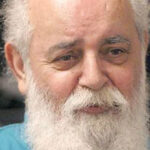
Iranian poet Amir Houshang Ebtehaj, known as Sayeh, died at 94 in Cologne, Germany on 10th August 2022.
Ebtehaj was born in Rasht, Iran. His first book of poetry was published when he was 19. ‘Sayeh’ was an ardent advocate of the poetry of social commitment. His early poetry reveals his concern with purposive literature. Ebtehaj has also written a collection of lyrical poems (ghazal) in the classical style. Here, he reveals an easy mastery of traditional forms—the lyrical ode, in particular—which he uses to celebrate both the sacred and the secular moments of life. Sayeh’s poetry, at times highly emotional, is always remarkable for its convincing directness and unconcealed sentiment. A number of his lyric poems, ballads and poems have been performed by famous Iranian vocalists and singers.
Payman Mansouri – Some Pieces >>>
Farmanfarmaian died on April 20, 2019, at the age of 97.
Lady Jamil Kharrazi, the founder and current director of Toos Foundation, kicks off the new year by joining the Board of Trustees of Park University of Missouri. Park University is a private non-profit organisation which offers courses in the liberal arts accessible and affordable by all. The University’s international music department has consistently excelled throughout the United States since 1875. During a ceremony with a special concert last week, the University decorated lady Jamil with the badge of honour and announced her membership of the Board of Trustees.
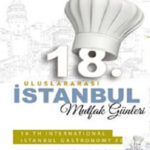
Iranian cooks came in second place at the 18th Federation of International Cuisine Days in Istanbul Turkey after winning dozens of medals. The 18th international gastronomy festival was held in Istanbul with the participation of representatives from 77 countries.
At the end of the festival (Dec 2021), the Iranian cooks and chiefs came in second place after winning 23 gold, 15 silver and 12 bronze medals in the two categories of cooking and confectionery. The festival began on December 22nd and ended on December 25th. The following is video footage of the closing ceremony of the festival.
The cultural history of Iran – from the early civilisations through to the modern era – is the focus of a major art-historical survey exhibition in Berlin’s James-Simon-Gallery. The works on exhibit bear witness to the central role that Iran played as a site of innovation, as a melting pot and cultural powerhouse connecting Africa, Asia and Europe. Additionally, it presents a rich kaleidoscope of the cultural creativity of urban societies.It takes visitors on a journey through time and the country’s rich cultural heritage.
The exhibition – a must-see for lovers of painting and ceramics in particular – shows how, over the course of several thousand years, a specifically Iranian cultural identity emerged as a language of instruction and cultural production, an identity that was continuously transforming. The exhibition will end 20th March 2022.
Since affiliating with the Smithsonian Institution in 2019, the Morris Museum has become a happening place. The stately walls of the former Frelinghuysen Twin Oaks Mansion in Morris Township now share space with artworks intended to challenge and enthrall visitors.
The latest example is Body Double: The Safarani Sisters, an exhibition of paintings on canvas superimposed with video. Ethereal and hypnotic, the paintings can stand alone. They are realistic and spare, often depicting a barely furnished room with large windows covered by sheer curtains and drapery. The lighting is dramatic, with sharp contrast between light and dark.

Directed by Mojtaba Ghasemi, “Khoonab” won the Best Director Award of the Universal Film Festival (Kansas, USA, Nov 2021). Last year, Ghasemi also won the Best Director Award of the Rome International Film Festival. The film’s synopsis read, “The distance from ascent to descent is a narrow line of choice, a choice between good and evil.”
The Universal Film Festival was founded in 2007 in Kansas City, Missouri, USA, and each year it awards prizes in 14 categories including the best director.
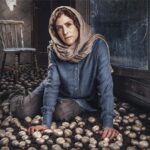
“The Badger”, directed by Mollaei was screened in the 17th Terni Film Festival of Italy alongside seven films from Switzerland, the US, Italy, Mexico, Afghanistan, and Ukraine, and finally the jury of this cinematic event presented its best director award to Mollaei for the film “The Badger”.
In this movie, Soodeh’s 11-year-old son is kidnapped before her second wedding and she is forced to ask her ex-husband for the ransom money. It features several well-known Iranian actors and actresses, including Vishka Asayesh, Hasan Majouni, Mehraveh Sharifi-nia, and Behnoush Bakhtiari.
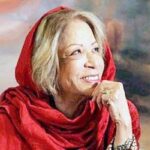
Iran Darroudi, well-known Iranian painter, film director, art critic and university professor, died of cardiac arrest at the age of 85 in Tehran.
Darrudi was an influential artist who had been active for more than 50 years in Iranian contemporary art. Her achievements include more than 60 individual exhibitions, art critiques published in various journals, and some 80 collaborative documentaries, the last one being an autobiography, “Distance Between Two Dots”.
A selection of her paintings: Iran Darroudi (toosfoundation.com)
I am old but sometimes my heart remembers youth (in Persian) >>>
May 2021
n/a – see the Persian Page
Evlin Baghcheban’s played a crucial role in promoting opera and choral music in Iran. On the 10th anniversary of her death, her son, Kaveh Baghcheban, has published some of the recordings and documents from the family’s private archive. Many recordings and documents were destroyed in 1979 making any research into the history of opera and choral music in Iran rather difficult. Funded by Toos Foundation in London, the published collection includes an audio CD and more than 50 rare documents and photos. It is focused on Evlin Baghcheban’s career, but shedding light on the history of music in 20th-century Iran as well. Most of the materials were previously not accessible to the public. October 2020.
London – October 2020
An exhibition of sculptures by Hossein Azadi is currently underway at Etemad Gallery 1. The exhibition is titled “Crumpledness”. Hossein Azadi was born in 1979 in Hamedan, Iran and received his Painting B.A. from University of Art in Tehran in 1999. The exhibition will run until the end of September.
Siah Armajani, an Iranian-born American artist whose architecturally scaled, politically inflected public sculptures have been internationally influential even as he kept a low profile in the art world, died on Aug. 27 at his home in Minneapolis, a city where he had lived and worked for 60 years. He was 81.
“I am interested in the nobility of usefulness,” Mr. Armajani was quoted as saying in a 1990 profile in The New Yorker. “My intention is to build open, available, useful, common, public gathering places. Gathering places that are neighborly.”
Three projects by Iranian architects have been selected by the Dezeen Awards 2020 as the world’s most popular and influential architecture and design competition has announced its longlist.
The projects are Pardis Khaneh, the Kohan Ceram Central Office, and the Noor E Mobin Primary School, and a jury composed of Norman Foster, Joyce Wang, Michael Anastassiades and Paola Antonelli will be judging the designs.
Hooman Mehdizadehjafari has been selected for the City View Park public art commission. Mehdizadehjafari’s artwork, Soar, will be installed in front of the new pavilion being constructed at City View Park (Burlington, Canada). Hooman Mehdizadehjafari, creator of Hoomanart is an award-winning Iranian-Canadian visual artist and designer born in Kerman and now based in Vancouver, Canada.
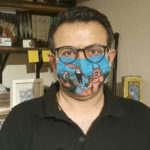
Ferdowsi’s masterpiece Shahnameh and its seven adventures have been the source of inspiration for Iranian graphic designer Yazdan Saadi’s new collection of paintings on face masks, which depict the mythical Iranian hero Rustam fighting coronavirus monsters. >>>
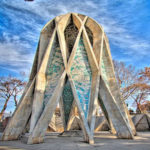
Omar Khayam the Persian poet and polymath was born on 18th May 1048:
The Moving Finger writes, and, having writ,
Moves on: nor all thy Piety nor Wit
Shall lure it back to cancel half a Line,
Nor all thy Tears wash out a Word of it.
Manuchehr Sahbayi – Wikipedia >>>ُ
Emanuel Melik Aslanian – Recital of 1996 – Parvaneh >>>
Parvaneh (Butterfly) by Emanuel Melik Aslanian >>>
Melik Aslanian plays J.S. Bach Fantasia and Fugue in A minor >>>
Emanuel Melik Aslanian – Dialogue for Piano and Orchestra – Part I >>>
Emanuel Melik Aslanian – Dialogue for Piano and Orchestra – Part II >>>
Gholam Hosein Banan, Marzieh – booye jooye mooliyan >>>
Evelyn Baghcheban – Wikipedia >>>ُ
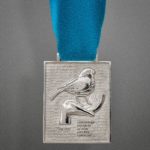
Renowned Iranian artist Parviz Tanavoli, has created a series of limited-edition medallions to raise funds for beleaguered hospitals in his homeland fighting the Covid-19 virus.
“I am extremely impressed by how Iranian healthcare workers are dealing with the Covid-19 crisis,” says Tanavoli, “And what they are accomplishing with the bare minimum of equipment”.
Medallions can be ordered by emailing pr@tanavolimuseum.com
For his latest photography series, Manuel Alvarez Diestro transports us to the isolated landscape of Iran’s deserts. Amid the vast expanse of rolling land and mountain peaks, the images hone in on new housing developments. From afar the tower blocks appear as models in miniature, while closer up, the true scale of the buildings can be appreciated.
n/a
Sasanian music – Wikipedia >>>ُ
n/a
n/a
Alireza Mashayekhi – Wikipedia >>>ُ
The Stylistics of Romantic Poetry of Iran >>>
Foroughi – Wikipedia >>>
Zende – Wikipedia >>>
Mahmoud Zoufonoun Collection – diva >>>
Mahmoud Zoufonoun – Violin Improvisation in Afshari – Part 1 of 2>>>
Mahmoud Zoufonoun – Violin Improvisation in Afshari – Part 2 of 2 >>>
Mahmoud Zoufonoun and Gholamhossein Banan – Bayate Tork >>>
Mahmoud Zoufonoun – Violin solo >>>
Mahmoud Zoufonoun Plays Violin >>>
Poetry of female sonneteers in the constitutional era >>>
Mehrdad Avesta – Wikipedia >>>
Mamak Khadem Sings the Poetry of Sohrab Sepehri >>>
Not Available
A Night in Shiraz for Persian Chang >>>
Golfam Khayam – ُWebSite >>>
Ziba Karbasi – Exiled Writers Ink >>>
Mohammad-Ali Sepanlou – Wikipedia >>>
Ebrahim Olfat – ُArtexhibition Net >>>
Babak Rashvand – ُWebSite >>>
Maryam Ghanbarian – ُWebSite >>>
Mehrdad Shoghi – ُWebSite >>>
Faramarz Payvar – Wikipedia >>>
Samin Baghtcheban – Wikipedia >>>
Rahmatollah Badiyi – Wikipedia >>>
Asadollah Malek – Wikipedia >>>
Mahmoud Javadipour – Official Site >>>
Naghareh – Wikipedia >>>
Daf – Wikipedia >>>
Emad Faghih Kermani – Wikipedia >>>
Rokneddin Mokhtari – Wikipedia >>>
Muzaffarid dynasty – Wikipedia >>>
Kushan Empire – Wikipedia >>>
Mir Seyyed Ali – Wikipedia >>>
Rudaki Lyre | Persian Choral Music >>>
Bayazid Bastami – Bani Foundation >>>
CYRUS the GREAT and PASARGADAE >>>
Soheil Nasseri’s Site >>>
Lily Afshar – Wikipedia >>>
Mohammad-Reza Shajarian – Wikipedia >>>
Dashti Etude – Composed by Ali Naqi Vaziri Performed by Houshang Zarif on Tar >>>
Ziryab – Wikipedia >>>
The Decline and Fall of the Safavid Empire – NYUAD Institute >>>
The Idea of Iran: Safavid Era | Conference Part 1 | SOAS University of London >>>
The Idea of Iran: Safavid Era | Conference Part 2 | SOAS University of London >>>
Ottoman, Safavid and Mughal Empires | World History | Khan Academy >>>
Abbas Amanat – Iran: A Modern History >>>
This year’s winning design was awarded to Iranian artist Setareh Feylizadeh from Paris, France. “Participating in a competition such as this, especially one which connects us to our roots, cultures, and traditions, has been so rewarding, ” said Feylizadeh. “The ultimate prize of winning this competition is the chance to connect with another community of Persians in another part of the world by spreading the message of Nowruz, which bonds us together and brings us closer to one another.”

Dec 2019. Iranian musician Nima Delnavazi, teacher and tar player, has received the silver medal for his ‘Ray to Tisfound’ album in the latest edition of Global Music Awards in the US.
Delnavazi is considered one of the youngest talents in contemporary Persian music.
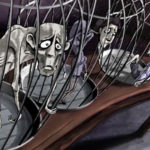
Iranian short animated piece ‘Pet Man’ by Marzieh Abrar-Paydar has won the top prize at the 4th edition of Bogota International Animation Festival in Colombia. (Nov 16 2019).
‘Pet Man’ tells the story of an animal dealer who falls asleep in his shop and has a nightmare where he is trapped inside an animal cage. In his attempt to escape from the animals, he encounters various obstacles.
Sunday Oct 13th 2019, Logan Hall, London
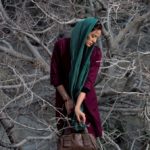
August 10, 2019-February 9, 2020
Smithsonian’s Freer and Sackler Galleries, Washington, DC
“My Iran: Six Women Photographers” will be on view at the Smithsonian’s Arthur M. Sackler Gallery Aug. 10 through Feb. 9, 2020. It is the latest in the museum’s ongoing exhibition series of contemporary Asian photography. Drawn from the museum’s growing collections, the works of these six female photographers, Hengameh Golestan, Newsha Tavakolian, Malekeh Nayiny, Shadi Ghadirian, Mitra Tabrizian and Gohar Dashti, present multiple visions of Iran that are largely unknown to American audiences.
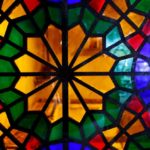
Artists in Markazi province are trying to revive the traditional art of making wooden Girih artworks which has vast applications in Iranian architecture. One of the most eye-catching manifestations of this art is the formation of Orsi, or colourful, windows in different Iranian buildings.
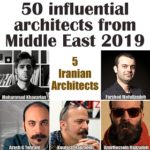
Five Iranians have been named among the 50 most influential architects of the Middle East in 2019, according to a list published by the Middle East Architect (MEA) magazine. The magazine named Mohammad Khavarian, Kourosh Hajizadeh, Amir-Hossein Hajizadeh, Farshad Mehdizadeh and Arash G Tehrani as Iran’s influential architects in the Middle East region.
The Middle East Architect is a monthly magazine that delivers news, data, analysis and strategic insights for architects.
The Toronto-based Aga Khan Museum has launched an exhibition of Persian art in Qajar era. The exhibition brings together rare paintings, lacquerware, lithographed manuscripts, photographs, musical instruments, and textiles from a host of prominent international and national collections. The exhibition features masterpieces from the Aga Khan Museum collection alongside a large number of exhibits on loan from the Louvre Museum and other institutions, including the Arthur M. Sackler Gallery, the Museum of Fine Arts Houston, the Royal Ontario Museum, the Textile Museum of Canada, McGill University Library’s Rare Books and Special Collections, and private collections.
The exhibition entitled “Transforming Traditions: The Arts of 19th-Century Iran” is curated by Ulrike Al-Khamis, Director of Collections and Public Programs and Bita Pourvash, Assistant Curator, both of the Aga Khan Museum. The exhibition ends in Feb 10, 2019.
Twenty-one designs and architects from Iran are among the nominees for the 2018 Middle East Architect Awards, which were announced by the organizers last week.
The nominations include: Golshahr Mosque and Plaza by Arash G. Tehrani, Floating Island by Kamran Heirati Architects, and Persian Tehran Garden by Hooman Balazadeh and Mohammad Khavarian for the award in the Concept Design of the Year category and the Thirty-Pine Villa by Aleshtar Architectural Office and the City Hall Square Rehabilitation by Polsheer Architects in the Landscape Design of the Year category. Winners will be announced during a special ceremony in Dubai on November 21.
Shahid Balkhi – Wikipedia >>>
History of Iran – Wikipedia >>>
From Encyclopaedia Iranica: The Aryans >>>
Iranian Languages >>>
Language, Writing, and Tradition in Iran, by David A. Utz, 1991 >>>
On the Nature of the Vedic Gods, by Catalin Anghelina, 2013 >>>
The Expansion of the Indo-European Languages >>>
Manichaean Gnosis and Creation Myth, by Abolqasen Esmailpour, 2005 >>>
Indo-Iranian Religions >>>
Iran: The Shah and the Ayatollah | DW Documentary >>>
The Last Shah – Iran History – BBC Documentary >>>
Swiss TV Interview with the Shah 1977 >>>
The paradox that is Persia: Abbas Milani at TED Stanford >>>
Iranian Treasures – Persian Treasures – Jewelry 1 of 2 >>>
Iranian Treasures – Persian Treasures – Jewelry 2 of 2 >>>
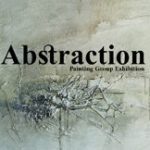
The collection, dedicated to abstract paintings, is showcasing about 30 works by nine Iranian artists, including Iraj Shayestehpour, Giti Norouzian, Maryam Moghadam, Saba Mousavi, and Ghazal Vakili. The works on display are inspired by an Eastern and Persian outlook at concept paintings with a different view at modern art.
The works by the Iranian artists are a delicate, small and yet thorough slice of the inner world with a particular narrative from the point of the view of the artist. The paintings mainly aim to convey emotions and feelings without relying on the environment, and try to teach the visitors not to allow any intervention in their interpretation of the work of art.
The exhibition will last until October 15 at 7 Art Gallery in Istanbul, Turkey.
The Fox’ won the best short film award in competition with 39 other animated films, at World Animation Film Festival in Bulgaria’s coastal city of Varna. ‘The Fox’ is about a young and lively fox that is caught by a hunter when experiencing its first love. The hunter puts a bell around the fox’s neck and returns it to the woods. The bell prevents the fox from hunting and living its normal life in the woods and it soon realizes that its only way to survive is to be tamed and go back to the hunter.
The history of the World Animation Film Festival in Varna dates back to the late 1970s. Following the political changes in Bulgaria of 1989, the forum was discontinued. In 2011 it was brought back to life by a group of lecturers and students from the New Bulgarian University. They met the support of the Ministry of Culture, the National Film Center, the Bulgarian National Television, the Bulgarian National Radio, and the Municipality of Varna.
Farhang Foundation is calling on aspiring and established graphic artists to submit original designs that conceptualize Norooz (the Iranian New Year) commemorating the annual celebration of Norooz in Los Angeles. Eligible designs will be considered as the central artwork featured on street banners and other marketing material that will proudly promote Farhang’s 11th Annual Norooz Celebration at UCLA throughout prominent boulevards and streets of Los Angeles in February and March of 2019.
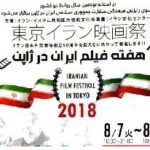
‘Iranian Film Festival in Tokyo’ to kick off on Aug. 7
The event will screen seven Iranian movies, documentaries and animations.
Dramas including ‘Season of Narges’, ‘Delbari’, ‘Bodyguard’, ‘Where Are My Shoes?’ and ‘Mermaid’, the animated feature of ‘Mobarak’ and also ‘The Eastern’ documentary will be screened in this festival.
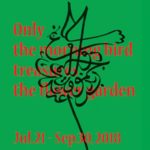
JUL 21 – SEP 30
Location: REDCAT – Roy and Edna Disney/CalArts Theater
The group exhibition Only the Morning Bird Treasures the Flower Garden, which takes its title from a poem by 14th century Persian poet Hafiz, includes photographs, videos, and other works by more than twenty Iranian artists on the theme of flowers. It is co-curated by artist Mehraneh Atashi and Sohrab Mohebbi. Artists, writers and other colleagues were invited to contribute to an exhibition and publication exploring the historical, literary and symbolic connotations of flowers in Iran.
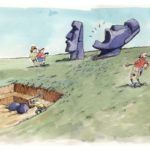
Iranian cartoonist Saeed Sadeghi won the Golden Hat of 57th Knokke-Heist Cartoon Festival in Belgium.
The Cartoon is about the Maoi large stone statues on Easter Island. Cartoonists from Portugal and Bulgaria received the Silver and Bronze Hats respectively. Participants were free to choose the theme of their entries. Displaying of selected works has started from June 30 in Knokke-Heist and will end on September 9.
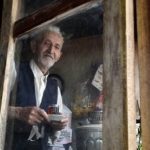
Iranian photographer Parviz Nourizad has won silver medal at the 11th Salon Daguerre in France. The event is one of the most prestigious photo contests hosted by France. Nearly 8000 pictures were received at the 2018 edition of the event. Nourizad’s photograph ‘Mr. Naeb’ won the silver medal at the contest.
The 11th Daguerre exhibition is organized by the Photoclub Paris Val-de-Bièvre in Paris, France.
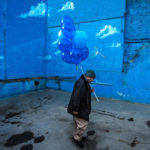
According to FIAP (Fédération Internationale de l’Art Photographique) center in Iran, the event held in Finland awarded ‘Vision Bronze Medal’ and ‘The Best Friendship photo’ title to Kiarang Alaei, for his photo, named ‘Loyalty’. Meanwhile, the photo ‘Single’ by Hamid Reza Helali won the ‘PSA Honorable Mention.’
The festival was held in Finland by the Finnish Museum of Photography, under the auspices of the FIAP and the Photographic Society of America (PSA) in three different sections. It displayed works by photographers from Iran, who are members of the FIAP center in Iran including Kiarang Alaei, Bahram Yazdanpanah, Hamid Reza Helali, Ahmad Khatieri and Amir Hossein Honarvar.
Iranian films are to be screened in Copenhagen during a festival of Iranian films at Denmark’s Film Institute in April 15-28, 2018.
Works by a number of Iranian directors will be screened during the festival: Abbas Kiarostami, Narges Abyar, Behnam Behzadi, Rokhsare Ghaemmaghami, Shahin Armin, Sohrab Daryabandari, Ali Souzandeh. The Home directed and produced by Asghar Yousefi-Nejad, is one of the films to be shown.
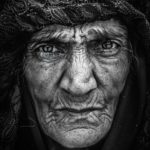
The Iranian photographers participating at the Bristol Festival of Photography in Britain were honored in various parts of the festival. Eyes photo collection by Negar Aqaalitari won the Bronze medal and Crossing photo collection by Ehsan Nikfarjam and Iron Seller photo collection by Amirali Navadeh-shahla were given the Honorable Mention.
The festival was organized under the supervision of the Fédération Internationale de l’Art Photographique (FIAP), and the American Photography Society of America (PSA) in four sections on free color, free monochrome, travel, and nature issues.
Following the success of their space in Tehran, CAMA Gallery, the new international market leaders in Modern and Contemporary Iranian art, have announced the opening of their London gallery on the 5th of April with an inaugural exhibition of 19 Contemporary Iranian artists. The 19 artists are Bita Vakili, Meghdad Lorpour, Behrang Samadzadegan, Mojtaba Tajik, Flora Feizbakshsh, Samira Alikhanzadeh, Azra Aghighi Bakhshayeshi, Saeid Ahmadzadeh, Morteza Pourhosseini, Elham Yazdanian, Babak Roshaninejad, Ali Nedaei, Tahereh Samadi Tari, Ojan Shirozhan, Mostafa Nourbakhsh, Fereydoon Omidi, Maryam Salour, Mohsen Jamalinik and Mohammad Tabatabai.
“The Prince and the Shah: Royal Portraits from Qajar Iran” offers a rare glimpse into the development and dissemination of royal and aristocratic portraiture in the 19th century and early 20th century in Iran at a time when the country underwent major political, societal and cultural changes. On view at the Smithsonian’s Arthur M. Sackler Gallery Feb. 24–Aug. 5, the exhibition highlights about 30 paintings, photographs and lacquer works from the collections. The exhibition includes several major and otherwise unknown works, which the Freer|Sackler has recently acquired through gift and purchase: a monumental painting of Ahmad Shah Qajar and his cabinet from 1914, the portrait of Prince Jalal al-Din Mirza dated 1859 and attributed to the renowned Qajar artist Abu’l-Hasan Ghaffari, and a selection of finely painted lacquer works.
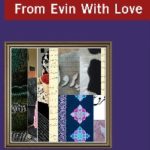
The exhibition “From Evin With Love” designed and developed by Mansoureh Shojaee, in collaboration with Vrije University Amsterdam will open on March 9, 2018 in The Hague, Netherlands, presenting the handicrafts of Imprisoned Iranian women activists. The exhibition will run through April 6, 2018 and will feature a number of prominent Iranian and foreign speakers as well as a performance by Nasrin Hobby & Ensemble.
Venue: Humanity Hoouse – Prinsegracht 8, 2512 GA The Hague, Netherlands
Tag Kasra screening at the Freer Gallery of Art-Smithsonian >>>
Tag Kasra screening at the Council on Middle East Studies Cinema >>>
Tag Kasra screening at the US Military Academy in West Point >>>
The Middle East in London: Events in London >>>
Taq Kasra: Wonder of Architecture – Alfred Deakin Institute >>>
Taq Kasra: Wonder of Architecture >>>
Premier on 1 February 2018 at SOAS
World Premiere screening of Taq Kasra: Wonder of Architecture, the first-ever documentary film on the world’s largest brickwork vault.
Date: 1 February 2018 at 7:00 PM
Venue: Russell Square: College Buildings, Khalili Lecture Theatre
Taq Kasra was in serious danger of ISIS attacks in 2015-2016 and this was the main motivation for documentary maker Pejman Akbarzadeh to film the arch before it was destroyed. The documentary is produced by the Persian Dutch Network, in association with Toos Foundation, and partially funded by the Soudavar Memorial Foundation.
The Festival of Iranian Film, or ÍRÁN:CI, is taking place for the seventh time in Prague. The festival founder explained the theme of the latest edition which will open January 8, 2018 at Bakala Foundation as “Don’t be scared”.
“It’s about bringing films from filmmakers who didn’t hesitate to go beyond what are considered to be the boundaries of commercial cinema. They are experimenting, but in a way that still attracts the audience, in a very heart-felt way.”
The 93-year-old doyenne of Iranian art, Monir Shahroudy Farmanfarmaian, has donated more than 50 of her works to a new museum dedicated to her oeuvre in Tehran. The Monir Museum, which openend on 15 December is the first institution in Iran devoted to a single female artist.
The Museum operates under the auspices of the University of Tehran and is housed in Negarestan Garden, a Qajar-era palace complex that became a museum of culture and later closed. The interior has been redesigned by the Iranian architect Reza Najafian.
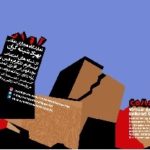
Iranian painter and graphic designer Behzad Shishegaran has launched an online exhibition entitled “Collapse” on Instagram, Telegram and Facebook to raise funds for the victims of the devastating earthquake that hit Kermanshah region in western Iran last month.
instagram.com/behzadshishegaran
facebook.com/behzad.shishegaran
t.me/behzadshishegaran
“Technologies of the Image: Art in 19th-Century Iran” at Harvard Art Museum presents notable and never before seen works of the Qajar era. It brings together four principal art forms of 19th century Iran — lacquer, lithography, photography, and painting and drawing on paper. The exhibition aims to explore the separate and intertwined histories of these art forms, the contexts of production, and means of distribution across the various strata of society. The exhibition has on showcase, almost 80 artworks, most of which have never been exhibited before.
“Technologies of the Image: Art in 19th-Century Iran” is on view through January 7, 2018 at the Harvard Art Museum, 32 Quincy St, Cambridge, USA
Go West, the first solo show in the U.S. for Iranian artist Farhad Moshiri has opened in Andy Warhol Museum. The exhibition will run through Sunday, January 14, 2018.
Encompassing several bodies of work created over decades, Farhad Moshiri: Go West explores the artist’s varied subject matter, deft use of language, and wide-ranging materials and methods.
The 2nd Sheed Persian Film Festival which aims to promote and introduce Iranian cinema, will be held in Dallas, Texas from November 10 to 12.
Winners will be presented with a CloseUp Award this year in memory of the Iranian filmmaker Abbas Kiarostami. The award, which has been named after Kiarostami’s 1990 masterwork “Close-Up”, will be presented to the best film, best director and best actor and actress.
Farhang Foundation has announce the first winning design installation of its Iranian Mural Design Competition in collaboration with Beautify Earth. The first installed design is by renowned artist Farzad Kohan, titled HUMANITY, and additional winning designs will be announced as they are installed throughout the city!
Farhang Foundation in collaboration with local museums and galleries, presents FOCUS IRAN: Contemporary Photography and Video, a biennial juried exhibition of contemporary photography and video works relating to Iranian culture or heritage. The next exhibition of this year’s winning submissions will be in Irvine.
September 16, 2017 – October 13, 2017
Viewpoint Gallery-UCI
A311 Student Center, Irvine, CA 92697
Six designs by Iranian architects have been shortlisted for awards at the 2017 World Architecture Festival, which will be held in Berlin from November 15 to 17. Pars Hospital in Rasht and a house named Three Views in Tehran, both completed at the New Wave Architecture Company, have been nominated in the Completed Buildings’ category. The buildings have been designed by Shahin Heidari and Lida Almasian. In the Future Projects, the Tehran Mixed Use Complex in Tehran designed at the EAA Emre Arolat Architecture will compete. In the Residential Apartment category the villas in Tehran that was completed at the Housing Arsh [4D] Studio has been selected. This building has been designed by Alireza Sharafati and Pantea Eslami. Villa Oushan in Tehran from the Behzad Atabaki Studio and the Chabahar Freezone Organization Headquarters in Chabahar from Karand Group have also been picked to compete in this category.
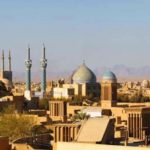
The historical city of Yazd in central Iran has become the country’s 22nd world heritage site after the World Heritage Committee voted in favor of its inscription on Sunday during the committee’s 41st session in Krakow, Poland. Almost 200 hectares of the city’s 2,270-hectare historical texture now boast world heritage status. Yazd is now the only UNESCO-listed Iranian city where people still live. It is also believed to be the world’s largest inhabited adobe city. Yazd is home to UNESCO-listed ancient Persian qanats as well as Dolat Abad Garden, which is one of nine Iranian gardens inscribed collectively on the World Heritage List as “the Persian Gardens”.
AB43 CONTEMPORARY is pleased to present the solo exhibiton “Traces of Yesterday” of new works by GOLNAZ FATHI, opening on August 26, 2017. GOLNAZ FATHI (born 1972 in Tehran, Iran) trained at the renowned Iranian Society of Calligraphy and went on to receive various awards for her work as a calligrapher. She then chose to embark on a much freer career in the fine arts and, in doing so, has developed her own unmistakable style. She is an internationally celebrated artist, who has succeeded in bridging the gap between traditional and contemporary culture as well as between Eastern and Western ways of life.
A year after Abbas Kiarostami’s death, Close-Up Film Center in London will celebrate the art of his cinema by screening some of his rarely seen early films from 5-19 June 2017.
The program ‘Abbas Kiarostami: Early Works’ will show a series of documentary, short and feature films made in the 1970s and 1980s. A documentary on the filmmaker’s life and career as well as his last short film are also included. Film critic Ehsan Khoshbakht has selected the movies and organized the event which is supported by the British Council. A booklet in English about the films will be distributed as a guide for the films being screened. It contains famous critics’ reviews and opinions on Kiarostami’s early films.
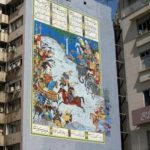
A huge miniature painting featuring the First Battle of Rustam and Afrasiyab, a story from Ferdowsi’s epic masterpiece Shahnameh, was unveiled in Tehran’s Ferdowsi Square last week.
The 700-square meter mural has been painted by veteran artist Abbas Barzegar-Ganji on the wall of a nine-story building located to the northwest of the square. Verses of the Shahnameh recounting part of the story have also been inscribed on the top and bottom of the mural, which was unveiled on National Ferdowsi Day last Monday.
An exhibition of Persian classic paintings will be held at the Harvard Art Museums, part of Harvard University in Massachusetts, the US, 20 May to 13 August 2017.
The exhibition features illustrated Persian manuscripts and detached folios collected in the early 20th century by Harvard alumnus Bernard Berenson (1865–1959), the famous American art historian and connoisseur of Italian Renaissance painting. Berenson prized these works at his home in Florence, Villa I Tatti, which he bequeathed to Harvard and which now serves as the Harvard University Center for Italian Renaissance Studies.
The 27th edition of the International Festival of Cartoon and Humorous Literature Gura Humorului will be held from 16 to 18 June 2017 in Romania.
The theme of this term of the contest is: THE ART OF MANIPULATING PEOPLE.
Original works are accepted, in digital format, created after 1 January 2017, which were not published and submitted or awarded prizes to other competitions. All works should be submitted by 31 May to the following addresses: email: umorlahumor@gmail.com
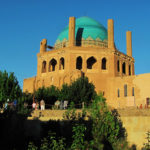
A UNESCO World Heritage site, the 14th-century Soltaniyeh Dome, also known as Mausoleum of Oljaytu is highly recognized as an architectural masterpiece particularly due to its innovative double-shelled dome and elaborate interior decoration.
The very imposing dome stands about 50 meters tall from its base. Covered with turquoise-blue faience tiles, the stunning structure dominates the skyline of Soltaniyeh, an ancient city in Zanjan province, north-western Iran.
Beyond the Ban is a group exhibition showcasing the work of leading Iranian artists based in the United States. It features painting, photography, video and prints by such luminaries as Shirin Neshat, Nicky Nodjoumi, Nahid Hagigat, Shoja Azari, Sara Issakharian, Shahram Karimi, Farshid Shafiey, Reza Java, Nazanin Noroozi, Raha Raissnia and Hossein Fatemi.
Beyond the ban will be held from 14 June to 30 August 2017 at Susan Eley Fine Art Gallery
located at 46 West 90th Street, 2nd floor, New York, NY 10024, between Central Park West and Columbus Avenue.
VOA interview with Hossein Fazeli (Persian) >>>
Asal Pahlevan interviews Jamil Kharrazi (Persian) >>>
Film Footage from the Production Team >>>
Shushma Datt TV interview in “Women in Focus” with Jamil Kharrazi 1 >>>
Shushma Datt TV interview in “Women in Focus” with Jamil Kharrazi 2 >>>
Shushma Datt TV interview in “Women in Focus” with Jamil Kharrazi 3 >>>
Shushma Datt Spice Radio interview with Jamil Kharrazi >>>
Expected Release Date: 2018
British Museum is holding a small display of works by Iranian artists until April 2, 2017 . The modern and contemporary art of Iran tells a multiplicity of stories. Made by Iranian artists of different generations, the works in this display include a variety of media from collage to artist books and photography. The narratives highlight an engagement with Iranian history from the legendary tales of the Shahnameh or Book of Kings to insights into the politics of recent decades. Between them, they present a series of vivid snapshots of the art and preoccupations of some of Iran’s most significant artists:
Bahman Mohassess, Parviz Tanavoli, Mitra Tabrizian, Parastou Forouhar, Ahmad Aali, Nahid Hagigat, Mohsen Ahmadvand, Shahpour Pouyan, Afsoon, Fereydoun Ave, Ali Akbar Sadeghi, Shideh Tami, Bahman Jalali, Ali Banisadr, Tarlan Rafiee & Yashar Samimi Mofakham. (British Museum Website)
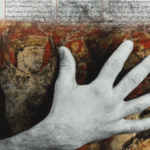
Curated by Heinz Peter Schwerfel, an Exhibition of the internationally known Iranian artist Shirin Neshat’s two new video-installations and a collection of her new photographs has been on display at Dirimart, Istanbul since 24 February 2017.
The show includes two video installations; Roja (2016) and Sara (2016) in addition to a series of new photos titled “Dreamers.” Each video revolves around single female protagonists whose emotional and psychological narratives remain on the border of dream and reality; madness and sanity; and consciousness and sub-consciousness as they each face their own distinct inner anxieties.
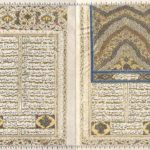
A team of Indian scholars working at the Asiatic Society, a Kolkata-based institute for Oriental studies, has stumbled upon a 700-year-old manuscript of the Divan of Hafez, the Times of India reported on Monday 7 March 2017.
The manuscript, which bears the signature and gold insignia of Shah Jahan, the fifth Mughal emperor who reigned from 1628 to 1658, also contains an unpublished ghazal. The unpublished poem begins with this verse: “Beham Dellah Ke Bazam Didane Ruyat Moyasser Shod” (Thank God, I have the honor of looking at your face again).
Situated on the ancient Silk Road stretching from Asia to Europe, the 16th-century Zeinoldin Caravansary is the only remaining dome-like caravansary of the country which received UNESCO’s best award for the restoration of historical buildings.
In earlier centuries, it was reached after a two-day camel ride from south of Yazd, about 60 kilometers on the main road to Kerman. Nowadays, while traveling by cars the sole mudbrick structure can be missed it in the blink of an eye.
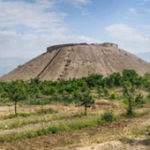
The first handmade brick has been found in the ancient Ozbaki site in Alborz province of Iran whose date goes back to 9000 years ago.
Located in Nazarabad village of Nazarabad town, Ozbaki ancient site was first identified in 1969 and registered on the list of national heritage in 1973. With a history of 9000 years, and the first handmade bricks unearthed there, Alborz region can be regarded as the cradle of human architecture. After the proposal of “Dialogue of Civilizations” put forward by the former Iranian presidents, Mohammad Khatami. one of the bricks found in this ancient region was presented to United Nations as a gift.
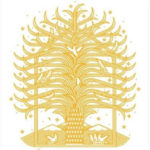
“Valderama” by Abbas Amini won the jury award for best film at the 6th Prague Iranian Film Festival, which was held in the Czech capital from 10 to 15 January 2017. The film is about 15-year-old Valderama, so called for his resemblance to the Brazilian soccer star Carlos Valderrama, who is trying to obtain the ID card he’s never had.
Asghar Farhadi’s acclaimed drama “The Salesman” won the audience award. The film is about a young couple who move into a new flat in the center of Tehran. An incident linked to the previous tenant dramatically changes their life.
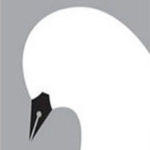
Two Iranian graphic designers have won awards at a graphic competition in the US. Posters by Mehdi Mahdian and Touraj Saberivand received awards in the poster section of ‘Graphis 2017,’ held in New York, Mehdi Mahdian’s poster shows the relationship between tradition and modernity and classic and contemporary art, while the poster by Touraj Saberivand is a symbolic combination of a dove and a pen designed to support the freedom of journalists.
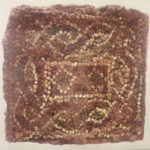
Contrary to what is believed, making mosaic did not develop first Ancient Greece or Rome, but in Ancient Iran, with its oldest specimen now preserved in the National Museum of Iran. This mosaic dating back to the third millennium BCE was unearthed in Shahdad in the Province of Kerman. It was discovered by the Iranian Archaeologist Ali Hakemi before the Islamic Revolution and taken to the National Museum. It is now on display for the occasion of the registration of the Lut Desert on the World Heritage List for a month.
The trailer for the documentary film about the life of Phoolan Devi the Indian “bandit queen” has won the 1st prize in the Indy Features in Development section of the 2016 My Hero International Film Festival. The movie is directed by Hossein Fazeli and produced by Jack Silberman with Lady Jamil Kharrazi of the Toos Foundation as the Executive Producer. The movie is to be screened in 2017.
BOSTON — In a canyon walled by drab grey and brown high-rises, a ragged line of men, women and children hold red helium balloons, ascending a staircase that ends in a spiral at an opening in the roof, where a single giant balloon slips into the blue sky. Two people at the top lift their heads in wonder. Seen by thousands of eyes a day at one of Boston’s busiest intersections, the giant outdoor mural by Iranian artist Mehdi Ghadyanloo, Stairway to Heaven, is a stunning expression of optimism he hopes can lead to better understanding between his homeland and the United States.
The 76-by-70-foot mural, painted on the side of a building across the street from South Station, appears almost three-dimensional, as if the admirer can join the line and find out what great secret awaits above.

|
“Starless Dreams” has brought director Mehrdad Oskouei more success in the international arena by winning the Pare Lorentz Award at the International Documentary Association (IDA) in Los Angles. The award recognizes films that demonstrate exemplary filmmaking while focusing on the appropriate use of the natural environment, justice for all and the illumination of pressing social problems, the IDO announced. The documentary, which has been awarded at many international events, shows the lives of seven young teenage girls sharing temporary quarters at a rehabilitation and detention center on the outskirts of Tehran.
“Starless Dreams” won the Grierson Award for the best documentary at the 60th BFI London Film Festival and the Children’s Rights Award at the 31st Osnabruck Independent Film Festival in October. |
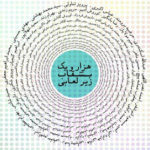
Tehran’s Shirin Gallery will be hosting a charity exhibition of underglazed ceramic plates in November, which have been painted by a number of Iranian artists. In the first phase of the project, 250 works by 250 artists are displaying their works. This is the first part of the project ‘1001 Underglazed Ceramic Plates’, in which 1001 artists will display their paintings in four different exhibits.
The charity exhibit is due to raise funds for the Children’s’ Medical Center in Tehran.
Nine projects from Iran were among the winners of the second 2A Asia Architecture Award which were announced at a ceremony in Vienna last week. The 2A Award is the most prestigious architecture prize for projects in Asia. An international jury selected 160 projects for the final round of the competition, from over 350 submissions, and awarded gold, silver and bronze prizes in a total of seven categories to 23 projects.
Organized by 2A Magazine and the Academy of Fine Arts in Vienna, the event focuses on recognizing an individual’s or group’s contribution to present-day architecture in Asia. This year’s theme was “Innovative Architecture in Asia.”
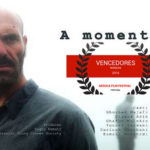
A Moment won the Best Short Film Award at the 9th Porto7, an international short film festival, in Porto, Portugal and the Reset-DoC Award for Intercultural Dialogue at the Capalbio International Film Fest in Italy. Arouca Film Festival aims to encourage filmmakers to produce more films, support and promote new films. The festival was held in fiction, animation, documentary, experimental and music-video sections.

The play is underway at Tehran’s Baran Theater Complex. It opened on September 16 and will run through September 23. The play is directed by Pino Di Buduo, the founder and director of the Potlach theater group based in Fara Sabina outside Rome. He has staged the play in 27 other countries. The hour-long play is the first international performance of Baran Theater Complex. It is spoken in Italian, with Persian captions.
At the beginning the play offers a synopsis of the current circumstances: “Upon the emergence of a monstrous creature in the water, a science professor is assigned to confront the monster that has drowned many ships and passengers.”
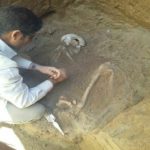
According to Ghafour Kaka, the head of exploration expedition at the site of Sarsakhti castle hill in an eponymous village in Shazand: the results of cultural findings of archaeological excavation of the area and its surrounding show it has been inhabited since Neolithic age (8000 years ago) until the Qajar Era. Based on Stratigraphic studies of 2012, the site contains relics of Neolithic, Eneolithic, Bronze and Iron Ages, Parthian, Ilkhanid, and Qajar periods. The excavations of the spring of 2016 carried out with the aim of reaching the oldest human settlement in the area led to very important neolithic and Eneolithic discoveries in a 4 in 6 meters trench. Among the most important findings were simple and decorated potteries, decorative objects, stone tools, bony flag posts, animal figurines, ceramic spindles and casting molds.

Ganji received the Best Documentary Award as well as the festival’s Trophy at the awards ceremony of the event which was held from September 5 to 11. Ganji’s 70-minute documentary is about a man called Abbas who has turned his own home to a guest house in a nomadic area of Iran. With the support of his wife and three children, he runs a successful eco-tourism business. He has an ambitious dream, which is to create a new tribe of his own and become the sovereign.
Established in 2005, Kazan International Film Festival is held in the capital city of the Republic of Tatarstan. The festival, also known as the Golden Minbar International Film Festival, is also a venue for regular meetings and an exchange of experience between filmmakers.
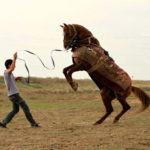
The Iranian documentary competed with 47 other documentaries and received the award. ‘Atlan’ was produced in the northeastern Iranian region of Turkaman Sahra during winter 2012, ‘Atlan’ narrates the life story of two Iranian Turkaman horse-riding instructors named Ali and Ilhan. Ali plans to get married using the money Ilhan wins in horse racing. However, things do not go as planned since Ilhan faces unpredicted circumstances and Ali has to fight for his horse’s championship. The 17th edition of the festival was held September 4-5 in Colorado, USA.
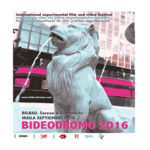
The festival will screen ‘Lost’ by Mahshid Mahboubifar, ‘Light Sight’ by Seyyed Moslem Tabatabaei on September 16, and ‘´DVLottery’ by Mohsen Zare on September 23. Mahboubifar’s ‘Lost’ narrates a loop in less than 2 minutes. In Tabatabaei’s 8-minute ‘Light Sight’, M.E. is born inside a room made of varied sized spheres and brightened by a floating light. Astonished by the light, he loses himself playing with the spheres, which now respond to the commands of his hands and his adventure begins. Zare’s 3-minute ‘´DVLottery’ is about people who have tried to win a US green card through annual online lotteries. The International Experimental Film and Video Festival, is held on September 9-26
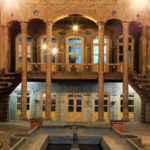
A total of 13 winning projects from six countries — Australia, China, India, Iran, Japan and Pakistan — have been recognized in this year’s Heritage Awards. A panel of international conservation experts met in Bangkok to review the 40 Heritage Awards entries, including 34 in the Conservation category and six for New Design, Mehr News Agency reported. According to UNESCO, the conservation of Darugheh House has reinstated a significant component of the historical townscape of Mashhad. Based on in-depth historical research, verified through archeological excavation, the project preserved the original building’s scale and footprint with a focus on the retention of original materials and reuse of materials from demolished adjacent buildings.
Iranian cartoonist Alireza Pakdel won the grand prix trophy Zelio Gold at the 43rd International Exhibition of Piracicaba Humor on the theme of Asylum Seekers held in Brazil, the organizers announced Saturday. He received the prize for his untitled work, which shows some European people watching a group of Middle Eastern refugees drowning in an aquarium. This work also brought Pakdel first prize in the Charge Category dedicated to works with journalistic themes.
Winners were announced during the opening ceremony of the exhibition, which will run until October 8. Pakdel’s fellow artists, Nasrin Abdosheykhi and Mojtaba Heidarpanah, were also honored at the exhibition. Abdosheykhi won the first prize in the caricature category while Heidarpanah received an honorable mention.
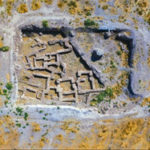
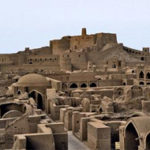
Kerman now has the highest number of sites listed on the World Herritage list. While 7000 foreign tourists visited Kerman in 2013, the number increased to 16,000 during the first five month of this year and it is predicted that it will rise to 40 to 50,000 by the end of this year.
Kerman has a great potential and it should prepare itself to host 200 to 300.000 foreign tourists each year.
Source: Tavoos
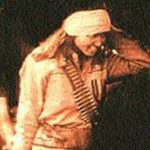
Phoolan Devi (The Bandit Queen), the Movie
This film, soon to be screened, is about a movement, voicing the pain and the injustice against women throughout the world. Phoolan was not just a woman; she was a movement. She shook India to its foundations. She did the impossible and achieved the unthinkable. That’s why she has so many followers today.
Jamil Kharrazi, the Senior Executive producer of this film says: “The legacy continues. This film is not about the past; it is about the future. And I am proud to help to introduce this movement to the world, it is just a beginning.”
Link to the people involved in the production of this film
Link to the trailer of the movie
The German Film Museum (Deutsches Filmmuseum) in Frankfurt is scheduled to host a festival of Iranian movies on June 4 and 5. “Risk of Acid Rain” directed by Behtash Sanaeiha, “Starless Dreams” by Mehrdad Oskui, “Bazaar: From Teheran to Teheran” by Reza Khanlari are among the films the museum will screen.
The festival will also show “Lanturi” and “I’m not angry”, both by promising filmmaker Reza Dormishian. According to the organizers, the museum is dedicated to the medium of film through showcasing its history, aesthetics and influence in a multitude of ways such as exhibitions and screenings in its own theater.
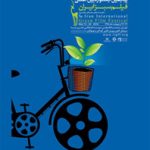
The 5th International Green Film Festival opened at Tehran’s Felestin Cinema on Friday with participants who are all concerned about the protection of the environment. A selection of 26 full-length documentaries by filmmakers from around the world will be competing in the festival this year. “Revolution” directed by Rob Stewart from Canada, “10 Billion – What’s on Your Plate?” by Valentin Thurn from Germany, “H2Omx” by José Cohen and Lorenzo Hagerman from Mexico, and “Jumbo Wild” by Nick Waggoner from the U.S. are among the submissions.
A section dedicated to short documentaries will also screen eleven films including “Paper Box” by Zbigniew Czapla from Poland and “Food For Thought, Food for Life” by Susan Rockefeller from the U.S. The festival will be running in Tehran and several other Iranian cities until May 20.
Elam Audiopedia
Faces of Ancient Middle East – Part 13 – Elamites
5000-year Old Civilization
Iran- Choghazanbil temple Khouzestan Iran Press TV
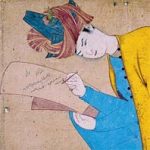
The 6th Dada Saheb Phalke Film Festival, which will open in New Delhi on April 30, is scheduled to screen a documentary, Sultan Muhammad, about one of the greatest of Persian painters and the most notable artist of the Safavid school at Tabriz during the 16th century.

Katayoon Shahabi, Iranian producer will be on the jury at the 69th Festival de Cannes presided by the Australian director, screenwriter and producer, George Miller. He will be joined by eight luminaries of world cinema, from Iran, Denmark, United States, Italia, France, Canada and Hungary. The Jury includes four women and four men. The 69th Festival de Cannes will be held from May 9-11, 2016.
Katayoon Shahabi has her own company, Noori Pictures, which had a prize winning film in Venice film festival last year.
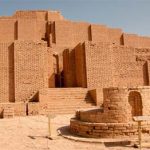
Chogha Zanbil is an ancient Elamite complex in the Khuzestan province of Iran. It is one of the few existent ziggurats outside of Mesopotamia. It lies approximately 42 km south-southeast of Dezful, 30 km south-east of Susa and 80 km north of Ahvaz.
Chogha in Bakhtiari means “hill”. Choga Zanbil means ‘basket mound.’ It was built about 1250 BC by the king Untash-Napirisha, mainly to honor the great god Inshushinak. Its original name was Dur Untash, which means ‘town of Untash’, but it is unlikely that many people, besides priests and servants, ever lived there. The complex is protected by three concentric walls which define the main areas of the ‘town’. The inner area is wholly taken up with a great ziggurat dedicated to the main god, which was built over an earlier square temple with storage rooms also built by Untash-Napirisha. The middle area holds eleven temples for lesser gods. It is believed that twenty-two temples were originally planned, but the king died before they could be finished, and his successors discontinued the building work. In the outer area are royal palaces, a funerary palace containing five subterranean royal tombs.
Although construction in the city abruptly ended after Untash-Napirisha’s death, the site was not abandoned, but continued to be occupied until it was destroyed by the Assyrian king Ashurbanipal in 640 BC. Some scholars speculate, based on the large number of temples and sanctuaries at Chogha Zanbil, that Untash-Napirisha attempted to create a new religious center (possibly intended to replace Susa) which would unite the gods of both highland and lowland Elam at one site.
The main building materials in Chogha Zanbil were mud bricks and occasionally baked bricks. The monuments were decorated with glazed baked bricks, gypsum and ornaments of faïence and glass. Ornamenting the most important buildings were thousands of baked bricks bearing inscriptions with cuneiform characters. Glazed terracotta statues such as bulls and winged griffins guarded the entrances to the ziggurat. Near the temples of Kiririsha and Hishmitik-Ruhuratir, kilns were found that were probably used for the production of baked bricks and decorative materials. It is believed that the ziggurat was built in two stages. It took its multi-layered form in the second phase.
The ziggurat is considered to be the best preserved example in the world.[according to whom?] In 1979, Chogha Zanbil became the first Iranian site to be inscribed on the UNESCO World Heritage List.>
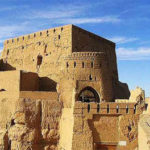
The Narin castle is a mud-brick fort or castle in the town of Meybod, in Yazd province. Structures like these constituted the government strongholds in some of the older (pre-Islamic) towns of central Iran. Some believe that these castles are descendants of ancient fire-temples. They usually have a fire temple on the top floors. The castles in Naiin and Meybod, both in Yazd province, are also called narenj castles (orange castles), possibly by folk etymology. It is said a few thousand of these castles were built in the pre-islamic period. Some of these castles incorporate mud bricks from the Medes, Achaemenid, Parthian and Sassanid periods.
The ruins of the Meybod structure stands 40 meters high from its base. It contains what seems to be a type of plumbing system (made out of a kind of mortar called sarooj) which was built into its massive walls. The structure also has a large underground chamber (filled now by rubble), possibly a prison. Four towers surround the entire compound, and a large gate furnishes access to a large courtyard. This building was built with 3 different floors, each for a different function and class of society. Although all outer gates have been destroyed the inner castle still exists. You can still see some of the outer walls. The structure seems to have been the victim of numerous earthquakes throughout the ages.
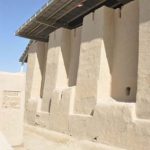
The ancient Iron Age settlement known as Tepe Nush-e Jan can be found 50 kilometers south of modern Hamadan (ancient Ecbatana). It is described as a Median town, and perhaps rightly so. However, so far, it has been impossible to identify the objects that represent the Median state. The empire of the Medes is not an archaeological fact (yet), but exists only as something mentioned by other sources such as Herodotus. A possible explanation for this discrepancy is that the Medians remained nomadic, and that Herodotus has projected aspects of the Achaemenid Empire – a real, fully developed state – backwards.
Yet, there must have been a Median civilization, and it must have looked like Tepe Nush-e Jan, which was excavated in 1967-1974 and has been made accessible more recently. The complex was erected out of mud brick and consisted of
1.a multi-storied fort with heavy walls and large store rooms;
2.several palace-like rooms, called the “old western building”;
3.a hall of 20×16 meter with twelve columns (which the excavators have playfully labeled “the apadana”);
4.a water tunnel that started in the hall;
5.a cross-shaped building that has been interpreted as a fire sanctuary – probably the oldest example of this type of building. A 14C-dating suggests that it was built in 723±220 BCE.
The buildings were erected in the second half of the eighth century and stood on a high, partly natural hill (not unlike contemporary Urartian Iron Age settlements, e.g., Çavustepe in Turkey or Bastam in NW-Iran). No traces of a village have been identified near Tepe Nush-e Jan, which confirms that the inhabitants were nomads; the building of the complex appears to have been something of an innovation. Assyrian pressure may have been the reason for building the fort.
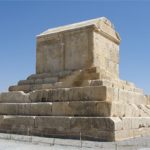
Pasargadae was the capital of the Achaemenid Empire under Cyrus the Great who had issued its construction (559–530 BC); it was also the location of his tomb. It was a city in ancient Persia, located near the city of Shiraz (in Pasargad County), and is today an archaeological site and one of Iran’s UNESCO World Heritage Sites. Cyrus began building the capital in 546 BC or later; it was unfinished when he died in battle, in 530 or 529 BC. The remains of the tomb of Cyrus’ son and successor Cambyses II have been found in Pasargadae, near the fortress of Toll-e Takht, and identified in 2006.
Pasargadae remained the capital of the Achaemenid empire until Cambyses II moved it to Susa; later, Darius founded another in Persepolis. The archaeological site covers 1.6 square kilometres and includes a structure commonly believed to be the mausoleum of Cyrus, the fortress of Toll-e Takht sitting on top of a nearby hill, and the remains of two royal palaces and gardens. Pasargadae Persian Gardens provide the earliest known example of the Persian chahar bagh, or fourfold garden design.
The design of Cyrus’ tomb is credited to Mesopotamian or Elamite ziggurats, but the cella is usually attributed to Urartu tombs of an earlier period. In particular, the tomb at Pasargadae has almost exactly the same dimensions as the tomb of Alyattes II, father of the Lydian King Croesus; however, some have refused the claim (according to Herodotus, Croesus was spared by Cyrus during the conquest of Lydia, and became a member of Cyrus’ court). The main decoration on the tomb is a rosette design over the door within the gable. In general, the art and architecture found at Pasargadae exemplified the Persian synthesis of various traditions, drawing on precedents from Elam, Babylon, Assyria, and ancient Egypt, with the addition of some Anatolian influences.
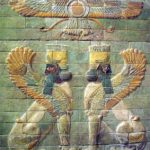
The Darius palace in Susa was built during the reign of Darius I. It is built on a mighty terrace and the design is closer to the palaces of Babylonia and Syria, with their numerous rooms, than to the Iranian residences. In a famous inscription discovered in the room that is known as the King’s Hall, he describes how all nations of his empire contributed to the building:
The cedar timber, this was brought from a mountain named Lebanon. The Assyrian people brought it to Babylon; from Babylon the Carians and the Yaun (Greeks) brought it to Susa. The yak-timber was brought from Gandara and from Carmania. The gold was brought from Lydia and from Bactria, which here was wrought. The precious stone lapis lazuli and carnelian which was wrought here, this was brought from Sogdia. The precious stone turquoise, this was brought from Chorasmia, which was wrought here. The silver and the ebony were brought from Egypt. The ornamentation with which the wall was adorned, that from Yaun was brought. The ivory which was wrought here, was brought from Kush and from India and from Arachosia. The stone columns which were here wrought, a village named Abiradu, in Elam – from there were brought. The stone-cutters who wrought the stone, those were Yaun and Lydians. The goldsmiths who wrought the gold, those were Medes and Egyptians. The men who wrought the wood, those were Lydians and Egyptians. The men who wrought the baked brick, those were Babylonians. The men who adorned the wall, those were Medes and Egyptians
The palace and its Apadana were destroyed by fire during the reign of Artaxerxes I (465-424/423). Inscriptions proves that he almost finished restoring the palace; the apadana took longer and was not finished until the reign of his grandson Artaxerxes II Mnemon (404-358).
The palace was usually entered from the east, where the visitors were welcomed at the Great Gate. Moving to the west, guests would pass along three or four courts. The Third Court was the largest: was larger than two first courts. It may have been used for military exercises. The Second Court is now easy to recognize because it looks much deeper than the other courts. The most famous building at Susa is probably the Apadana, the audience hall of the Palace of Darius. It was accessible from the south through the second and third courts. The hall measured 109×109 meter and had thirty-six large columns to support the roof. Three times twelve columns supported the roof of the porticos to the west, north, and east sides of the building. The apadana of Susa is larger than its counterpart in Persepolis.
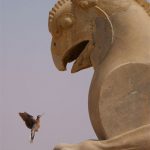
As with many places and people, the ancient capital of the Achaemenian kings of Persia is known to us by it’s Greek name “Persepolis” meaning Persian City. The Persians themselves called it “Parsa” meaning the city of Persians. The remains of Persepolis are located in the Fars region of what is now southwestern Iran.. The Iranians call it “takht-e-jamshid” (the throne of Jamshid).
Construction of the city was begun under Darius I (Darius the Great – reigned 522–486 B.C.). Persepolis was built in a remote and mountainous region which was quite inconvenient, making its function as the royal residence and seat of power, somewhat strange. Administration of the Achaemenian Empire was likely still carried on from the traditional power centers of Susa, Babylon, and Ecbatana.
Upon the defeat of the Persian Empire by the Macedonian King Alexander the Great in 330 B.C. Persepolis was plundered, and the palace of the then Persian King Xerxes, was burned. According to one legend, it was Thais, a Athenian courtesan who traveled with the army of Alexander, that supposedly persuaded Alexander to set fire to the Achaemenian Palace. In another version, the fire was started when a drunken Thais led a revel that got out of hand. In any event, years later Persepolis was still the capital of Persia, but now as a province of the Macedonian empire. The city gradually declined, and then fell to ruin after the Seleucid period.
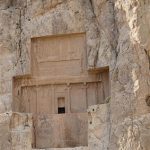
Naqsh-e Rustam) “Rustam Relief”) is an ancient necropolis located about 12 km northwest of Persepolis, in Fars Province, Iran, with a group of ancient Iranian rock reliefs cut into the cliff, from both the Achaemenid and Sassanid periods. It lies a few hundred meters from Naqsh-e Rajab, with a further group of Sassanid reliefs.
The oldest relief at Naqsh-e Rustam dates back to c. 1000 BC. Though it is severely damaged, it depicts a faint image of a man with unusual head-gear, and is thought to be Elamite in origin. The depiction is part of a larger mural, most of which was removed at the command of Bahram II. The man with the unusual cap gives the site its name, Naqsh-e Rustam (“Rustam Relief”), because the relief was locally believed to be a depiction of the mythical hero Rustam.
Four tombs belonging to Achaemenid kings are carved out of the rock face at a considerable height above the ground. The tombs are locally known as the Persian crosses, after the shape of the facades of the tombs. The entrance to each tomb is at the center of each cross, which opens onto to a small chamber, where the king lay in a sarcophagus. The horizontal beam of each of the tomb’s facades is believed to be a replica of a Persepolitan entrance.
One of the tombs is explicitly identified, by an accompanying inscription, as the tomb of Darius I (c. 522-486 BC). The other three tombs are believed to be those of Xerxes I (c. 486-465 BC), Artaxerxes I (c. 465-424 BC), and Darius II (c. 423-404 BC) respectively. The order of the tombs in Naqsh-e Rustam follows (left to right): Darius II, Artaxerxes I, Darius I, Xerxes I.
A fifth unfinished one might be that of Artaxerxes III, but is more likely that of Darius III (c. 336-330 BC), the last king of the Achaemenid Dynasts. The tombs were looted following the conquest of the Achaemenid Empire by Alexander the Great.
Seven over-lifesized rock reliefs at Naqsh-e Rustam depict monarchs of the Sassanid period.
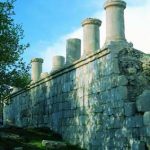
The Anahita Temple is the name of one of two archaeological sites in Iran popularly thought to have been attributed to the ancient deity Anahita. The larger and more widely known of the two is located at Kangāvar in Kermanshah Province. The other is located at Bishapur.
The remains at Kangavar reveal an edifice that is Hellenistic in character, and yet display Persian architectural designs. The plinth’s enormous dimensions for example, which measure just over 200m on a side, and its megalithic foundations, which echo Achaemenid stone platforms, “constitute Persian elements”. This is thought to be corroborated by the “two lateral stairways that ascend the massive stone platform recalling Achaemenid traditions”, particularly that of the Apadana Palace at Persepolis.
Another Iranian construction with Hellenistic characteristics is the Khurra mausoleum in Markazi Province.
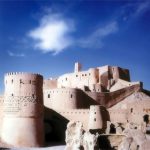
The Bam Citadel. or Arg-e Bam was the largest adobe building in the world, located in Bam, a city in the Kermān Province of south eastern Iran. It is listed by UNESCO as part of the World Heritage Site “Bam and its Cultural Landscape”. The origin of this enormous citadel on the Silk Road can be traced back to the Achaemenid period (6th to 4th centuries BC) and even beyond. The heyday of the citadel was from the 7th to 11th centuries, being at the crossroads of important trade routes and known for the production of silk and cotton garments. The entire building was a large fortress in whose heart the citadel itself was located, but because of the impressive look of the citadel, which forms the highest point, the entire fortress is named the Bam Citadel.
On December 26, 2003, the Citadel was almost completely destroyed by an earthquake, along with much of the rest of Bam and its environs. Larger than nearby Arg-é Rayen, the area of Bam Citadel is approximately 180,000 square meters (44 acres), and it is surrounded by gigantic walls 6–7 metres (20–23 ft) high and 1,815 metres (5,955 ft) long. The citadel features two of the “stay-awake towers” for which Bam is famed – there are as many as 67 such towers scattered across the ancient city of Bam.
The planning and architecture of the citadel are thought out from different points of view. From the present form of the citadel one can see that the planner(s) had foreseen the entire final form of the building and city from the first steps in the planning process. During each phase of building development the already-built part enjoyed a complete figure, and each additional part could be “sewn” into the existing section seamlessly.
All buildings are made of non-baked clay bricks, i.e. adobes. Bam Citadel was probably, prior to the 2003 earthquake, the biggest adobe structure in the world. The Citadel was used as the major location site for Valerio Zurlini’s film of The Desert of the Tartars.
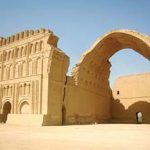
Taq Kasra is a Sassanid-era Persian monument located near the modern town of Salman Pak, Iraq. It is the only visible remaining structure of the ancient city of Ctesiphon. The archway is the largest single-span vault of unreinforced brickwork in the world.
The exact time of construction is not known with certainty. Construction possibly began during the reign of Khosrau I after a campaign against the Byzantines in 540 AD. The arched iwan hall, open on the facade side, was about 37 meters high 26 meters across and 50 meters long, the largest man-made, free standing vault constructed until modern times.
The arch was part of the imperial palace complex. The throne room—presumably under or behind the arch—was more than 30 m high and covered an area 24 m wide by 48 m long. The top of the arch is about 1 meter thick while the walls at the base are up to 7 meters thick. It is the largest vault ever constructed in the world. The catenary arch was built without centring. In order to make this possible a number of techniques were used. The bricks were laid about 18 degrees from the vertical which allowed them to be partially supported by the rear wall during construction. The quick drying cement used as mortar allowed the fresh bricks to be quickly supported by those that were previously laid.
The Taq Kasra is now all that remains above ground of a city that was, for seven centuries—from the 2nd century BC to the 7th century AD—the main capital of the Iranian successor dynasties of the Parthians and Sassanids. The structure left today was the main portico of the audience hall of the Sassanids who maintained the same site chosen by the Parthians and for the same reason, namely proximity to the Roman Empire, whose expansionist aims could be better contained at the point of contact. The structure was captured by the Arabs in AD 637. They then used it as a mosque for a while until the area was gradually abandoned.
The monument was in the process of being rebuilt by Saddam Hussein’s government in the course of the 1980s, when the fallen northern wing was partially rebuilt. All works, however, stopped after the 1991 Gulf War. The current Iraqi government is cooperating with the University of Chicago’s “Diyala Project” to restore the site.
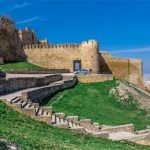
UNESCO’s classified the Derbent fortress as a World Heritage. The current fortification and walls were built by the Persian Sassanian Empire as a defensive structure against hostile nomadic people in the north, and continuously repaired or improved by later Arab, Mongol, Timurid, Shirvan and Iranian kingdoms until the early course of the 19th century, as long as its military function lasted. The fortress was built under direction of the Sassanid emperor Khosrow I.
A large portion of the walls and several watchtowers still remain in reasonable shape. The walls, reaching to the sea, date from the 6th century, Sassanid dynasty period. The city has a well-preserved citadel (Narin-kala), enclosing an area of 4.5 hectares (11 acres), enclosed by strong walls. Historical attractions include the baths, the cisterns, the old cemeteries, the caravanserai, the 18th-century Khan’s mausoleum, as well as several mosques. The oldest mosque is the Juma Mosque, built over a 6th-century Christian basilica; it has a 15th-century madrassa. Other shrines include the 17th-century Kyrhlyar mosque, the Bala mosque and the 18th-century Chertebe mosque.
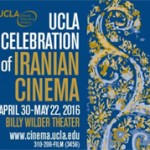
The UCLA Celebration of Iranian Cinema will be held at the Billy Wilder Theater from April 30 to May 22. A lineup of movies, including “Dolls Don’t Know” directed by Nava Rezvani, “Two” by Soheila Golestani, “The Sale” by Hossein Shahabi, “Time to Love” by Alireza Raissian and “Risk of Acid Rain” by Behtash Sanaeiha, will be screened during the celebration.
The event is organized annually by the UCLA Film and Television Archive, which has showcased the ever-unfolding film tradition of Iran for southern California audiences over the past two decades.
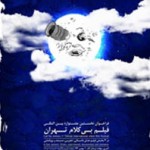
Tehran will be playing host to its first festival of silent films, which is scheduled to be held from April 30 to May 7. Forty-five fiction, animated and documentary films will be screened at the festival, which will be held at the Tehran University of Art.
“Hunter” by Scott Barley from Wales, “Trilogy of Silence” by Diego Fiori from Austria, “Displacement” by Manuel Álvarez-Diestro from England and “Chamber Music” by Katharina Blanken from Germany are among the films. The films have been selected from among over 800 submissions from around the world. The Experimental and Documentary Film Center and the Tehran University of Art festival are the main sponsors of the event.
An exhibition underway at the Photo Club Gallery (Fotokluba) in Zagreb is displaying photos of Iran by Croatian photographer Pavao Toth. The exhibition entitled “Iran, Persia, the People” focuses on historical sites, ordinary people of Iran and their lives. Toth took the photos during his several journeys to Iran over the past few years. His interest in the ancient land of Iran, its civilization, traditions and people have always encouraged him to travel to Iran and take more photos and produce additional albums.
The exhibition, which opened on April 5, will be running until April 22.
A retrospective of works by Iranian filmmaker Abbas Kiarostami will be held at the Centro Cultural Banco do Brasil (CCBB) in Rio de Janeiro from April 13 until May 9, the Rio Times reported on Friday. His 1970 short “The Bread and Alley”, which is his debut film, will be shown during the retrospective. In addition, “Taste of Cherry” (1997), which won the Cannes Film Festival’s Palme d’Or, “The Wind Will Carry Us” (1999), which received the Grand Special Jury Prize at the Venice Film Festival, and his most recent film “Like Someone in Love” (2012) are among the films selected for the program.
The retrospective also will be held at the CCBB branch in São Paulo from April 20 to May 9 and at the CCBB branch Brasilia from May 4 to 23.
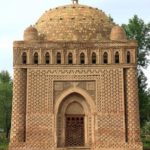
The Samanid mausoleum is located in a park just outside the historic urban center of Bukhara, Uzbekistan. The mausoleum is considered to be one of the most highly esteemed work of Central Asian architecture, and was built between 892 and 943 CE as the resting-place of Ismail Samani – a powerful and influential amir of the Samanid dynasty, one of the last native Persian dynasties that ruled in Central Asia in the 9th and 10th centuries, after the Samanids established virtual independence from the Abbasid Caliphate.
The fact that the religious law of orthodox Sunni Islam strictly prohibits the construction of mausoleums over burial places stresses the significance of the Samanid mausoleum, which is the most ancient monument of Islamic architecture in Central Asia and the sole monument that survived from the epoch of the Samanid Dynasty. The Samanid mausoleum might be one of the earliest departures from that orthodox religious restriction in the history of Islamic architecture.
The monument marks a new era in the development of Persian and Central Asian architecture, which was revived after the Arab conquest of the region. The overall structure is made similar to ancient persian fire temples, commonly known as chartaqi in Persian. The architects continued to use an ancient tradition of baked brick construction, but to a much higher standard than had been seen before. The site is unique for its architectural style which combines both Zoroastrian motifs from the native Sogdian and Sassanid cultures, as well as Islamic motifs introduced from Arabia and Persia.
Amir Reza Koohestani’s drama piece “Hearing” will be staged in several European cities in the upcoming months. The play will first go on stage in Berlin (April 13 and 14) and From June 11-15, at the Brussels Theater Festival in Belgium. From July 21-24, the play will be going on stage in Torino, Italy.
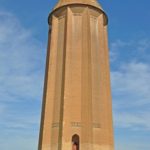
Gonbad-e Qabus tower is a monument in Gonbad-e Qabus, Iran, and a UNESCO World Heritage Site since 2012. The Tower in the central part of the city reaches 72 metres (236 ft). The baked-brick-built tower is an enormous decagon building with a conic roof, which forms the golden ratio Phi, that equals 1.618. The interiors contain the earliest examples of Muqarnas decorative styles. The decagon with its 3 meter-thick wall, divided into 10 sides, has a diameter of 17 m. The Tower was built on such a scientific and architectural design that at the front of the Tower, at an external circle, one can hear one’s echo.
The tower was built in 1006 AD on the orders of the Ziyarid Amir Shams ol-Ma’āli Qabus ibn Wushmgir. It is located 3 km north of the ancient city of Gorgan, from where the Ziyarid dynasty ruled. A Kufic inscription at the bottom of the tower reads in Arabic: “This tall palace for the prince Shams ul-Ma’ali, Amir Qabus ibn Wushmgir ordered to build during his life, in the year 397 the lunar Hegira, and the year 375 the solar Hegira”
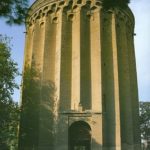
Tuğrul Tower (also transliterated Toghrul, Tughrol, or Tughrul) is a 12th-century monument, located in the city of Rey, Iran. Tuğrul Tower is near Rashkan Castle. The 20 meters tall brick tower is the tomb of Seljuk ruler Tuğrul Beg, who died in Rey in 1063. Originally, like other monuments of its time, it was capped by a conical dome, which collapsed during an earthquake.
The thickness of the walls varies from 1.75 to 2.75 meters. The inner and outer diameters are 11 and 16 meters, respectively. The exterior shape is that of a polygon with 24 angles in its design, which is thought to contribute to the structure’s stability against tremors.
At the top of the tower Kufic inscriptions were originally observable. Naser al-Din Shah ordered some restorations to be made to the top part of the tower, which was collapsing in 1884. The tower is protected by Iran’s Cultural Heritage Organization
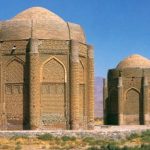
The Kharraqan towers are mausoleums, built in 1067 and 1093, located on the plains in northern Iran, near Qazvin.
The brick structures stand 15 metres (49 ft) tall and 4 metres (13 ft) wide, and make extensive use of geometry. Inside the older mausoleum there is a lamp and paintings.
The eastern tower dates from 1067–68, while the western tower dates from 1093. Both towers appear to be the work of the architect, Muhammad bin Makki al-Zanjani. It is believed that the occupant of the eastern tower was Abu Sa’id Bijar and the occupant of the western tower was Abu Mansur Iltayti.
These towers are remnant examples of architecture that existed during the Seljuk period of medieval Persia.
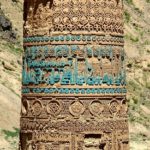
The Minaret of Jam is a UNESCO World Heritage Site in western Afghanistan. It is located in a remote and nearly inaccessible region of the Shahrak District, Ghor Province, next to the Hari River. The 62-metre (203 ft) high minaret was built around 1190 entirely of baked bricks and is famous for its intricate brick, stucco and glazed tile decoration, which consists of alternating bands of kufic and naskhi calligraphy, geometric patterns, and verses from the Qur’an. As of 2013 the minaret remained on the list of World Heritage in Danger, under serious threat of erosion, and was not actively being preserved.
The circular minaret rests on an octagonal base; it had 2 wooden balconies and was topped by a lantern. Its formal presentation has a striking similarity to the minaret built by Masud III in Ghazni. It is thought to have been a direct inspiration for the Qutub Minar in Delhi, India, which was also built by the Ghurid Dynasty. After the Qutub Minar, the Minaret of Jam is the second-tallest brick minaret in the world.
The Minaret of Jam belongs to a group of around 60 minarets and towers built between the 11th and the 13th centuries in Central Asia, Iran and Afghanistan, including the Kutlug Timur Minaret in Old Urgench (long considered the tallest of these still in existence) to the tower at Ghazni. The minarets are thought to have been built as symbols of Islam’s victory, while other towers were simply landmarks or watchtowers.
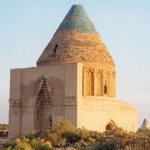
This structure is the presumed Tomb of Sultan Ala al-din Tekesh, the founder of the Khwarezm Empire and its ruler between 1172-1200.
The building is made of bricks and consists of a square hall with walls which are 11,45 meters high, a massive round drum and a conical roof with an inner dome hidden under it. The dome is connected to the square walls it rests upon by an octagonal belt. The structure between the dome and the octagon is decorated with 16 shallow niches. Their form is not lancet-like as those commonly found in the Islamic architecture of Central Asia, but rather semicircular. This is a motif that can be found in the marble 8th-century mihrab at the Baghdad Museum, and has seldom been used in Central Asia: another comparable case that can be found in Turkmenistan is that of the mihrab of Muhammad Ibn Zayd’s 11th-century mosque, from Merv. However, the two are located too far away to be considered prototypes.
The external conical roof is built of horizontal layers using the technique of a false vault. From the inside, it is strengthened with 12 buttresses standing upon the internal dome. Although this might seem like a risky construction technique, the roof is not in bad condition: only the top is destroyed, and the blue majolica[disambiguation needed] decoration slightly damaged. One of the special features of the building’s architecture is its façade. It presents a high portal niche with the main archway, which has now lost its original form. Interestingly, the lancet arch of the portal is filled by a complicated system of stalactite -like forms, which is a decorative motif made of terracotta and fixed on wooden sticks within the brickwork.
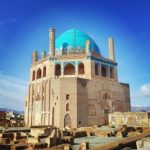
The central magnet of Soltaniyeh’s several ruins is the Mausoleum of Il-khan Öljeitü also known as Muhammad Khodabandeh, traditionally known as the Dome of Soltaniyeh in Soltaniyeh city, Zanjan Province.
The structure, erected from 1302 to 1312 AD, has the oldest double-shell dome in Iran This erroneous view of the construction was made by Dieulafoy but is totally disputed by Andre Godard. In Godard’s view it is a normal, if spectacularly large dome, with a thin skin on top for the faience and is in no way a double dome. Its importance in the Muslim world may be compared to that of Brunelleschi’s cupola for Christian architecture. It is one of the largest brick domes in the world, just at the theoretical engineering limit for a brick dome and the third largest dome in the world after the domes of Florence Cathedral and Hagia Sophia. The Dome of Soltaniyeh paved the way for more daring Iranian-style cupola constructions in the Muslim world, such as the Mausoleum of Khoja Ahmed Yasavi and the Taj Mahal. Much of its exterior decoration has been lost, but the interior retains superb mosaics, faience, and murals. People have described the architecture of the building as “anticipating the Taj Mahal.”
The estimated 200 ton dome stands 49 meters (161 ft) tall from its base, and is currently undergoing extensive renovation
The Salar Jung Museum in Heidar Abad, India, opens a new permanent exhibition on Iranian art. According to the Museum specialists, Mr. Jung left behind close to 50,000 art pieces a great number of which are from Iran. The Museum has finally organized all these pieces into a cohesive collection to be presented in the new Gallery on Iranian Art.
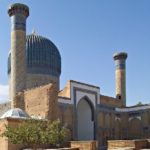
The Gūr-i Amīr is Persian for “Tomb of the King”. It is a mausoleum of the Asian conqueror Timur (also known as Tamerlane) in Samarkand, Uzbekistan. It occupies an important place in the history of Persian-Mongolian Architecture as the precursor and model for later great Mughal architecture tombs, including Gardens of Babur in Kabul, Humayun’s Tomb in Delhi and the Taj Mahal in Agra, built by Timur’s Persianised descendants, the ruling Mughal dynasty of North India. It has been heavily restored. This architectural complex with its azure dome contains the tombs of Tamerlane, his sons Shah Rukh and Miran Shah and grandsons Ulugh Beg and Muhammad Sultan. Also honoured with a place in the tomb is Timur’s teacher Sayyid Baraka.
The earliest part of the complex was built at the end of the 14th century by the orders of Muhammad Sultan. Now only the foundations of the madrasah and khanaka, the entrance portal and a part of one of four minarets remains. The construction of the mausoleum itself began in 1403 after the sudden death of Muhammad Sultan, Tamerlane’s heir apparent and his beloved grandson, for whom it was intended. Timur had built himself a smaller tomb in Shahrisabz near his Ak-Saray palace. However, when Timur died in 1405 on campaign on his military expedition to China, the passes to Shahrisabz were snowed in, so he was buried here instead. Ulugh Beg, another grandson of Tamerlane, completed the work. During his reign the mausoleum became the family crypt of the Timurid Dynasty.
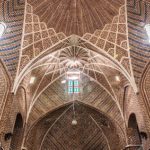
The Bazaar of Tabriz is a historical market situated in the city center of Tabriz, Iran. It is one of the oldest bazaars in the Middle East and the largest covered bazaar in the world and is one of Iran’s UNESCO World Heritage Sites. Tabriz has been a place of cultural exchange since antiquity. Its historic bazaar complex is one of the most important commercial centres on the Silk Road. A bazaar has existed on the same site since the early periods of Iranian urbanism following Islam.
Located in the center of the city of Tabriz, Iran, the structure consists of several sub-bazaars, such as Amir Bazaar (for gold and jewelry), Mozzafarieh (a carpet bazaar, sorted by knot size and type), shoe bazaar, and many other ones for various goods such as household items. The most prosperous time of Tabriz and its bazaar was in the 16th century when the town became the capital city of the Safavid kingdom. The city lost its status as a capital in the 17th century, but its bazaar has remained important as a commercial and economic center. Although numerous modern shops and malls have been established nowadays, Tabriz Bazaar has remained the economic heart of both the city and northwestern Iran.
In 2000, the Historical Hermitages Organization of Iran begin a restoration project of the Bazaar, with the full participation of the shop owners. The rehabilitation project won the Aga Khan Award for Architecture in 2013.
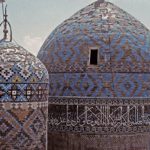
Sheikh Safi al-Din Khānegāh and Shrine Ensemble is the tomb of Sheikh Safi-ad-din Ardabili located in Ardabil, Iran. In 2010, it was registered on the UNESCO World Heritage List.
Sheikh Safi, a leader of an Islamic Sufi order established by the Safavids, was born in Ardabil. The Safavids valued the tomb-mosque form, and the tomb with its mausoleum and prayer hall is located at a right angle to the mosque. The buildings in the complex surround a small inner courtyard (31 by 16 meters). The complex is entered through a long garden. The Mausoleum was first built by his son Sheikh Sadr al-Dīn Mūsā, after Sheikh Safi’s death in 1334. It was constructed between the beginning of the 16th century and the end of the 18th century. The mausoleum, a tall, domed circular tower decorated with blue tile and about 17 meters in height; beside it is the 17th-century Porcelain House preserving the sanctuary’s ceremonial wares. Also part of the complex are many sections that have served a variety of functions over the past centuries, including a library, a mosque, a school, mausolea, a cistern, a hospital, kitchens, a bakery, and some offices. It incorporates a route to reach the shrine of the sheikh divided into seven segments, which mirror the seven stages of Sufi mysticism. Various parts of the mausoleum are separated by eight gates, which represent the eight attitudes of Sufism. Several parts were gradually added to the main structure during the Safavid dynasty. A number of Safavid sheikhs and harems and victims of the Safavids’ battles, including the Battle of Chaldiran, have been buried at the site.
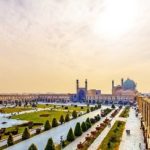
Naqsh-e Jahan Square (trans: “Image of the World Square”), is a square situated at the center of Isfahan city, Iran. Constructed between 1598 and 1629, it is now an important historical site, and one of UNESCO’s World Heritage Sites. It is 160 metres (520 ft) wide by 560 metres (1,840 ft) long (an area of 89,600 square metres (964,000 sq ft)). It is also referred to as Shah Square or Imam Square. It is surrounded by buildings from the Safavid era. The Shah Mosque is situated on the south side of this square. On the west side is the Ali Qapu Palace. Sheikh Lotf Allah Mosque is situated on the eastern side of this square and at the northern side Keisaria gate opens into the Isfahan Grand Bazaar.
In 1598, when Shah Abbas decided to move the capital of his rule from the north-western city of Qazvin to the central city of Isfahan, he initiated the complete remaking of the city. The chief architect of this colossal task of urban planning was Shaykh Bahai (Baha’ ad-Din al-`Amili), who focused the programme on two key features of Shah Abbas’s master plan: the Chahar Bagh avenue, flanked at either side by all the prominent institutions of the city, such as the residences of all foreign dignitaries, and the Naqsh-e Jahan Square. The ingenuity of the square, or Maidān, was that, by building it, Shah Abbas would gather the three main components of power in Persia in his own backyard; the power of the clergy, represented by the Masjed-e Shah, the power of the merchants, represented by the Imperial Bazaar, and of course, the power of the Shah himself, residing in the Ali Qapu Palace.
Many historians have wondered about the peculiar orientation of the maidān which does not lie in alignment with Mecca. There maybe an explanation to this; the vision of Shaykh Bahai was for the mosque to be visible wherever in the maydān a person was situated. Had the axis of the maydān coincided with the axis of Mecca, the dome of the mosque would have been concealed from view by the towering entrance-portal leading to it. By creating an angle between them, the two parts of the building, the entrance-portal and the dome, are in perfect view for everyone within the square to admire.
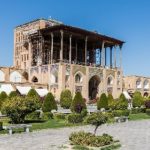
Ali Qapu is a grand palace in Isfahan, Iran. It is located on the western side of the Naqsh e Jahan Square, opposite to Sheikh Lotfollah Mosque, and had been originally designed as a vast portal. It is forty-eight meters high and there are six floors, each accessible by a spiral staircase. In the sixth floor, Music Hall, deep circular niches are found in the walls, having not only aesthetic value, but also acoustic.
Fresco from the portico of the palace, depicting a Persian woman
The name Ali Qapu, from Arabic “Ālī” (meaning “imperial” or “great”), and Turkic “Qāpū” (meaning “gate”), was given to this place as it was right at the entrance to the Safavid palaces which stretched from the Naqsh e Jahan Square to the Chahar Baq Boulevard. The building, another wonderful Safavid edifice, was built by decree of Shah Abbas I in the early seventeenth century. Shah Abbas, here for the first time, celebrated the Nowruz (Iranian New Year) of 1006 AH / 1597 C.E.
Ali Qapu is rich in naturalistic wall paintings by Reza Abbasi, the court painter of Shah Abbas I, and his pupils. There are floral, animal, and bird motifs in his works. The highly ornamented doors and windows of the palace have almost all been pillaged. Only one window on the third floor has escaped the ravages of time. Ali Qapu was repaired and restored substantially during the reign of Shah Sultan Hussein, the last Safavid ruler, but fell into a dreadful state of dilapidation again during the short reign of invading Afghans.
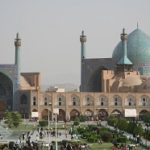
The Shah Mosque, also known as Jaame’ Abbasi Mosque or Imam Mosque after the Iranian revolution of 1979, is a mosque in Isfahan, Iran, standing in the south side of Naghsh-e Jahan Square. Built during the Safavid Empire, ordered by Shah Abbas I. It is regarded as one of the masterpieces of Iranian architecture and an excellent example of Islamic era architecture of Iran. It is registered, along with the Naghsh-e Jahan Square, as a UNESCO World Heritage Site. Its construction began in 1611, and its splendor is mainly due to the beauty of its seven-colour mosaic tiles and calligraphic inscriptions.
In 1598, when Shah Abbas decided to move the capital of his Persian empire from the northwestern city of Qazvin to the central city of Isfahan, he initiated what would become one of the greatest programmes in Persian history; the complete remaking of this ancient city. By choosing the central city of Isfahan, fertilized by the Zāyandeh River (“The life-giving river”), lying as an oasis of intense cultivation in the midst of a vast area of arid landscape, he both distanced his capital from any future assaults by Iran’s neighboring arch rival, the Ottomans, and at the same time gained more control over the Persian Gulf, which had recently become an important trading route for the Dutch and British East India Companies.
The chief architect of this colossal task of urban planning was Shaykh Bahai (Baha’ ad-Din al-`Amili), who focused the programme on two key features of Shah Abbas’s master plan: the Chahar Bagh avenue, flanked at either side by all the prominent institutions of the city, such as the residences of all foreign dignitaries, and the Naqsh-e Jahan Square (“Exemplar of the World”). The ingenuity of the square, or Maidān, was that, by building it, Shah Abbas would gather the three main components of power in Persia in his own backyard; the power of the clergy, represented by the Masjed-e Shah, the power of the merchants, represented by the The Imperial Bazaar, and of course, the power of the Shah himself, residing in the Ali Qapu Palace.
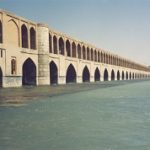
Allāhverdi Khan Bridge popularly known as Si-o-seh pol (“The bridge of thirty-three spans”) is one of eleven bridges in Isfahan and the longest bridge on the Zayandeh River with the total length of 297.76 metres (976.9 ft). It is one of the most famous examples of Safavid bridge design.
Built in 1599–1602, the construction was financed and supervised by Allahverdi Khan Undiladze, chancellor of Shah Abbas I, an ethnic Georgian. It consists of two superimposed rows of 33 arches. There is a larger base plank at the start of the bridge where the Zayandeh River flows under it. This supports a tea house which nowadays is abandoned due to drought which some claim is due to government mismanagement.
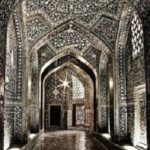
Sheikh Lotfollah Mosque is one of the masterpieces of Iranian architecture that was built during the Safavid Empire, standing on the eastern side of Naghsh-i Jahan Square, Esfahan, Iran. Construction of the mosque started in 1603 and was finished in 1619. It was built by the chief architect Shaykh Bahai, during the reign of Shah Abbas I of Persia. Reza Shah Pahlavi ordered to rebuild and repair the mosque in 1920s. Of the four monuments that dominated the perimeter of the Naqsh-e Jahan Square, this one was the first to be built.
The purpose of this mosque was for it to be a private mosque of the royal court, unlike the Shah Mosque, which was meant for the public. For this reason, the mosque does not have any minarets and is of a smaller size. Indeed, few Westerners at the time of the Safavids even paid any attention to this mosque, and they certainly did not have access to it. It wasn’t until centuries later, when the doors were opened to the public, that ordinary people could admire the effort that Shah Abbas had put into making this a sacred place for the ladies of his harem, and the exquisite tile- work, which is far superior to those covering the Shah Mosque. To avoid having to walk across the Square when getting to the mosque, Shah Abbas had the architect build a tunnel spanning across the piazza, from the Ali Qapu Palace, to the mosque.
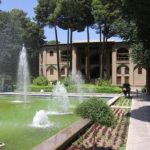
Hasht Behesht meaning “Eight Paradises” is a Safavid era palace in Isfahan, Iran.
It was built in 1669 and is today protected by Iran’s Cultural Heritage Organization. Of more than forty mansions which existed in Isfahan during the rule of Safavids, this is the only one left today.
In architecture Hasht-Behesht refers to a specific type of floorplan common in Persian architecture whereby the plan is divided into 8 chambers surrounding a central room. The eight divisions and frequent octagonal forms of such structures represent the eight levels of paradise for Muslims.
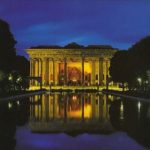
Chehel Sotoun is a pavilion in the middle of a park at the far end of a long pool, in Isfahan, Iran, built by Shah Abbas II to be used for his entertainment and receptions. In this palace, Shah Abbas II and his successors would receive dignitaries and ambassadors, either on the terrace or in one of the stately reception halls. The name, meaning “Forty Columns” in Persian, was inspired by the twenty slender wooden columns supporting the entrance pavilion, which, when reflected in the waters of the fountain, are said to appear to be forty.
As with Ali Qapu, the palace contains many frescoes and paintings on ceramic. Many of the ceramic panels have been dispersed and are now in the possession of major museums in the west. They depict specific historical scenes such as the infamous Battle of Chaldiran against the Ottoman Sultan Selim I, the reception of an Uzbek King in 1646, when the palace had just been completed; the welcome extended to the Mughal Emperor, Humayun who took refuge in Iran in 1544; the battle of Taher-Abad in 1510 where the Safavid Shah Ismail I vanquished and killed the Uzbek King. A more recent painting depicts Nader Shah’s victory against the Indian Army at Karnal in 1739. There are also less historical, but even more aesthetic compositions in the traditional miniature style which celebrate the joy of life and love.
The Chehel Sotoun Palace is among the 9 Iranian Gardens which are collectively registered as one of the Iran’s 21 registered World Heritage Sites under the name of the Persian Garden.
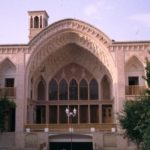
The Āmeri House is a historic house in Kashan, in Isfahan Province, in Iran. It was built during the Zand era for Āghā ‘Āmeri, the governor of Kashan, who was responsible for maintaining the security of the route between Tehran and Kerman.
Covering an area of 9,000 square metres (97,000 sq ft), and housing seven courtyards, the Āmeri house is one of several large spectacular old houses in the central district of Kashan. Like the other houses around it, it was rebuilt in the 19th century, after the city was ravaged by a series of massive earthquakes in the 18th century.
The house is now a public museum, and is protected by Iran’s Cultural Heritage Organization.
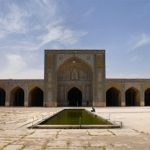
The Vakil Mosque is a mosque in Shiraz, southern Iran, situated to the west of the Vakil Bazaar next to its entrance. This mosque was built between 1751 and 1773, during the Zand period; however, it was restored in the 19th century during the Qajar period. Vakil means regent, which was the title used by Karim Khan, the founder of Zand Dynasty. Shiraz was the seat of Karim Khan’s government and he endowed many buildings, including this mosque.
Vakil Mosque covers an area of 8,660 square meters. It has only two iwans instead of the usual four, on the northern and southern sides of a large open court. The iwans and court are decorated with typical Shirazi haft rangi tiles, a characteristic feature of the art and industry of Shiraz during the latter half of the 18th century. Its night prayer hall (Shabestan), with an area of approximately 2,700 square meters, contains 48 monolithic pillars carved in spirals, each with a capital of acanthus leaves. The minbar in this hall is cut from a solid piece of green marble with a flight of 14 steps and is considered to be one of the master pieces of the Zand period. The exuberant floral decorative tiles largely date from the Qajar period.
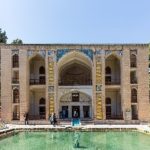
Fin Garden located in Kashan, Iran, is a historical Persian garden. It contains Kashan’s Fin Bath, where Amir Kabir, the Qajarid chancellor, was murdered by an assassin sent by King Nasereddin Shah in 1852. Completed in 1590, the Fin Garden is the oldest extant garden in Iran. The settlements of the garden in its present form was built under the reign of Abbas I of Persia (1571-1629), as a traditional bagh near the village of Fin, located a few kilometres southwest of Kashan. The garden was developed further during the Safavid dynasty, until Abbas II of Persia (1633-1666). It was highly recognized during the reign of Fat′h Ali Shah Qajar and was considerably expanded.Unesco declared the garden a World Heritage Site on 2012.
The garden covers 2.3 hectares with a main yard surrounded by ramparts with four circular towers. In keeping with many of the Persian gardens of this era, the Fin Garden employs a great many water features. These were fed from a spring on a hillside behind the garden, and the water pressure was such that a large number of circulating pools and fountains could be constructed without the need for mechanical pumps. The garden contains numerous cypress trees and combines architectural features of the Safavid, Zandiyeh and Qajar periods.
American Impressionist painter Paul Arsenault is currently showcasing a collection of watercolor paintings from Iran in his hometown in Naples, Florida. According to the artist’s website, these works feature scenes from Iran hoping to preserve the “cradle of civilization” from civil unrest in the region. The paintings are from a recent trip to Iran and feature paintings from historic cities such as Isfahan and Shiraz.
The exhibit is on display at Arsenault Studio and Banyan Arts Gallery in Naples, Florida.
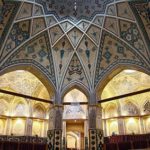
Sultan Amir Ahmad Bathhouse, also known as the Qasemi Bathhouse, is a traditional Iranian public bathhouse in Kashan, Iran. It was constructed in the 16th century, during the Safavid era; however, the bathhouse was damaged in 1778 as a result of an earthquake and was renovated during the Qajar era. The bathhouse is named after Imamzadeh Sultan Amir Ahmad, whose mausoleum is nearby.
Sultan Amir Ahmad Bathhouse, with an area of around 1000 square meters, consists of two main parts, Sarbineh (the dressing hall) and Garmkhaneh (the hot bathing hall). Sarbineh is a large octagonal hall, which has an octagonal pool in the middle separated by 8 pillars from the outer section. There are four pillars in Garmkhaneh, which make smaller bathing rooms all around as well as the entrance section to Khazineh (final bathing room) in the middle. The interior of the bathhouse is decorated with turquoise and gold tilework, plasterwork, brickwork as well as artistic paintings. The roof of the bathhouse is made of multiple domes that contain convex glasses to provide sufficient lighting to the bathhouse while concealing it from the outside.
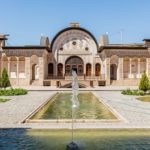
The Tabātabāei House is a historic house in Kashan, Iran. It was built in the early 1880s for the affluent Tabatabaei family. It consists of four courtyards, wall paintings with elegant stained glass windows, and includes other classic features of traditional Persian residential architecture, such as biruni and andaruni.
It was designed by Ustad Ali Maryam, architect of the Borujerdis House and the Timcheh Amin od-Dowleh. The house is almost 5,000 square meters and has been very well renovated. The interior yards have beautiful gardens. The house has 40 rooms,4 courtyards,4 basements and 3 windwards.
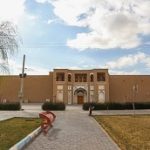
Nehchir Citadel is a historical building located near the city of Mobarakeh in Isfahan Province. The structure dates back to the Safavid era, and has been restored during the Qajar period.
The citadel was constructed in an area of 20,000 square metres and has a carpet area of 7,500 square metres. There are four pigeon towers in its four corners. In the old days, the place was used as a station to secure the roads, as well as a central place for local people to do daily shopping.
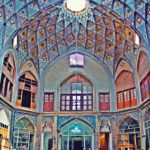
Bazaar of Kashan is an old bazaar in the centre of the city of Kashan, Iran. It is thought to have been built in the Seljuk era with renovations during the Safavid period. It was destroyed in an earthquake and the current buildings were mostly built during the Ghajar period.
The bazaar has a famous architecture, especially at its Timche-ye Amin od-Dowleh section, where a grand light well was built in the 19th century. The bazaar is still in use and is a few miles in total length. In the bazaar’s complex beside the main bazaars, there are several mosques, tombs, caravanserais, arcades, baths, and water reservoirs that each were constructed in a different period.
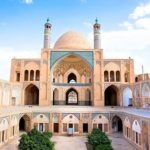
Agha Bozorg mosque is a historical mosque in Kashan, Iran. The mosque was built in the late 18th century by master-architect Ustad Haj Sa’ban-ali. The mosque and theological school (madrasah) is located in the center of the city.
Agha Bozorgh Mosque was constructed for prayers, preaching and teaching sessions held by Molla Mahdi Naraghi II also known as Mulla Mohammad Naraqi, known famously by his title of Āghā Bozorgh (literally meaning big or great lord) given to him by the Shah himself. Molla Mahdi Naraghi II was the son of the legendary Mulla Ahmad Naraqi (also spelled sometimes as Naraghi) who was the second strongest person in Iran after the king himself, Fath-Ali Shah Qajar.
The mosque has been described as “the finest Islamic complex in Kashan and one of the best of the mid-19th century”. Noted for its symmetrical design, it consists of two large iwans, one in front of the mihrab and the other by the entrance. The courtyard has a second court in the middle which comprises a garden with trees and a fountain. The iwan in front of mehrab has two minarets with a brick dome. It was here where Ustad Ali Maryam as a pupil started his career as an architect.
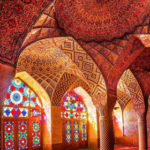
The Nasir al-Mulk Mosque, also known as the Pink Mosque, is a traditional mosque in Shiraz, Iran. It is located in Gawd-i Arabān quarter, near Shāh Chérāgh Mosque. It was built during Qajar dynasty rule of Iran. The mosque includes extensive coloured glass in its facade, and displays other traditional elements such as the Panj Kāse (“five concaved”) design. It is named in popular culture as the ‘Pink Mosque’, due to the usage of a considerable number of pink-colored tiles for its interior design.
The mosque was built during the Qajar dynasty, and is still in use. Construction began in 1876 by the order of the late Hassan Ali Nasir al-Molk, one of the lords and aristocrats of Shiraz, the son of Mirza Ali Akbar Qavam-ol-Molk, the ruler of Fars and was completed in 1888. The designers were Mohammad Hasan-e-Memār, an Iranian architect who had also built the famous Eram Garden before the Nasir al-Molk Mosque, Mohammad Hosseini Shirazi, and Mohammad Rezā Kāshi-Sāz-e-Širāzi.
Although stained glass is mostly popular in churches nowadays, the earliest discovered was in Syria from the 7th century. We do have evidence of techniques and recipes for obtaining stained glass by the Arabic chemist Jabir ibn Hayyan in his book Kitab al-Durra al-maknuna (The Book of the Hidden Pearl) published in the eighth century CE. Orsi windows are windows made of a mixture of wood and colorful glass in the Safavid and the Qajar dynasties. Orsi differs from stained glass used in many churches and Ottoman mosques which serve as illuminated images rather than a source of light. Light is a major feature in many mosques considering it being a major symbol of God in Islam. This is mentioned in a chapter in Quran: ″Allah is the light of the heavens and the earth″
Orsi in Nasir al Molk mosque creates a major definitive feature that makes up the colorful spiritual feeling of awe in the visitor when entering. The main purpose of Orsi is creating colorful light on the interior of the building. The mosque has seven wooden doors with colorful Orsi connecting the interior mosque to the courtyard. Orsi windows are characterized for using geometric shapes in their designs due to the prohibition of images and icons in islamic art.
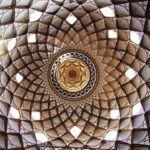
The Borujerdi House is a historic house in Kashan, Iran. The house was built in 1857 by architect Ustad Ali Maryam, for the wife of Seyyed Mehdi Borujerdi, a wealthy merchant. The wife came from the affluent Tabatabaei family, which Seyyed Mehdi fall in love with her and built this house for her.
It consists of a rectangular beautiful courtyard, delightful wall paintings by the royal painter Sani ol molk, and three 40 meter tall wind towers which help cool the house to unusually cool temperatures. It has 3 entrances, and all the classic signatures of traditional Persian residential architecture, such as a biruni yard (exterior yard) and a daruni yard (interior yard). The house took eighteen years to build using 150 craftsmen.
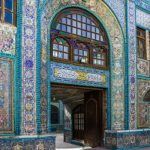
Tekyeh Moaven al-molk is in Kermanshah city of Iran. It was constructed during Qajar era as a Shia mourning site. In 1975 Tekyeh Moaven al-molk recognized as a National monument. it is well known for its exclusive tilings picturing Islamic era warriors, Battle of Karbala and pictures of Iranian kings.
This site has 3 main parts: Hussainiya Zaeynabiya and Abbasiya. Museum of Anthropology of Kermanshah and Clothes and Jewelry Museum of Kermanshah.
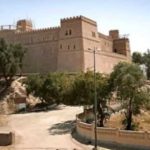
Shush Castle is located in the ruins of the ancient city of Susa (Shush) in the Khuzestan Province of Iran. It was constructed by French archaeologist Jean-Marie Jacques de Morgan in the late 1890s, as a secure base for archaeological exploration and excavation. The structure was built by local craftsmen with bricks taken from two other archaeological sites, the Achaemenid Darius/Dariush castle and the Elamite Choqazanbil ziggurat. It is built atop a hill (“tappeh”) which may contain other relics of past times. It is an example of the pre-scientific era of archaeology, when explorers mutilated or destroyed sites in the process of examining them.
The former French government property was taken over by the Islamic Republic after the Iranian Revolution in 1979. It is now used as a museum. Its best-known holding is a cuneiform tablet inscribed with the Code of Hammurabi, however this is now on display in the Louvre Museum in Paris, France.The castle was heavily damaged by Iraqi bombs during the recent Iran–Iraq War, but has since been completely restored by the Iranian government.

A Toos Foundation channel has now become active on the Telegram network.
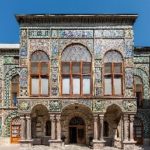
The Golestan Palace is the former royal Qajar complex in Iran’s capital city, Tehran. One of the oldest historic monuments in the city of Tehran, and of world heritage status, the Golestan Palace belongs to a group of royal buildings that were once enclosed within the mud-thatched walls of Tehran’s arg (“citadel”). It consists of gardens, royal buildings, and collections of Iranian crafts and European presents from the 18th and 19th centuries.
Tehran’s arg (“citadel”) was built during the reign of Tahmasp I (1524–1576) of the Safavid dynasty (1502–1736), and was later renovated by Karim Khan of the Zand dynasty (1750-1779). Agha Mohammad Khan of the Qajar dynasty (1742–1797) chose Tehran as his capital. The arg became the seat of the Qajars (1794–1925). The court and palace of Golestan became the official residence of the Qajar dynasty. The palace was rebuilt to its current form in 1865 by Haji Ab ol Hasan Mimar Navai.
During the Pahlavi era (1925–1979), the Golestan Palace was used for formal royal receptions, and the Pahlavi dynasty built their own palace (the Niavaran Complex) in Niavaran. The most important ceremonies held in the palace during the Pahlavi era were the coronation of Reza Shah (1925-1941) on the Marble Throne and the coronation of Mohammad Reza Pahlavi (1941-1979) in the Museum Hall. In between 1925 and 1945, a large portion of the buildings of the complex were destroyed on the orders of Reza Shah. He believed that the centuries-old Qajar palace should not hinder the growth of a modern city. In the place of the old buildings, commercial buildings with the modern style of 1950s and 1960s were erected.
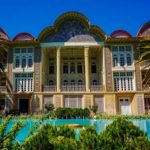
Qavam House (also widely called “Narenjestan of Ghavam”) is a traditional and historical house in Shiraz. It was built between 1879 and 1886 by Mirza Ibrahim Khan. The Qavam family were merchants originally from Qazvin. But they soon became active in the government during the Zand dynasty, followed by the Qajar, and Pahlavi dynasty as well.
The Qavam “Naranjestan” preserves the elegance and refinement enjoyed by the upper-class families during the 19th century. The paintings on the low ceilings of the house are inspired by Victorian era Europe. The mirrored porch was a focal point of the house, overlooking a small garden that was designed with fountains, date palms, and flowering plants. During the second Pahlavi era, the House became the headquarters of Pahlavi University’s Asia Institute, directed by Arthur Upham Pope and Richard Nelson Frye. Frye and his family also lived in the house for a while. The house today is a museum and is open to the public.
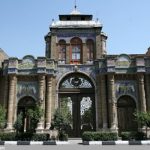
The National Garden (Bāgh-e Melli) is a historical and governmental compound in Tehran, Iran. Formerly referred to as the Parade Square (Meydān-e Mašq), it used to be a military shooting range during the Qajar period. It was then turned into a public park for a short period, and eventually important governmental offices and museums were built around it. The Ministry of Foreign Affairs (formerly the “Police House”), the University of Art (formerly the “Cossack House”), Malek National Museum, Post and Communication Museum, and the National Museum are situated in the compound.
The field was first constructed during the reign of the Qajar Dynasty. It was used for the military garrison, and the Cossacks practiced military parade in it. The range was then developed during the reign of Nasser ed Din Shah, with a new building named Cossack House, which was somewhat transformed during the reign of Mozaffar ed Din Shah. Under the rule of Reza Shah of the Pahlavi Dynasty, the range was turned into a modern public park for a short period, and the famous gate of the compound was built by Mirza Mehdi Khan Shaghaghi (Momtahen od Dowle) before the arrival of World War II. Eventually, important governmental buildings were built around the compound; such as the “Police House” (or the “Shahrbani House”) which was built for Shahrbani, an organization responsible for maintaining security in the city.
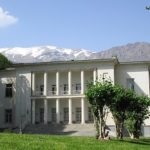
The Sa’dabad Complex is a 300 hectare complex built by the Qajar and Pahlavi monarchs, located in Shemiran. Today, the official residence of the President of Iran is located adjacent to the complex. The complex includes more than 180 hectares of natural forest, streets, qanats, galleries, and museums.
The complex was first built and inhabited by Qajar monarchs in the 19th century. After an expansion of the compounds, Reza Shah of the Pahlavi Dynasty lived there in the 1920s, and his son, Mohammad Reza Pahlavi, moved there in the 1970s. After the 1979 Revolution, the complex became a museum. Currently, parts of the complex are museums, which visitors can roam through. The complex is operated by the Cultural Heritage Organization of Iran which is responsible for most of the artifacts, locations, and cultural aspects of the country.
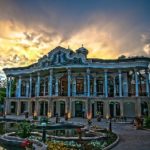
Shapouri House or Shapouri Pavilion and Garden is an early 20th-century Persian building and garden in the city of Shiraz, Iran.
It has 840 square metres of underpinning and 4635 square metres of garden area. This building is in the old central region of Shiraz, known as Anvari. This mansion was registered as a national building in 2000. Shapouri mansion was designed by Abolghasem Mohandesi and built between 1930 and 1935; the owner was Abdolsaheb Shapuori. This building is unique and very innovative.
Los Angeles County Museum of Art (LACMA) will hold joint a day of celebrations with Farhang Foundation on 13th March 2016 to mark the Iranian New Year. Included in the programme are the world premiere of Whispers of Spring, a multimedia musical performance by Mamak Khadem and her ensemble, a live concert by NIYAZ and a traditional Iranian costume parade.
The winner of the Hivos Tiger Award 2016 of the Rotterdam International Film Festival is Radio Dreams by Babak Jalali. Hivos Tiger Awards Competition is about upcoming talent who get a chance to shine on the world stage.
As of 2016, eight films will compete in the Hivos Tiger Awards Competition for a single Hivos Tiger Award. The jury on the winner: “For its subtle and humorous reflection on displacement and alienation of a group of misfits in a foreign culture.”
The 8th Belgian film festival Elles Tournent will screen three Iranian documentaries. The film festival which screens works by women filmmakers will screen ‘Iranian Ninja’ directed by Marjan Riahi, ‘Vocation: Documentary Producer,’ co-directed by Sepideh Abtahi, Farahnaz Sharifi, Shirin Barqnavard, Firuzeh Khosravani, Mina Keshavarz, Sahar Salahshour, and Nahid Rezaei, and ‘I as in ‘Iran’’ will represent Iran in the event. International women’s film festival. Elles Tournent will be held January 28 – February 01 in Belgium.
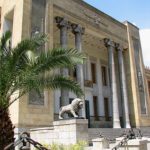
Bank Melli Iran (lit. National Bank of Iran) is the first national Iranian bank. The bank was established in 1927 by the order of the Iranian Majlis (the Iranian Parliament) and since then has consistently been one of the most influential Iranian banks. It is one of the oldest buildings associated with Iran National Bank and was built in 1927 by a German architect.
Contemporary composer Sahba Aminikia will stage his newest piece ‘Sound, Only Sound Remains’ in San Francisco by the Kronos Quartet and SF Girls Chorus on February 5, 2016.
Speaking on the musical piece, he said that it is a composition based on a Qajar song which is recorded by Loretta Hayrapetyan in Vaziri.
The 66th Berlin Film Festival known as Berlinale, February 11, 2016, will show four films representing Iran in various sections of the festival.
Mani Haghighi’s latest film “A Dragon Arrives” will be competing in the main section of the festival; Reza Dermishian’s “Lantouri” will be screened in the Panorama section and two other films “Valderama” by Abbas Amini and “Starless Dreams” by Mehrdad Oskoui will be s…creened outside the competition as part of the “Generation” section of the festival.
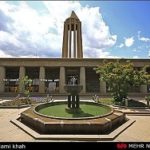
The Mausoleum of Avicenna is a complex located at Avicenna Square, Hamadan, Iran. Dedicated to the Iranian polymath Avicenna, the complex includes a library, a small museum, and a spindle-shaped tower inspired by the Ziyarid-era Kavus Tower.
Designed by Hooshang Seyhoun, it was built in 1952, replacing an older building dedicated to Avicenna which was destroyed in 1950. The Iranian government had plans to build the mausoleum since at least 1939. The mausoleum was eventually dedicated in a grand ceremony in May 1954, and the avenue running in front of it was also renamed in honor of Avicenna.
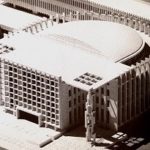
The Senate of Iran was the upper house legislative chamber in Iran from 1949 to 1979. A bicameral legislature had been established in the 1906 Persian Constitutional Revolution but the Senate was not actually formed until after the Iran Constituent Assembly, 1949, as an expression of Shah Mohammad Reza Pahlavi’s desire for more political power. The Senate was filled mainly with men who were supportive of the Shah’s aims, as intended by Pahlavi.
The Senate was disbanded after the “Islamic Revolution” in 1979, when the new constitution established a unicameral legislature. As of 2015 the former Senate building was used by the Assembly of Experts. The Senate House of Iran was designed by architect Heydar Ghiaï in 1955. The construction was led by Rahmat Safai, the dome being one of the most technically challenging projects in the entire endeavour.
Art work by Iranian video artists will be screened at Video-Art Box and also online by visualcontainer TV in Milan, Italy during the months of January and February 2016.
The artists featured in this exhibit are: Fatemeh Omidian, Arezou Bagh Sheikhi, Azar khorshid, Setareh Hosseini, Fatemeh Bahmani Syahmard, Shahireh Foroughi, Morvarid Ghasemi, Hamid Ghodradi, Sadegh Asad, Sepideh Amiri, Elika Zarei and Naghmeh Maghsoudlou.
Global/Local 1960–2015: Six Artists from Iran, opening today at New York University’s Grey Art Gallery, draws upon an impressive collection of more than 200 Iranian artworks. This is the first major museum exhibition in the US to include pioneering Iranian modernists and emerging artists working in Tehran and abroad.
Featured in Global/Local is Shiva Ahmadi, whose paintings are informed by these events. “In my work I am always exploring what is going on in our world. There is always a battle between the good and the bad, there is always . . . a struggle,”
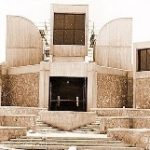
Tehran Museum of Contemporary Art is among the largest art museums in Iran. It has collections of more than 3000 items that include 19th and 20th century’s world-class European and American paintings, prints, drawings and sculptures. TMoCA also has one of the greatest collections of Iranian modern and contemporary art. The museum was inaugurated in 1977 and is considered to have the most valuable collections of modern Western masterpieces outside Europe and North America.
The museum was designed by Iranian architect Kamran Diba, who employed elements from traditional Persian architecture. It was built adjacent to Laleh Park. Most of the museum area is located underground with a circular walkway that spirals downwards with galleries branching outwards.
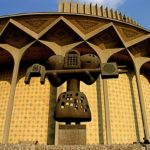
The City Theater (Teātr-e Šahr) is a performing arts complex in Tehran. It was built with the initiative of Queen Farah Pahlavi. It contains several performance spaces including the halls of Charsou, Qashqai, Saye, and the main hall. It also houses a specialist library for the arts.
The complex was designed by architect Ali Sardar Afkhami (a student of Hooshang Seyhoon) in the 1960s and opened in 1972. The design was inspired by Tughrul Tower.
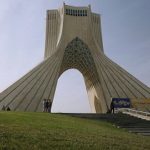
The Azadi Tower (Borj e Āzādi; “Freedom Tower”), formerly known as the Shahyad Tower (Borj e Šahyād; “King’s Memorial Tower”), built in 1971 is a monument located at Azadi Square, in Tehran, Iran. It is one of the landmarks of Tehran, marking the west entrance to the city, and is part of the Azadi Cultural Complex, which also includes a museum underground.
The tower is about 45 meters (148 ft) tall and is completely clad in cut marble. It was commissioned by Mohammad Reza Pahlavi, the last shah of Iran, to mark the 2,500th year of the foundation of the State of Iran. After winning a competition, architect Hossein Amanat was tasked to design the tower. His ideas were based upon classical and post-classical Iranian architecture and popular influences on art in the 1960s.
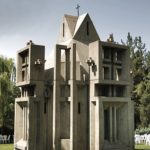
Surp Khatch Chapel in Tehran holds a peculiar significance within Armenian-Iranian life. There are many Armenian churches within Iran, mostly in Tehran and the western provinces. Surp Khatch was built in 1986 by Rostom Voskanian in 1987 in part to memorialize the thousands of Armenian service members killed in the Iran-Iraq War.
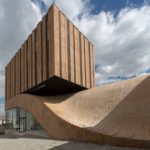
The brick facade of this mixed-use building in the Iranian city of Hamedan merges with a wave-like roof that the public is invited to sit, walk or play on. The Termeh building was designed by architects Farshad Mehdizadeh and Ahmad Bathaei to accommodate two separate occupants and two distinct functions: a retail space on the ground floor and an office on the level above.
It is designed to connect with the city’s public realm and is influenced by Hamedan’s many public squares, which are linked by wide boulevards. One of these boulevards runs along one edge of the building, so the architects decided to emphasise the connection between the interior and the street by bringing the roof down to meet the pavement.
The building is titled after the traditional handwoven Iranian cloth Termeh, which is evoked by the undulating form. Local bricks laid in traditional patterns match the facades found on many buildings in the neighbourhood.
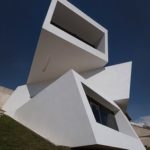
A trio of volumes are stacked one on top of each other to form this hillside residence near Tehran by New Wave Architecture, but each one is angled towards a different view. The Iranian practice designed Mosha House for a structural engineer and his family, for a steeply sloping plot facing the Alborz mountain range.
To make the most of the scenery surrounding the elevated site, the architects devised three single-storey blocks with glazed ends that frame vistas of both the peaks and the Mosha plain below. The concrete block are stacked irregularly so that they form cantilevers. All three blocks are painted white, giving them a distinctive appearance in the setting. The aim was to create a sense of “purity”, according to the team. The volumes have a collective floor area of 260 square metres. Inside, they include two generous bedrooms, an indoor swimming pool and a timber-lined sauna.
“The intense topography and the location between mountains with views to flat plain of Mosha, inspired us to create a sense of suspension and wide views for all spaces,” said the architects.
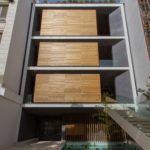
Swivelling pods allow the owners of this house in Tehran to adapt to Iran’s fluctuating temperatures by opening up rooms in summer, or turning them inwards during winter. Designed by Tehran studio Next Office, Sharifi-ha House features three rooms that can be rotated 90 degrees to open up views and terraces during Iran’s hot summers, and turned back to a horizontal position to keep the house warmer during the cold, snowy winters. “The openness and closure of the building is a reference to traditional Iranian houses, which offer both a winter and a summer living room,” said architect Alireza Taghaboni of Next Office, whose previous projects include a concrete house with a sweeping curved facade. “Like many urban plots, this one had a noticeably narrow facade-width compared with its depth. Consequently, our expertise in transforming a two-dimensional facade to a three-dimensional one became indispensable,” said Taghaboni, who redesigned plans 16 times for the client throughout the course of the project.
The three pods house a breakfast room on the first floor, a guest room on the second floor, and a home office on the third floor. Each one features a door at the side that provides access to the terrace when they are turned open, and access to the house when they are closed. “The house adapts to the functional needs of its users,” said Taghaboni. “The guest room can be reconfigured for different purposes. Similarly, the home office and breakfast room can change the formality of their appearance according to their residents’ desires.” The motorised turntables that the pods rest on were made by Germany company Bumat, using a system that theatre sets and car exhibitions also rely on. Terraces had to be designed with foldable balustrades that tilt up or down as the pods are being rotated, to accommodate the changeable facade.
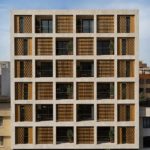
Wooden shutters can be drawn across the pigeonhole-style windows of this apartment block in Tehran by local studio TDC Office. Studio founders Sara Kalantary and Reza Sayadian created the eight-storey block known as Saba in response to the “change in people’s lifestyle, development of the cities and the increasing demand for constructing high-rise buildings” in the Iranian capital.
The street-facing facade comprises blocks of light-coloured stone and features a grid of recessed windows, which are covered by slats of wood with wavy edges. Set vertically on rails in front of floor-to-ceiling windows, these individual pieces of shuttering can be arranged by hand depending on the owners need for light, privacy or views – a technique also used by Ayeneh Office for its ridged granite housing block in the city.
But Kalantary and Sayadian feel this high-rise lifestyle has obliterated the connection between home and garden, so wanted to reestablish the connection. This project was the result of our efforts in revitalising this lost heritage and giving a new interpretation to the old concept,” they said. “Which we believe one of the main reasons of the cultural crisis our society is engaged with nowadays is the result of this abrupt shift in the living space.” The building’s garden-facing facade is made from locally sourced brick and features the same grid of windows as the street frontage. Each of the building’s six uppermost floors features four apartments – two at the front and two at the rear – while the lower levels are used for car parking. This arrangement gives each resident access to a private outdoor area.
Azerbaijani artist Faig Ahmed’s handmade woolen carpets look like they have been through a Photoshop accident. Ahmed takes inspiration from traditional carpets but pushes the boundaries of his craft by crafting carpets that look like they have encountered computer glitches and corrupted images. “My art is an experiment. I want to examine the subject matter to see how deep can we go inside something accomplished and holistic and to observe the influence this kind of a change can have on people,” Ahmed says. The beautiful carpets are on display at the Museum of Fine Arts in Boston in the US until January 10.
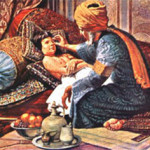
The United Nations Educational, Scientific and Cultural Organization has added Zakariya Razi’s anniversary to its list of commemorations for the next two years. Razi (854-925 AD), was a Persian polymath, physician, alchemist and chemist, philosopher and an important figure in the history of medicine.
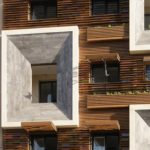
Faceted window frames project from the slatted timber and stained-glass facade of this apartment block in Tehran, designed by Iranian studio Keivani Architects. Brothers Nima and Sina Keivani based the design of the seven-storey block on elements commonly found in traditional Iranian architecture. The architects particularly wanted to reinterpret the orsi window, a type of sash window with latticed woodwork and coloured glass typically used to help reduce sunlight and heat, and repel insects in the hot climate. This inspired the project name Orsi Khaneh.
“The main concept of this built project originated from Iranian traditional architecture,” said Keivani Architects. “They were using a special type of window, locally called orsi, made by wooden lattice and stained glasses, which have effective technical functions.”
“We tried to make a modern orsi window, with the aim of creating a space with an Iranian spirit or genius loci, which respects both the mental and biological needs of the users,” added the brothers. “So the elements like water, plants, and light have been highlighted.”
The street-facing facade is made from a double layer of heat-treated timber, inset with panes of stained glass and planting that not only serve as a decorative element but also help to control temperature. Matching slatted sunshades can be raised over the windows to provide further control of sunlight. The appearance is in part inspired by a pair of historic residences with intricately moulded and patterned facades – Borujerdis House and Tabātabāei House, located in the Iranian city of Kashan.
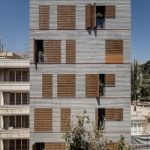
Slatted timber shutters provide privacy and shade for this Tehran apartment block by local firm Ayeneh Office, and line up with its ridged granite facade. Andarzgoo Residential Building was designed by Ayeneh Office for a site near Andarzgoo Boulevard – a lively, upmarket area in the north of the Irani capital. The block stands on a narrow alley near other buildings of varying heights and materials, so the architects in charge Ali Dehghani, Ali Soltani and Atefeh Karbasi chose to give it a simple, restrained exterior.
“The adjacent buildings have been chaotically constructed, so we created a neutral, formless facade to give the alley a calmer quality,” they said. “Our strategy was primarily focused on the avoidance of a complex presentation.” The six-storey building has a small car park on the ground floor, and one apartment on each of the floors above. There is also a basement housing a gym, mechanical rooms and storage.
Local zoning rules prevented the architects from adding balconies at the front of the building, so they inserted deep glazed recesses into each apartment instead, which provide internal terraces, and bring light and ventilation into the living spaces. The five apartments each have an open-plan living space and dining area at the front, and three bedrooms and two bathrooms at the north-facing back, which are arranged in a C-shape around a void to ensure they get adequate daylight.
“We placed the private areas at the back, and the communal areas along the main facade, which faces south-west, to invite sunlight inside the main living space,” explained the architects. The five apartments each have an open-plan living space and dining area at the front, and three bedrooms and two bathrooms at the north-facing back, which are arranged in a C-shape around a void to ensure they get adequate daylight. “We placed the private areas at the back, and the communal areas along the main facade, which faces south-west, to invite sunlight inside the main living space,” explained the architects.
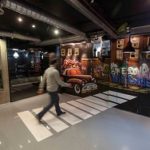
This cafe in the Iranian capital is designed to act as a semi-public venue in the city, where open gathering spaces are starting to become popular again after years of heavy policing. The cafe in Tehran’s Mirdamad neighbourhood was designed by Sanaz Ghaemmaghami and Mojtaba Zaheri of local studio Modaam Architects for the Amir Chocolate coffee shop chain.
“In a megalopolis like Tehran the public sphere gradually fades, affected by political and social factors,” said the architects. “The Amir Chocolate + Urban Cafe is an attempt to create public space in the heart of Tehran’s dense urban context.” The cafe features a removable glass frontage that allows the interior to extend onto the adjacent pavement. These glass partitions are fixed to a track in the ceiling so they can be entirely removed to one side or set back to form a screen that exposes part of the interior to the street.Boxy planters surrounding the bases of trees outside the Amir Chocolate + Urban Cafe offer suitable perches so guests can eat and drink at tables set out on the pavement. According to the architects, this sort of al fresco experience is still rare in Tehran.
A graffiti mural applied to one wall of the cafe depicts a typical urban scene, featuring a road, automobile and a glimpse of the city’s Milad Tower. When viewed from the correct angle, a striped pedestrian crossing painted on the floor appears to continue into the painted scene, creating an illusion of depth within the space.
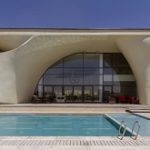
Billowing curves sweep across the concrete facade and continue inside this house near Tehran, designed by Iranian studio Next Office. Kouhsar Villa in Kordan, Iran, was already partly built when the owner approached Next Office to redesign it. His brief was to open the house up by removing an octagonal void in the centre, which offered little connection with the surrounding landscape.
Rather than tear the central void’s steel columns down, the redesign has covered them with a continuous curved wall, which extends outside to cover the southern facade. The architects cut openings into this curved structure to connect the central void to the surrounding rooms, and also cut through the floors above to create double-height spaces.
Ferdowsi in Wikipaedia >>>
On Ferdowsi >>>
Statement from the Toos Foundation after the event (in Persian) >>>
Sunday 15th Nov 2015, Logan Hall, London
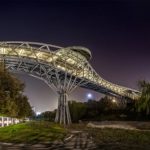
An assortment of different pathways encourage pedestrians to “wander and get lost” on this bridge in Tehran, designed by Iranian architect Leila Araghian. Araghian’s studio Diba Tensile Architecture completed the 270-metre-long Tabiat Bridge at the end of 2014, five years after winning a design competition.
It is currently the largest pedestrian bridge in Iran, connecting Abo Atash Park on the west to Taleghani Park on the east, across a busy highway. The structure comprises three levels that follow a curved path, and which are connected by various ramps and stairs.
Tabiat Bridge is located in a northern area of Tehran known as Abbas Abad, which was originally planned as a housing area for various branches of the military, but has become a destination for libraries and museums.
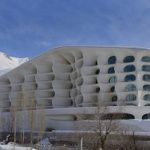
This ten-storey resort is located near Shemshak ski resort, the second largest ski resort in Iran and in only half an hour drive from the capital. This location is defined by Snow-covered landscapes, so the architects didn’t want the building to be indifferent about its surrounding, but as a part of nature embracing that. The Barin Ski resort picks up on the philosophy of designing buildings so that the form emulates the immediate environment in a fluid way. Barin ski resort looks one with the snow-covered mountain, almost as if windswept onto the mountain side, like an iced rock formation.
The individuals rooms, 67 in total, each in a different size, from 45m studio flat to 270m penthouse, seem carved into a mountainous ice block like natural caves. Each cell which is in dome shape enhances the feeling of a warm, homely ‘cave’ to relax in after skiing out in the cold. The continuation of this design approach inside the rooms and corridors, which also have organically formed, as well as the pebble shaped windows that offer stunning views of the surrounding mountain range, all these factors make the Barin Ski Resort a holistic building that complements its natural habitat.
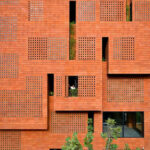
This building is the headquarters for Kohan Ceram Brick Manufacturing Company, including showroom, sales office, and a guest unit. It was designed by the Hooba Design Group
Situated alongside a highway in Tehran, this project marks the boundary between the residential neighbourhood and the freeway in the urban fabric. The main criterion here was to remain neutral in the urban scale while creating a tangible entity in the local scale. Preserving the existing concrete structure, it was decided to Design a special brick (by the architect) to represent the factory.The bricks were used as the main representative of the company. The brick module not only forms the facade, but also forms the entirety of the project both on the interior and the exterior.
The “Spectacled Brick” not only formed the exterior façade, but also transformed from a surface into a volume which extended into the building in the form of modular greenspaces. Replacing ordinary walls and windows, these modules defined different spaces in the building. Therefore, the interior walls were formed by the extension of the exterior walls, following the main design criteria which was to merge dual qualities.
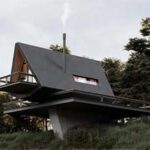
Located in a forested and mountainous area of Guilan, Iran, the ‘tiny home’ ev.design.office is a 45sqm villa that suspends over land like a tree canopy with its trunk. Its chief arhitects were Mojtaba Naghizadeh and Nastaran Tavakoli. Despite its small size, the project features practical and suitable spaces that are ideal for weekend escapes. Despite the prevailingly hot and dry climate of iran, the southern coast of the caspian sea offers unique advantages to such projects: ‘the findings show that design strategies based on traditional architecture are still applicable in the temperate humid climate of the region, and can lead to low energy buildings,’ explains the team.
Aside from the temperate climate, the team behind ev.design.offce adapted the architecture to local building methods. indeed, the area features traditionally small warehouses to store agricultural products. combining those characteristics with the client’s needs, the ‘tiny home’ comes to life as a low-impact and low-cost villa that creates a sense of suspension and opens onto panoramic views of the forested landscape.
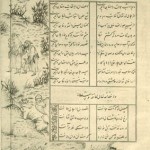
Abd al-Hayy (1374 – 1405) was an illustrator and a painter. He trained under Shams al-Din at Baghdad during the reign of the Jalayirid Shaikh Awais Jalayir (1356-74) and became the leading painter under his son Ahmad, who was also `Abd al-Hayy’s pupil. When Timur took Baghdad, `Abd al-Hayy was sent to Samarkand, either in 1393 or in 1401, where he spent the rest of his life.
He seems to have specialized in monochrome ink drawings. `Abd al-Hayy was a skilled painter who worked for Timur on wall paintings at Timurid palaces.The wall painting of the woman and child is similar to marginal drawings in a copy of Ahmad Jalayir’s Divan, which have also been attributed to `Abd al-Hayy. According to Dust Mohammad, one of `Abd al-Hayy’s students was Pir Ahmad Baghshimali.
Dust Muhammad attributed one painting to `Abd al-Hayy in the Divan. It was detached from a copy of the Divan (‘Collected poems’) of Khwaju Kermani copied at Baghdad in 1396. The scene of a sleeping youth visited by angels is in the same style as the other paintings in the manuscript, one of which is signed by Junayd.
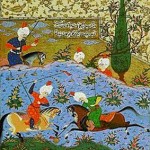
Mir Alī Shīr Navā’ī also known as Nizām-al-Din ʿAlī-Shīr Herawī (1441 – 1501) was a Central Asian Turkic politician, mystic, linguist, painter, and poet. He was the greatest representative of Chagatai language. He significantly contributed to the development of the Uzbek language and is widely considered to be the founder of Uzbek literature. He was generally known by his pen name Navā’ī.
Mīr Alī Shīr served as a public administrator and adviser to his sultan, Husayn Bayqarah. He was also a builder who is reported to have founded, restored, or endowed many mosques, madrasas, libraries, hospitals, caravanserais and other institutions in Khorasan. Among his most famous constructions were the mausoleum of the 13th-century Persian mystic poet, Farid al-Din Attar, in Nishapur.
Moreover, he was a promoter and patron of scholarship and arts and letters, a prolific writer, a musician, a composer, a calligrapher, a painter and sculptor. He was responsible for a number of illustrated books published at the time in which the earliest existing examples of the newly emerging style of Persian miniature can be found – including some attributed to him although we do not know which ones are actually done by him – probably some which appear in his own Divan.
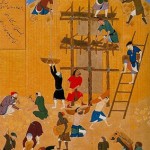
Kamāl ud-Dīn Behzād[ (1450 – 1535) was a miniaturist and illustrator.
Behzad was born, lived and worked in Herat, Afghanistan under the Timurids, and later in Tabriz under the Safavid dynasty. An orphan, he was raised by the prominent painter Mirak Naqqash, and was a protégé of Mir Ali Shir Nava’i. His major patrons in Herat were the Timurid sultan Husayn Bayqarah (ruled 1469 – 1506) and other amirs in his circle. After the fall of the Timurids, he was employed by Shah Ismail I Safavi in Tabriz, where, as director of the royal atelier, he had a decisive impact on the development of later Safavid painting. Behzad died in 1535 in Tabriz.
Persian painting of the period frequently uses an arrangement of geometric architectural elements as the structural or compositional context in which the figures are arranged. Behzad stretches that compositional device in a couple ways. One is that he often uses open, unpatterned empty areas around which action moves. Also he pins his compositions to the floating eye of the observer giving an quirky organic illusion of flow. The gestures of figures and objects are not only uniquely natural, expressive and active, they are arranged to keep moving the eye throughout the picture plane.
Behzad’s most famous works include “pages from Sa’di’s Bustan, 1488, and paintings from the British Library’s Nizami manuscript of 1494-95 – particularly scenes from Layla and Majnun and the Haft Paykar. The attribution of specific paintings to Behzad himself is often problematic but the majority of works commonly attributed to him date from 1488 to 1495.
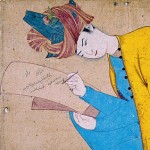
Sultan Muhammad was a Persian painter, calligrapher and art historian. His exact date of birth and death are not known. He was born in Herat in the late 15th century. He was a disciple of Kamāl ud-Dīn Behzād. Prince Bahram Mirza first spotted his talent and invited him to work in his studio. By early 1520 Sultan Muhammad with Behzad moved from Herat to Tabriz. After the death of Shah Ismail I, he remained in the service of Shah Tahmasp I, taking part in the illustration of the famous “Shahnameh”.
In the late 1530s he worked at the court of the ruler of Kabul, Kamran Mirza, brother of Mughal emperor Humayun. In 1555, and at the invitation of the Emperor, he traveled to India. Sultan Muhammad is known as the author of an essay on Persian calligraphers and artists (1544-45). His writing provides a clear allusion to the existence of a religious ban for images of living beings, and at the same time on the relativity of this prohibition.
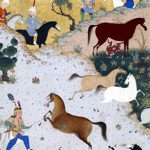
Mir Musavvir (- 1555) was an illustrator and painter.
Mir Musavvir was born in either Termez or Badakhshan in the late 15th century. According to the contemporary chronicler Dust Muhammad, he and Aqa Mirak worked together closely in service to the Safavid royal library who did wall paintings for the palace of Prince Sam Mirza and illustrations for royal manuscripts of Ferdowsi’s Shahnameh (‘Book of kings’) and Nizami’s Khamsa (‘Five poems’). “Manuchihr Enthroned” of the Shahnameh is signed on a courtier’s turban, and a verse couplet written in the iwan of Nushirwan and the Owls, made for the Shah between 1539 and 1543, says that it was penned by Mir Musavvir in 1539-40. A portrait of the steward Sarkhan Beg is also inscribed as his work.
It is known that his speciality was big scenes with many figures, although he did portraits and individual character drawings too.
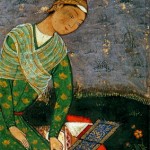
Mir Seyyed Ali (1510–1572) was a Persian illustrator and painter who, together with his fellow countryman Abd-uṣ-Ṣamad (Mirza Ali), emigrated to India and helped to found the Mughal school of painting.
Born in Tabriz, Mir Seyyed Ali was the son of artist Mir Musavvir. Historian and chronicler Qazi Ahmed said that the son was more talented than his father, but the impact of Mir Musavvir did influence his work. Modern research suggests that at a young age Mir Sayyid Ali took part in the illustration of the famous “Shahnameh” created in 1525–35 for the years of the Shah Tahmasp I (1514–1576). The manuscript was once embroidered, and individual sheets of it went to different museums and collections. Seyed Ali’s hand in it are attributed to two miniatures.
The next step was his involvement in the creation of illustrations for the famous manuscript of Nizami’s Khamsa (‘Five poems’) created by the best artists of the Shah kitabhane in 1539–43 by order of Shah Tahmasp. Of the 14 miniatures his brush is credited with four, among them “Layla and Majnun”, which bears the signature of the artist. The period around 1540, contains two remarkable works of the master: a picture of the elegant young man holding a letter disclosed, and a diptych (double frontispiece) for Nizami’s Khamsa with “nomad camp of nomads” on one sheet and “Evening Life Palace” on the other.
In India He and ʿAbd-uṣ-Ṣamad instructed the artists of the imperial atelier, most of them Indians, and superintended the production of the giant “miniatures” illustrating the Dāstān-e Amīr Ḥamzeh (“Stories of Amīr Ḥamzeh”), a colossal undertaking that consisted of some 1,400 paintings, each of unusually large size. The few of his paintings that have survived were for the most part painted before his arrival in India. They are sufficient, however, to denote him as a highly gifted painter, wielding an unusually delicate brush and possessed of great powers of observation
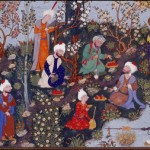
Aqa Mirak was a painter, purveyor and companion to the Safavid shah Tahmasp I and was well known in contemporary circles. Initially living in Tabriz, he traveled and lived in Mashhad between 1555 and 1565, and Qazvin from 1565 until his death.
The contemporary chronicler Dust Muhammad mentioned that Aqa Mirak along with Mir Musavvir did wall paintings for Prince Sam Mirza’s palace in Tabriz and illustrations for royal manuscripts of Firdawsi’s Shahnameh (‘Book of kings’) and Nizami’s Khamsa (‘Five poems’). Qazi Ahmad wrote that Aqa Mirak “had no peer in artistic design and was an incomparable painter, very clever, enamoured of his art, a bon vivant, an intimate [of the Shah] and a sage”. A manuscript of the Khamsa done between 1539 and 1543 has four illustrations bearing attributions to Aqa Mirak.
Works ascribed to a youthful period in the 1520s have tautly composed landscapes inhabited by a few large-scale figures. A transitional period in the early 1530s was followed by mature works produced from the late 1530s to c. 1555, in which the compositions are more complex and the coloring more subtle.
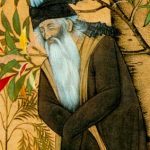
Farrukh Beg (1545 – 1615) was a Persian born Mughal painter who served in the court of Mirza Muhammad Hakim before working directly for Mughal Emperor Akbar. He is one of a number of artists who took the traditions of the Persian miniature to form that of the Mughal miniature, like Abd al-Samad.
He was born in Iran and belonged to the Kalmyk sect and received training in Khurasan. He was there until 1585 with artists who had been in the atelier of Ibrahim Mirza. He started working in Kabul under Muhammad Hakim, half brother of emperor Akbar. And after the death of Hakim, he moved to Delhi in December 1585. He took part in Kandhahar campaign of Akbar. He worked on many paintings for Mughal royalty between 1585 and 1590.
He was in the Deccan until 1608 and this shows the style he used when he returned to the court of Jahangir in Mughal India. His most noted work was under Jahangir called as the Gulshan Album. It is among the finest Mughal paintings. It is at the Golestan Library in Tehran.
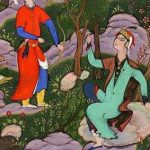
Abd al-Samad or Khwaja Abdus Samad, known as Mirza Ali, was a 16th-century painter of Persian miniatures who together with Mīr Sayyid Alī moved to India and became one of the founding masters of the Mughal miniature tradition, and later the holder of a number of senior administrative roles. He is sometimes referred to as “of Shiraz”. Samad’s career under the Mughals, from about 1550 to 1595, is relatively well documented, and a number of paintings are attributed to him from this period. From about 1572 he headed the imperial workshop of the Emperor Akbar.
It has recently been contended by a leading specialist, Barbara Brend, that Samad is the same person as Mirza Ali, a Persian artist whose documented career seems to end at the same time as Abd al-Samad appears working for the Mughals. These say that he was the son of another leading artist of the court workshop, Sultan Muhammed, and so grew up in the milieu of the court atelier, and was a distinguished painter. Kamal of Tabriz is recorded as a pupil of his.
Reza Abbasi, (1565–1635) was the leading Persian miniaturist of the Isfahan School during the later Safavid period, spending most of his career working for Shah Abbas I. He is considered to be the last great master of the Persian miniature.
Unlike most earlier Persian artists, he typically signed his work, often giving dates and other details as well. His first dated drawing is from 1601. His speciality was the single miniature for the albums or of private collectors, typically showing one or two figures with a lightly drawn garden background. The most typical have at least some colour in the figures, though not in the background; later works tend to have less colour. The style he pioneered remained influential on subsequent generations of Persian painters; several pupils were prominent artists, including Mu’in, who painted his portrait many decades later as well as Reza’s son, Muhammed Shafi Abbasi.
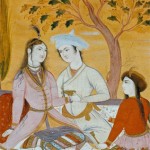
Muin Musavvir (1638–1697) was a Persian painter. He is considered as one of the most famous miniaturist of the Safavid period. He received his training from Reza Abbasi who pioneered Persian miniaturist of the Isfahan School at that time.
Muin was born in Isfahan and probably spent all of his life in this city. He is notable as a master in illustration paintings specially figures of people. Besides, His compositions in depicting of banquet and battle subjects are well known. Muin created his unique style that was exploited from Isfahan conditions in that era and was distinguishable from Chinese and Mughul style. He was specialist in illuminated manuscript and border decorating and he illustrated animals and landscapes and other Aqa Mirak styles with significant virtuosity. Muin Mostly used watercolor in his painting and remained faithful to Isfahan school and Reza Abbasi.
Muin Musavvir was one of the pioneers among Iranian artist who signed his works and provided dates and details for his manuscripts.
Lady Kharrazi, the founder and director of Toos Foundation, is an accomplished artist and a successful businesswoman. As a ballerina and classical singer, she has performed in Europe, the Middle East and USA; and as a designer and property developer, she has managed many successful ventures. She has established a number of companies and trusts continuing as a consultant to many of them.
Lady Kharrazi is a staunch supporter of the arts and a champion of human rights. She continues to work extensively with children affected by armed conflict throughout the Middle East and Asia and has sponsored many postgraduate students from Asia at Western universities through her charities. She has acted as Harvard University’s Ambassador to the Middle East and is a member of Dean’s International Council of the Harris School at the University of Chicago.
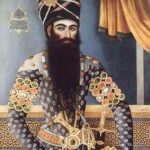
Mirza Baba (late 18th century and early 19th) was a Persian painter. He was employed by the Qajar family at Astarabad, as indicated by a signed drawing of a dragon and phoenix (1788-9). After Agha Muhammad ascended the throne, Mirza Baba worked at the Qajar court in Tehran in a wide variety of materials, techniques and scales.
His oil portrait (1789-90; Tehran, Nigaristan Mus.) of the Sasanian king Hurmuzd IV (AD 579-90) probably belonged to a series of historical portraits, for Mirza Baba painted a second series a decade later. One of the two surviving paintings from the later series (Tehran, A. H. Ibtihaj priv. col.) shows the Saljuq ruler Malikshah (1072-92) with his two ministers. Other early works by Mirza Baba include a still-life with pomegranates, watermelon and flowers (1793-4; Tehran, Nigaristan Mus.) and an arched panel showing Shirin Visiting Farhad as He Carves Mt Bisitun (1793-4; priv. col., see Treasures of Islam, no. 184). Many of these early oil paintings follow the style set by Muhammad Sadiq.
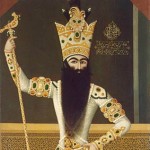
Mihr ‘Ali (1795 – post 1830) was one of the great royal painters of the Persian court during the reign of Fat’h Ali Shah Qajar, and is regarded as the most notable Persian portraitist of the early part of his reign.
Mihr ‘Ali’s chief skill was his ability to capture the portrait-sitter’s grandeur and power, and as such he became a favourite painter of the Shah. Mihr ‘Ali produced at least ten full-size oil paintings of Fat’h Ali Shah, one of the earliest of which was probably sent as a present to the amirs of Sind in 1800. A further portrait, of the Shah enthroned, was sent to Napoleon. Mihr Ali’s finest portrait is an 1813–4 work, regarded by some as one of the finest Persian oil painting in existence. It shows a full-length portrait of the King wearing a gold brocade robe and a royal crown, holding a jewelled staff.
Fat’h Ali Shah commissioned great numbers of lifesize portraits of himself and his sons, works which formed the backdrop to court ceremonies. The works, painted by Mihr ‘Ali and his predecessor as court painter, Mirza Baba, portrayed Fat’h Ali Shah in his many stately roles, and were intended to show his power as a ruler rather than to be realistic portraits. As a result, the works are heavily stylised, are painted in rich, deep tones, and are filled with symbols of power.
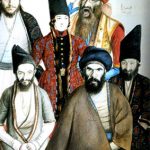
Mirza Abol-Hassan Khan Ghaffari Kashani, (1814 – 1866) known as Abol-Hassan the Second and entitled “Sani ol-Molk”, son of Mirza Mohammad Ghaffari, the talented painter and graphic artist of the early 19th century was born in Kashan around 1814. After his elementary schooling, he was sent, at the age of fifteen or sixteen, to learn painting with Master Mehr-Ali Esfahani, the famous painter and the naqqashbashi (grand painter) of Fath-Ali Shah of Qajar.
Mirza Abol-Hassan Khan, driven by his innate taste and inherited talent, and with the guidance and tutelage of his instructors, gradually attained the perfection of his art, and soon became a renowned artist of his time. In 1842, during the reign of Mohammad Shah of Qajar, he was allowed to paint a portrait of the monarch, thus becoming a court painter, and soon after was appointed naqqashbashi of Mohammad Shah’s court. Mohammad Shah’s oil portrait dated 1842 is considered his earliest painting.
Mirza Abol-Hassan Khan went to Italy, then the artistic centre of Europe, in order to see and study the works of the great and famous European artists, particularly those of Renaissance, and become acquainted with their painting methods. He spent some time in Italy visiting and studying in the academies and museums of Rome, Vatican, Florence and Venice, making copies of the works of Italian artists. When he returned to Iran Naser o Din Shah was on the throne. His illustrations for the book of “one thousand and one night” became famous for his use of contemporary personalities to depict characters in the stories.

Mohammad Ghaffari (1847 – 1940), better known as Kamal-ol-molk was a celebrated Iranian painter. He was born in Kashan to a family greatly attached to art. Kamal’s uncle, Mirza AbolHassan Khan Ghaffari, known as Sanee-ol-Molk, was a celebrated painter. His father, Mirza Bozorg Ghaffari Kashani, was the founder of Iran’s painting school and a famous artist as well. His brother, AbuTorab Ghaffari, was also a distinguished painter of his time. Mohammad developed an interest in calligraphy and painting at a young age.
Upon completion of his primary education, Mohammad moved to Tehran and registered at Dar-uol-Fonun School, a modern institute of higher learning in Persia, where he studied painting with Mozayyen-ol-doleh, a well-known painter who had visited Europe and studied Western art. In his visits to Dar-ol-fonoon, Naseral-din Shah came to know Mohammad Ghaffari and, having observed his talent, he invited him to the court. Naser-al-din Shah Shah gave him the title “Kamal-ol-Molk”. He created over 170 paintings. Unfortunately, most of these paintings have either been destroyed or lost.
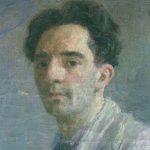
Abolhassan Khan Sadighi (1894 – 1995) was a prominent Iranian painter and sculptor. He was attracted to drawing and painting from an early age. During his high school days he went away to Master Kamal-ol-Molk’s classes at the School of Delicate Crafts. He soon became one of the most remarkable students of the school. During his next three years in that school, he succeeded in getting a high degree diploma in painting. Master Kamal-ol-Molk, seeing his talent and efficiency, appointed him as a teacher of painting and drawing at the school. Shortly after becoming a teacher, he became attracted to sculptures. At that time, the art of sculpture was almost unknown in Iran and Master Abolhassan Khan Sadighi’s work became the beginning of a new movement in the field in Iran.
He also taught at the Faculty of Fine Art of Tehran university for many years, running its sculpture section. He retired from the university in 1967 and soon after also from the art world as a whole.
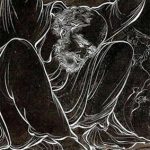
Hossein Behzad (1894 – 1968) was a prominent miniaturist from Tehran who tried to revive the Iranian miniature traditions. He also simplified Persian miniatures and introduced more Iranian elements into this tradition which had not changed since the Safavid period.
He became popular and internationally known as a Persian miniaturist and won many awards. In 1968 Behzad was give an honorary professorship by the College of Ornamental Arts. His works have been displayed across the world. To celebrate the millennium of Avicenna, in 1953 he held an exhibition at the Iran Bastan Museum. Shortly after, and to much critical acclaim, Behzad held an exhibition, which was sponsored by the French government, at the Museum of Modern Art in Paris. In 1956, fifty Behzad miniatures were put on display in the Library of Congress, Washington DC. As Behzad became a living master, he held exhibitions across the world including London, Prague, New York, Boston and Brussels, as well as in India and Japan. He created over 400 works. The “Behzad Museum”, located in Tehran’s Sa’d Abad Palace, holds the largest collection of his works.
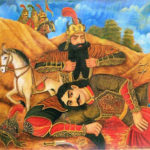
Hossein Qollar-Aghasi (born Tehran, Iran 1902–1966) was an Iranian painter. The son of Ali-Reza Ghollar-Aghasi, a a famous and experienced designer of tile-work patterns, he acquired rudimentary skills of traditional painting in his father’s workshop. He was one of the developers of “Coffee Shop Painting”, creating canvas works and mural frescoes based on religious traditions and national epics. Coffee shop painting was a new phenomenon in Iran’s art history. While preserving all the logical, religious and traditional style, it flourished as a sign of respect for popular beliefs. People needed images of their saints and their heroes.
Hossein Qollar-Aghasi was enraptured with vivid colors, and he sought every pretext to reproduce the lively tones found in ancient Iranian illuminations and tile-works in his paintings. Really, he was a decorative painter and a painter of the “School of Imagination”. During the forty years or so he painted; he trained a big number of students and put all his talent and faith at the service of developing “Coffee Shop Painting”.
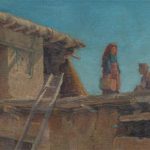
Abolhassan Etessami (1903 – 1978) was an Iranian architect, calligrapher, painter, and novelist. His father Ebrahim Etessami was the head of finance of the Iranian province of Azerbaijan; and his brother Yussef Etessami was the founder of the Bahar journal, and the father of the poet Parvin Etessami. Abolhassan Etessami was educated in Tehran at the Aghdasieh School, the American School, and the Kamal-ol-molk School of Fine Arts. Then he spent some years in Isfahan to learn architecture and decoration techniques, and later went to work at Tehran University.
Abolhassan Etessami produced a series of architecture projects, detailed maquettes of which were made by himself. On the Iranian Ministry of Fine Arts’ request, the maquettes were sent to Brussels’ 1958 Universal Exhibition, where Abolhassan Etessami was awarded the gold medal in the individual presentation category. The maquettes were later bought by the National Museum of Iran, and included in the permanent collection of the Islamic arts division. In addition to architecture projects, Abolhassan Etessami left a series of oil on canvas paintings including Some ruins in Dowlat-Abad, A village home in Niavaran, and Pasteur’s intercession for Napoleon, and some novels including, The left-alone man and The malicious Mohil-o-doleh.
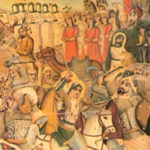
Mohammad Modabber (died in 1966) was an Iranian painter and was one of the developers of “Coffee Shop Painting” style.
He learned painting at Seyed Ghaffar Isfahani’s school. He resorted to the use of perspective and other elements of European religious painters.
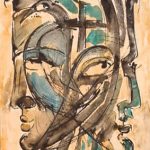
Houshang Pezeshknia (1917-1972).
He graduated from Istanbul Academy of Fine Arts where he studied under the supervision of prof. Leopold Levy. He held his first solo exhibition in 1947 in Tehran.
He was a follower of the Fauvist school emphasising strong colours and tones instead of representational or realistic forms.
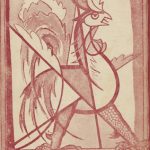
Jalil Ziapour (1920 – 1999) was born in Bandar-e Anzali and was a painter and university professor. He was one of the pioneers of modern art in Iran. Indeed, some consider him the “father of Iranian modern art”. He studied in the School of Fine Arts in Tehran. In the first period of the school (1941–1945) three painters graduated from the school and Ziapour received the first place. He then headed to France and continued studying in École nationale supérieure des Beaux-Arts.
He published a number of books and has left over 40 pieces of art. he was one of the founders of the “khoroos jangi” (Fighting Cock) art group.
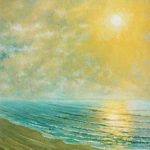
Mahmoud Javadipour (1920 – 2012) was a painter and graphic artist who is considered to be one of the pioneers of modern art in Iran. He graduated from The School of Fine Arts, University of Tehran. He then studied graphics at Munich Academy of Fine Arts. He was awarded a doctorate in fine art by the Iranian Cultural High Council.
He has left an enormous body of work with a range of styles in which he experimented. Although he remained a figurative painter he made a lasting contribution to modern art. A number of famous Iranian modernist painters were trainecd and influenced by him.
In 1949 together with Hosein Kazemi he established Apadana, the first private art gallery in Iran.
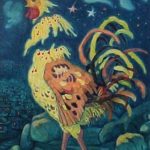
Abdollah Ameri born in 1922 in Tehran and a graduate of Tehran University\’s Academy of Fine Arts.
One-man show in the Talar-e Farhang, Tehran, and group shows in various galleries and cultural institutes including the Mehregan Club and in the Second and Third Tehran Biennales. Ameri’s post-Revolution works have not been publicly exhibited.
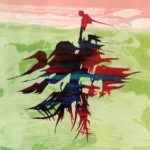
Sadegh Barirani was born in 1923 in Bandare Anzali in Iran. He studied at the School of Fine Art in Tehran University. He was part of The Fighting Roosters, a group that pushed the artwork in Iran to evolve with the rest of the world. The Fighting Roosters was a group of college students at the School of Fine Arts in Tehran University from 1948 to 1953. This group academically studied European modern art styles, though they were discouraged by their professors and constantly passed over for expositions. However, the group understood and appreciated modern art and allowed it to influence their classic training.
For his pieces, Barirani created a brush with both thick and thin bristles that required swift movements. Barirani’s technique was inspired by poems and became known as mystic lyricism. Barirani excelled and earned grants to travel to the United States and France to study at different universities. He placed in a number of world art competitions, and once he moved back to Tehran, he became a professor of fine arts. He is known in Tehran for creating hundreds of modern posters for events in the city, like shows, festivals and art events.
He now lives in California and is still evolving his artwork at 93 years old.
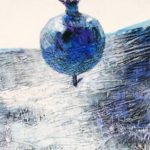
Hossein Kazemi (1924-1996) was a painter and one of the pioneers of contemporary art in Iran.
He was a graduate of Tehran University’s Fine Art school and became later a Professor and head of the Department of Painting in the Decorative Arts Faculty.
He had numerous solo or group exhibitions and has several works in private collections and museums. He received the gold medals of the 1st and 2nd Tehran Biennales.
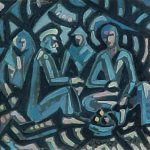
Ahmad Esfandiari (1922- 2013) was one the first graduates of the Tehran University’s Fine Arts faculty. He used modern Western combinations of familiar Iranian art motifs and elements such as miniature, batik, qalamkar, and tilework. He created a new eclectic style of his own. The resulting works remind one of the Impressionist and Post Impressionist styles with their warm and lively compositions and harmony.
The stylization of form and traditional motifs, attention to light, a colorful palette, and his constant experimentation have created an impressive amount of variety in his work including traditional forms, complete abstraction, expressionism, pointillism, and even Cézanne inspired works.
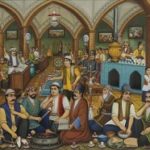
Abbas Blouki-far, born in Tehran, (1924-2009).
He has painted Coffee Shop Painting more than 50 years, while teaching at the University. He’s participated in more than 30 exhibitions in Iran and abroad; deceased.
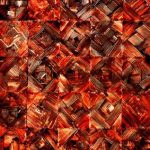
Behjat Sadr (1924 – 2009) was an Iranian painter whose works have been exhibited in major cities across the world. Sadr began her studies at the University of Tehran faculty of fine arts. After her graduation, she won a scholarship to the Accademia di Belle Arti in Rome at the Naples Academy of Fine Arts.
Sadr’s first major exhibition was at the twenty-eighth Venice Biennial in 1956. In 1957, Sadr returned to the University of Tehran as a member of faculty and taught there for almost 20 years. Sadr is regarded as one of Iran’s influential and radical Modern painters. She was a pioneer of the visual arts in Iran and one of the first women artists and professors to appear on the international biennales scene in the early 1960s. Sadr offers the singular testimony of a nascent cosmopolitan modernity that emerged in Tehran, Rome and Paris, in cities where she studied and exhibited, embodying an extraordinary fusion of work and life.
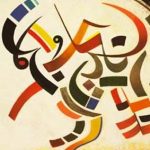
Mohsen Vaziri-Moghaddam (1924 – 2018) was an Iranian painter and a professor of art. He has been described as the “pioneer of modern Iranian abstraction.” He was a graduate of Fine Arts School, University of Tehran. In 1955 he moved to Italy for further studies. In 1958, he was awarded Diploma of Fine Arts from Accademia di Belle Arti of Rome. In 1964 he returned to Tehran as a Professor of Art at the Faculty of Decorative Arts and Faculty of Fine Arts of Tehran University.
After studying and analysing the new modern art movements in Italy Vaziri reached the conclusion that “painting is not a reconstruction of objective reality, but the artist has to create something that never existed before”.In 1957, a landmark year and turning point in his artistic career, he started experimenting with abstract art. His first abstract works date back to 1958-1959 and they fit in perfectly with the search for materials and brushstrokes happening in contemporary movements.
In 1985, Vaziri moved to Italy permanently with his wife and two children.
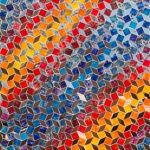
Monir Shahroudy Farmanfarmaian (1924 -2019) was an Iranian artist and collector of folk art. Her artistic practice weds the rigorous geometric patterns and cut-glass mosaic techniques of her Iranian heritage with the rhythms of modern Western geometric abstraction.
Farmanfarmaian studied at the Faculty of Fine Art, Tehran (1944-1946), before travelling to the United States. In New York she studied at Parsons School of Design and Cornell University, worked as a fashion illustrator, and was quickly absorbed into the city’s thriving avant garde art scene, became friends with artists and contemporaries Louise Nevelson, Jackson Pollock, Willem de Kooning, Barnett Newman, and Joan Mitchell. She painted, collaborated with Andy Warhol on illustrations for the now defunct Bonwit Teller department store, and under the tutelage of Milton Avery, she developed her talent for making monotype prints — some of which were presented at the Iran Pavilion during the 1958 Venice Biennale.
She returned to Iran in 1957 and began experimenting with techniques of reverse-glass painting, mirror mosaics, and the Sufi symbolism of classical geometrical design with a modern abstract expressionism and minimalism. “Ayeneh Kari” is the traditional art of cutting mirrors into small pieces and slivers, placing them in decorative shapes over plaster. Farmanfarmaian was the first contemporary artist to reinvent the traditional medium in a contemporary way. She soon reached international acclaim and held major exhibitions in Tehran, Paris, Venice and New York.
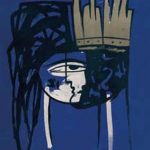
Marcos Grigorian (1925 – 2007) was a notable Iranian-Armenian artist and a pioneer of Iranian modern art.
Grigorian was born in Kropotkin, Russia, to an Armenian family from Kars who had fled that city to escape massacres when it was captured by Turkey in 1920. In 1930 the family moved from Kropotkin to Iran, living first in Tabriz, and then in Tehran. He Graduated in 1954 from the Accademia di Belle Arti in Rome. He then returned to Iran and opened the Galerie Esthétique. In 1958, under the auspices of the Ministry of Culture, he organized the first Tehran Biennial. Grigorian was also an influential teacher at the Fine Arts Academy, where he disseminated his enthusiasm for local popular culture, including tea-house paintings.
In 1975 Grigorian helped organize the group of free painters and sculptors in Tehran and was one of its founder members. Artists Gholamhossein Nami, Massoud Arabshahi, Morteza Momayez and Faramarz Pilaram were amongst the other members of the group. As a modernist pop artist Marcos Grigorian turned to ordinary objects and popular ethnic forms and approaches. He used ethnic food such as “Nan Sangak” and “Abghousht” to evoke authenticity in his work. Grigorian was a trend setter in experimenting with Earth Art, in Iran. Grigorian left Iran in 1977 living for a short time in the United States before moving to Yerevan, Armenia.
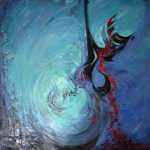
Mansoureh Hosseini (1926 – 2012) was an Iranian contemporary artist and one of the pioneers of the country’s modern art. She was educated at the University of Tehran, the Faculty of Fine Arts, from which she graduated in 1949. Mansoureh left Iran in the early 1950s to live in Italy, where she furthered her education at the Rome Academy of Fine Arts leading up to her artistic début at the 28th Venice Biennial in 1956.
After a moderately successful period in Italy, Mansoureh returned to Iran in 1959 and won several awards in the Tehran Painting Biennial. In 2004 she exhibited at the Tehran Museum of Contemporary Art. Mansoureh is best known for having produced works in both figurative and abstract styles. Her works have often included elements of Kufic script. She is known, along with Behjat Sadr, to use traditional elements of both the Persian culture and that of contemporary Europeans. She was considered to be an experimentalist.
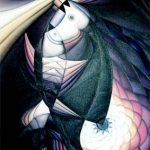
Bahram Alivandi (1928 – 2012) was an Iranian-born Modern artist living in Vienna. He is known primarily for his paintings, which typically depict stories from Persian mythology and literature, and express oriental mysticism. He has also produced a number of wall tapestries that, like his works on canvas, demonstrate his own instantly recognisable visual language.
He gained his artistic training in Tehran, initially at the Kamal-ol-Molk Academy of Art, then under the tuition of French masters at Tehran’s School of Fine Arts (closely modelled on the French École des Beaux-Arts), from which he graduated with distinction. He completed a further degree in painting at the College of Decorative Arts, Tehran. Alivandi was one of Iran’s modernists painters. He left Iran several years after the Islamic revolution of 1979 and lived and worked in Vienna from 1983 to 2012.
Alivandi’s work is rich in symbolism and oriental motifs. He draws influence from Persian culture, depicting characters and stories from legends and epic poetry. His works include a series of large-scale oil paintings executed in the 1980s which depict such important figures as Mithra, Jesus Christ, the Simorgh, and Ferdowsi. In terms of technique his work is at times traditional and at times highly original. Alivandi’s early paintings, including those from the 1980s, use the now-traditional medium of oil on canvas, yet his aesthetic style, which recalls the stained glass of medieval churches, is highly personal. During the 1990s Alivandi continued to work in oils, but abandoned the traditional canvas, choosing instead to apply his paints directly to newspaper; a method pioneered by the cubists in the early 1900s. Since circa 2000, he increasingly worked with the angelique pointillage technique.
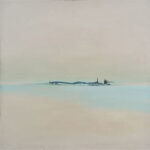
Abdolreza Daryabeigi (1930 – 2012), was an Iranian artist and innovator of Iranian modern art. Daryabeigi was born in Rasht in northern Iran. He studied and attained bachelor’s degrees in both World History and Geography from Tehran University. He studied art at the studios of both Marcos Grigorian and Ali Azargin. He first exhibited his work in 1960. He also took a further degree, in lithography, at the University of Salzburg in Austria.
In 1975 he joined the group of free painters and sculptors in Tehran founded by Marcos Grigorian. Artists Gholamhossein Nami, Massoud Arabshahi, Morteza Momayez, Sirāk Malkoniān and Faramarz Pilaram were amongst the other members of the group. In 1979, Daryabeigi moved to France and lived there until his death in 2012.
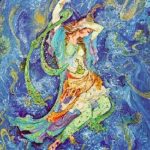
Mahmoud Farshchian (born January 24, 1930) is a Persian painter and miniaturist. He was born in the city of Isfahan in Iran, and it was here where he started to learn art, painting and sculpting. Farshchian is the founder of his own school in Iranian Painting, which adheres to classical form while making use of new techniques to broaden the scope of Iranian miniature painting. He has brought new life to this art form and has freed it from the symbiotic relationship it has historically had with poetry and literature, to give it an independence it had not previously enjoyed. His works have been hosted by several museums and exhibitions worldwide. He is the most prominent moderniser of the field of miniatures, an art form which was first established in Ancient Persia and later spread to China and Turkey and other Middle eastern countries. He has been exhibited in 57 individual shows and 86 group shows in Iran, Europe, America and Asian countries. His works are represented in several museums and major collections worldwide. Farshchian resides in New Jersey.
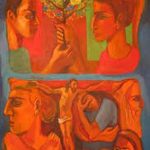
Hannibal Alkhas (1930 – 2010) born in Kermanshah was one of the forerunners of modern figurative painting in Iran. He was the son of the Assyrian writer Rabi Adai Alkhas.
He graduated from the Art Institute of Chicago in 1959 and taught at Tehran University (School of Fine Arts) from 1960-64. During the same period he established Gilgamesh Gallery, one of the first modern Art Galleries in Iran. Since then he has taught at a number of institutions including the University of California at Berkeley and Los Angeles. and Azad University in Tehran.
Hannibal experimented with different techniques and materials with the different “isms” of art but developed his own unique style of figurative painting. His paintings are featured in the Fine Arts Museum and Gallery of Modern Art in Tehran and the Helena d’ Museum in Tel Aviv.
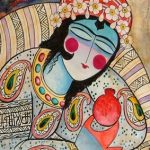
Jazeh Tabatabai (1931 –2008) was an Iranian avant-garde painter, poet, and sculptor. Tabatabai received over 10 major international awards for his paintings and sculptures. His works can be found in major collections and in many museums around the globe including the Louvre and the Metropolitan Museum of Art. Additionally, his works have been displayed in exhibitions in England, India, Italy, Germany, Spain Greece, Australia, France and the United States.
He was the founder and director of the Iran Modern Art Gallery in Tehran, Iran. He is considered as another painter of the saghakhaneh school.
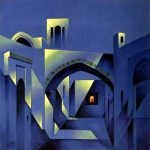
Parviz Kalantari (1931-) is an Iranian painter. He was born in 1931 in Taleghan city. From the early ages, he showed great interest in painting and later developed major skills in drawing. In 1959 Kalantari finished studying painting at Tehran University, Department of fine arts. He has held various exhibitions inside and outside of Iran.
His paintings are interesting yet simple, his simplicity and modest techniques make the paintings attractive to the audience and this minimalism is a theme that runs through his life. Parviz Kalantari’s current house was designed and built by his brother, Iraj Kalantari, one of the most influential Iranian architects whose dedication to Iran’s contemporary architecture is significant. The interesting aspect of parviz Kalantari’s works is that his subjects of interest are mainly architectural.
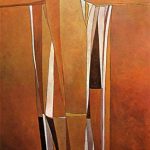
Sirak Melkonian (1931-) is an Iranian painter and graphic designer currently living in Toronto.
Sirak Melkonian was born in Fardoun Village, Iran in 1931. He studied painting with Marcos Grigorian, a pioneer of Iranian Modern art. In the 1950s, Melkonian was associated with Studio Démon, a small arts studio in Tehran that produced popular works.
He gained national recognition in 1957, winning a prize at the Contemporary Iranian Artist Exhibition of the Iran American Society. This was followed by the Imperial Court Prize at the Tehran Biennale in 1958 and first prize at the Paris Biennale in 1959. The artist has exhibited at the Grand Palais and the Salon De Montrouge in Paris, as well as Washington International.
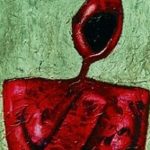
Bahman Mohasses (1931-2010) was a painter and sculptor and part of the modern art movement in Iran.
Bahman Mohasses was born in March 1931 in Rasht. He studied art at Tehran University. he later joined the “Cockfight” art and culture society (Anjoman-e Khorous Jangi), established by Jalil Ziapour, and was, for some time, the editor of the literary and art weekly “Panjeh Khoroos” (Rooster Foot). Through this society he was part of an avant-garde artistic movement, which included his good friend Nima Yooshij, the father of modern Persian poetry and Sohrab Sepehri, Houshang Irani and Gholamhossein Gharib, all progressive artists of their time. In 1954 he moved to Italy to study in the Fine Art Academy of Rome.
He has had a number of solo and group exhibitions in Italy and elsewhere. He returned to Iran in 1963. He stayed in Iran until 1968, before returning to Rome, where he received commissions for statutes to be placed in Tehran. Some of his public works in Iran were destroyed or damaged after the 1979 Revolution, with the artist subsequently destroying all his remaining works in Iran. He occasionally travelled to Iran and died in self-imposed seclusion in Rome in 2010.
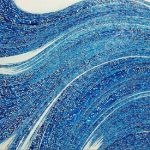
Nasrollah Afjei (1933-) is a calligrapher painter.
His first degree was from Iranian Calligraphists’ Association and he taught at Tehran Schools and Universities from 1997- 2004.
Afjei has focused on calligraphy. He has learnt different techniques and experienced with a variety of materials developing a unique style.
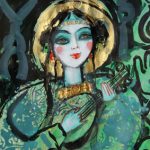
Naser Oveisi (1934-) is a painter and one of the influential followers of the Saqakhaneh style.
He has won numerous awards from international exhibitions and biennials.

Massoud Arabshahi ( 1935 -) is an Iranian painter.
Arabshahi held his first solo exhibition at the Iran-India Centre, Tehran, in 1964, four years before graduating from the College of Decorative Arts, Tehran. His work includes oils on canvas, sculptures and architectural reliefs- among the latter commissions for the Office for Industry and Mining, Tehran, 1971, and the California Insurance Building, Santa Rosa, California, USA, 1985.
His sources of inspiration comprise Achaemenid and Assyrian art as well as Babylonian carvings and inscriptions. Combining tradition and modernity. His work has been shown in a number of solo and group exhibitions in Iran, Europe and the United States including Two Modernist Iranian Pioneers, at the Tehran Museum of Contemporary Art, 2001; and Iranian Contemporary Art, Barbican Centre, London, 2001. He lives and works in Tehran and California.
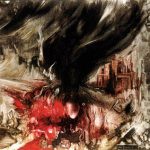
Iran Darroudi (1936 -) is an Iranian artist.
Darroudi studied at Ecole Superier des Beaux-Arts in Paris, history of art at the École du Louvre in Paris, stained glass at the Royal Academy of Brussels, and television direction and production at the R.C.A. Institute in New York. Darroudi’s first solo exhibition was held in Miami in 1958 at the invitation of the Florida State Art Centre. Her first exhibition in Iran was held in April 1960 at the Farhang Hall.
In 1968 she made a documentary about the 1968 Venice Biennial. She was appointed as an honorary professor at the Industrial University of Tehran, teaching art history. She held successful exhibitions in Paris and at the Atrium Artist Gallery, Geneva, and a month later at Galarie 21, Zurich. In 1974 a film on Darroudi’s life was broadcast on American television. She met Salvador Dalí and Tago Seizi. In 1976 she exhibited at the Mexican Museum of Art.
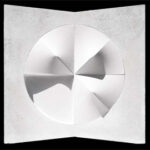
Gholamhossein Nami is an Iranian contemporary painter, author and educator who was born in 1936 in Ghom. He graduated from the School of Fine Arts, Tehran, Iran, 1963. He also holds a Master of Fine Arts degree from the University of Wisconsin, Milwaukee, 1980. In 1975 he joined the group of Free Painters and Sculptors in Tehran which Marcos Grigorian had helped to organize. Massoud Arabshahi, Morteza Momayez, Abdolreza Daryabeigi and Faramarz Pilaram were amongst the other members of the group.
He was also Instructor at the Secondary Schools of Fine Arts, Tehran, Iran, 1964-1986. Art. professor School Architect, Science, and Industry, Un iversity Tehran, Iran, 1972-1987, School Decorative Arts, Arts University, Tehran, Iran, 1973-1977, School of the Arts and Architecture, Free Islamic University, Tehran, since 1986. Vice chairman visual arts selection committee National Iranian Commission for Unesco, Tehran, 1973-1981.
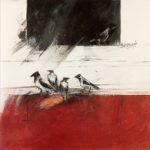
Manouchehr Motabar was born in Shiraz, Iran, in 1936. After graduating from the Tehran College of Fine Arts, he left Iran to take a graduate course in art education in Indiana, USA and participated in drawing courses at the Art Students League of New York. Since his return to Iran, he has been teaching painting and drawing in schools and colleges of visual arts in Tehran.
Since 1963, his work has been exhibited in national and international solo and group exhibitions and in 1985 he won the International Exhibition of Contemporary Painters Award in Monaco. Motabar was paid homage by the Imam Ali Museum in Tehran in 2006.
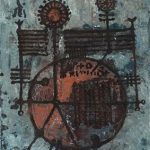
Mansoor Ghandriz (1936 – 1966 ) was an Iranian painter, born in Tabriz. He used Iranian forms in modern art and was one of the creators of the Saghakhane movement in Iranian painting. He studied at Tehran University, Faculty of Fine Arts. He alongside a number of other artists founded Iran Gallery which was one of the famous art galleries in Tehran. It has now changed name to Ghandriz Gallery.
While still in high school, Ghandriz was drawn to the progressive realist paintings of Ilya Repin (1844–1930) and Russian-Armenian seascape artist Ivan Aivazovsky (1817–1900). Later in college, and before turning to a paradigmatic exhortation of modernist language within local Iranian narrative, and developing his own semi-abstract style, he was introduced to European modernism, and he delved into the tradition of Russian realists and European classical and figurative art, Incorporating the figurative techniques of old masters, he created his own corporeal abstraction, which also indicates a process of gradual formalization, progressing from free forms to order. Matisse, Picasso, and Persian miniature paintings inspired Ghandriz’s early figurative work. He chose, as a critic commented, “mystical symbols to combine traditional and modern elements into his abstract designs.”
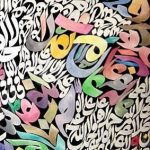
Charles Hossein Zenderoudi (1937 Tehran) is a renowned Iranian painter and sculptor, known especially as a pioneer of Iranian modern art. He is one of the founders of the saghakhaneh style. He is a graduate of Fine Arts from Tehran University. He also studied in Paris.
His interest in Iranian-Islamic traditions, his acquaintance with calligraphy and his affiliation and sympathy for traditions were what helped him to reach his own personal unique style. In the late 1950s that Zenderoudi created the Saqqa-khaneh movement. A reaction to Western art and the relentless clash between traditional and modernist Iranian art, the Saqqa-khaneh lobbied for the incorporation of national, folkloric and religious elements into Iranian art. In essence, Saqqa-khaneh took pride in Iranian-ness and sought to mesh Iranian heritage with Contemporary art, proposing a re-reading of cultural content by means of a referential continuity.
He left Iran for Paris in 1961 and chose painting as his career. He met artists like Alberto Giacometti, Stephen Poliakoff and Lucio Fontana and writers such as Eugène Ionesco. Zenderoudi has received many accolades and won many international awards, starting at the biennales of Venice in 1960 and São Paolo in 1961, when he was still in his early 20s. Following the 1963 acquisition by New York’s Museum of Modern Art of his K+L+32+H+4, which not only marked the first of his paintings to enter a major public collection but also served as a catalyst for other museums to follow suit, most of the world’s prominent art institutions have sought to include his works in their collections – London’s British Museum, Paris’s Centre Pompidou and Copenhagen’s Statens Museum, among others.
He has been living in Paris and New York since 1961.
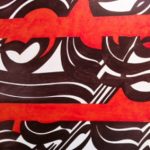
Faramarz Pilaram (1937 – 1982) was a calligrapher and one of the pioneers of saghakhaneh style. He studied painting and interior design graduating from Tehran’s College of Decorative Arts. He also studied for a year in France in 1970. where he stayed for a year.
He is renowned for his experiments with Farsi calligraphy and his reinterpretation of its traditional form, particularly the nasta’liq style of script. As a contemporary of Parviz Tanavoli, Massoud Arabshahi, Sadegh Tabrizi, and Charles Hossein Zenderoudi, Pilaram is widely regarded as one of the pioneers of the ‘Saqqakhaneh School’, particularly in his rendering of calligraphy.
Pilaram held numerous solo exhibitions in Tehran abd abroad. His work is held in collections including MoMA, New York, Tehran Museum of Contemporary Art, and Jahan-Nama Museum, Tehran.
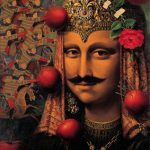
Ali Akbar Sadeghi (1937 – ) a graduate of the College of Fine Arts, University of Tehran, is an Iranian painters and artists. He is among the first individuals involved in the Centre for the Intellectual Development of Children and the Youth, and was among the founders of the Film Animation department of this institute.
In 1989 he founded Sabz Gallery, which was actively and continuously exhibiting the works of Iranian painters until 2003. In total, he has participated in over 25 individual and group exhibitions, over 7 volumes of books of the collection of his works have been published, and he has been a member of jury panels in over 10 biennial exhibitions. His style is surrealism based on Iranian forms and compositions.
Sadeghi’s style is a form of Persian surrealism, based on forms and compositions of traditional paintings, the use of Iranian iconography, and the use of Persian cultural motifs, signs and myths, full of movement and action, in prominent and genuine oil colors, in large frames, very personal, reminiscent of epic traditional Persian paintings and illustrations.
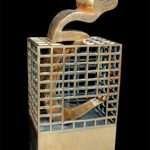
Parviz Tanavoli (1937 -) is an Iranian sculptor and painter. He has lived in Vancouver, Canada since 1989.
Tanavoli’s work has been auctioned around the world making him one of the most expensive living Iranian artist. Upon graduating from the Brera Academy of Milan in 1959, Tanavoli taught sculpture for three years at the Minneapolis College of Art and Design. He then returned to Iran and assumed the directorship of the sculpture department at the University of Tehran, a position he held for 18 years until 1979, when he retired from his teaching duties.
Since 1989 Tanavoli has lived and worked in Vancouver. His latest solo exhibition was a retrospective held in 2003 at the Tehran Museum of Contemporary Art. Prior to that he had held solo exhibitions in Austria, Italy, Germany, United States and Britain. His work has been displayed at the British Museum, the Grey Art Gallery, New York University, the Isfahan City Centre, Nelson Rockefeller Collection, New York, Olympic Park, Seoul, South Korea, the Royal Museum of Jordan, the Museum of Modern Art, Vienna, Museum of Modern Art, New York, Walker Art Centre, Minneapolis, Hamline University, St. Paul and Shiraz University, Iran. He belongs to Saghakhane group of artists. He has been influenced heavily by his country’s history and culture and traditions.
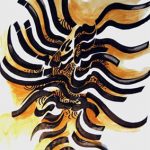
Sadegh Tabrizi (1938-2017) was a painter and calligrapher. He was a graduate of Tehran Academy of Decorative arts.
Since the early 60s he had been experimenting with calligraphy and is considered to be one of pioneers of the trend in contemporary Iranian art known as “calligraphy painting”. He moved closer to total abstraction in his latest works.
He experimented with many different forms in different periods but the common trend was the use of traditional motifs with new modern forms. The most intense period of Tabrizi’s career in terms of innovation and quality begins in 1970. Instead of saturating his work with illumination and page decoration, Tabrizi hints at Persian miniature painting by using inscriptions in the form of broken Nasta’liq to fill the negative space of the paintings. Here he realizes an important innovation that calligraphy can create abstract forms in free compositions. This is perhaps the most successful period of his career. Inspired by calligraphy, especially broken Nasta’liq as an abstract form on hide in black ink, Tabrizi is inspired by Persian calligraphy but goes beyond that to reveal itself as a completely abstract and expressive form. Works of this ninth period of Tabrizi’s career were exhibited during a solo exhibition first in 1970 at Burgese Gallery and then at Sirous Gallery in Paris.
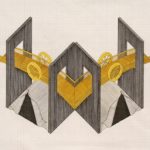
Siah Armajani (1939) is an Iranian-born American sculptor. He was born in Tehran but moved to USA in 1960 to attend Macalester College and has lived and worked in Minneapolis ever since,.
Siah Armajani designed the Olympic Torch presiding over the 1996 Summer Olympics in Atlanta, Georgia, United States. He has worked on other projects such as the New York Staten Island tower and bridge, the Round Gazebo in Nice, France, and the Irene Hixon Whitney Bridge in Minneapolis, Minnesota, United States. His 2005 work, Fallujah, is a modern take on Picasso’s Guernica but has been censored in the U.S. due to its critical view of the war in Iraq. One of Armajani’s important projects is located at North Shore Esplanade at St. George’s Ferry Terminal, Staten Island, NY. Armajani has said: “All buildings and all streets are ornaments. Moreover, the lighthouse and bridge gives a place to the representational arts of poetry, music, and performing. By embracing all of the arts, the lighthouse and bridge asserts its own perspective everywhere.
In 2010 he won a Fellow award granted by United States Artists. An exhibition at Muelensteen Gallery in 2011 presented a dozen of Armajani’s early pieces created in the years leading up to his arrival in America. Many employ ink or watercolor on cloth or paper, and incorporate text. In his “Shirt” (1958), Armajani uses pencil and ink to completely cover his father’s shirt in Persian script.
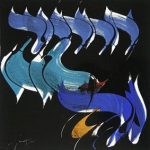
Mohammad Ehsai is a calligrapher and a teacher of this ancient art. Born in Qazvin, Iran in 1939, he attended Tehran University in 1966 to study fine art and traditional calligraphy, before going on the attain a teaching position there in 1971. His culturally loaded work has received international attention
He is one of those Iranian pioneers of “Naghashi Khat” or “Painting Calligraphy” whose works have been influential. Mohammad Ehsai’s stylized work is characterized by a melding of calligraphy, graphic design, and Modernist abstraction. Two-tone compositions of conflated symbols and scripts, painted on large-scale canvases, form the backbone of Ehsai’s practice. Featuring twisting forms and delicate symmetrical design, his paintings offer a uniquely global vision of the 20th and 21st centuries.
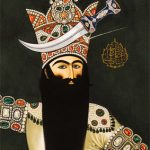
Aydin Aghdashloo (1940 -) is an author, art critic, art historian, painter and graphic designer. He currently lives in Tehran, Iran and lectures in different Iranian Universities besides his professional work.
Aghdashloo was appointed by Queen Farah Pahlavi, as the “Head of Artistic Affairs of Shahbanu’s Special Bureau”. His responsibilities included purchase of artworks from contemporary artists for the Tehran Museum of Contemporary Art. He also helped establish the Reza Abbasi Museum in Tehran in 1977 and was the head of the museum until 1979.
Early in his career, Aghdashloo took great interest in the Renaissance and Sandro Botticelli’s paintings in particular. He even used to test his own skills by copying Botticelli’s works to the last detail. His admiration for Renaissance paintings lead to the creation of his “Memories of Destruction” series in the early 1970s which became his most celebrated and famous series. In these series Aghdashloo depicts destruction of identity and beauty by painting a complete Renaissance masterpiece and then partially destroy or deface it. He also uses Persian miniatures extensively in his paintings after 1979. The crumpled Persian miniature series are the best example.
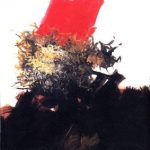
Kamran Katouzian (1941-) is a painter and graphic designer of long standing in Iranian modern art. He has been a representative of contemporary Iranian art in a number of international ar festivals. He is a graduate of Windham College, Putney, VT, USA and Tehran University’s School of Architecture.
Katuzian’s old attachment and interest in abstract expressionism evident in his works belonging to 1950s when still in New York not only has not diminished but with a half eye to Yves Klein’s tumulus works, he builds on it and pursues his unique personal world. His new creations possess pleasant colourfulness. He spreads his successive wide elongated strikes on the surface of huge canvases and with the rhythm of his short intertwining arches and spirals in a new scheme he provides an alternative to all that joyful tense insurrection and wildness.
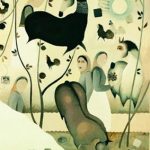
Mohammad Ali Taraghijah (1943 – 2010) was an Iranian painter. Even though he graduated from the College of Science & Technology in mechanical engineering, his heart was set on art. He went on to become one of the distinct figures of Iran’s contemporary art scene.
In 1968 he won the golden award in painting Art Competition in Iran. For two years he was working in Kerman City as an engineer, and became more familiar with desert landscapes as he painted mountains and deserts. After returning to Tehran, he participated in the Iran-France international exhibition and finished his engineering works forever. In 1994, the Teheran Museum of Contemporary Arts selected some of his works for the museum collection and printed a collection of these works. In 1998, UNICEF selected two of his paintings for their Christmas cards.
His works have been exhibited in Switzerland, Germany, Italy, France, the United States and Japan.
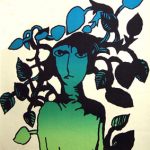
Farshid Mesghali (1943 -) is an Iranian animator, graphic designer, illustrator, and writer who has lived in the United States since 1986. He received the international Hans Christian Andersen Medal in 1974 for his “lasting contribution” as an children’s illustrator.
Mesghali studied painting at Tehran University and began his professional career as a graphic designer and illustrator in 1964. After graduation in 1968, he was supported by the Centre for the Intellectual Development of Children and Young Adults (CIDCYA) in Tehran. From 1970 to 1978 he made many of his award-winning animated films, posters for films and illustrations for children books under its auspices. In 1979 he moved to Paris. In the next four years he worked as an artist producing a number of paintings as well as sculptures, which were presented at Sammy King Gallery in Pairs.
In 1986 he moved to Southern California. He opened his graphic design studio, Desktop Studio in Los Angeles. From 1990 to 1994 he has created a series of digital artworks based on snapshot photos. They were exhibited in some galleries and later in L.A. County Museum of Modern Arts. At present he is working on a few sculptures and installation projects in his studio in Tehran.
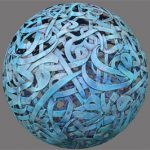
Mahmoud Zendehroudi (1943-) known as Zende is an Iranian artist living in France since 1978.
He became a journalist after leaving high school and painted for pleasure. In 1962 he exhibited some work at the 2nd Biennial of Tehran and at the International Exhibition of Tehran in 1970.
Zend left Iran in 1978 and settled in southern France. He then devoted himself entirely to painting and exhibits worldwide. His style is very particular mixture of all sorts of materials, collage, paper pulp sculpture and calligraphy,
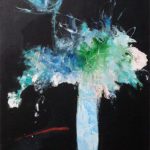
Farideh Lashai (1944 – 2013) was an Iranian painter, writer and translator. Her foremost book is Shal Bamu. But she is renowned for her abstract contemporary paintings. She was a graduate of the Academy of Decorative Arts, Vienna, Austria.
After finishing high school, she went to Germany. After studying in the school of translation in Munich, she went to Vienne to study decorative arts. She then worked for two years in Reidel company.
Her paintings combined the traditional art with contemporary art, including techniques deriving from late 17th century northern Europe. The traditions of Cezan, and those of the Far East are present in her works, and yet her works are considered to have a contemporary view of nature. Her works are considered a reflection inner insight and a perception of the soul of nature. She never intended to paint the details, but instead to create a symbol and vague understanding of nature, so that they would have the feeling of nature in them.
Ate the age of 68, after a long period of dealing with cancer, she died in Jam hospital in Tehran.
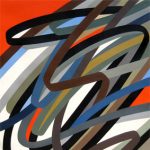
Koorosh Shishegaran is a contemporary painter who although influenced by the calligraphy-paint school has developed his own unique abstract style. Only the skeletal motifs of his abstractions could possibly be traced back to calligraphy. He was born in Ghazvin in 1944 but then moved to Tehran with his family. He is a graduate of School of Fine Arts and holds a BA in Decorative Art from Tehran University.
Shishegaran’s ability to humanize abstraction and bring three dimensions into his canvases and through the brush strokes and colours, make him one of the most expressive and emotive artists of the contemporary Iranian art movement. He says “We live in complex times: of breathlessness and excitement, of ties and confusions, of contradictions and mysteries, of disturbances and breakneck speed; of colour, exploding wonders and novelties; in short, a complicated world for today’s man. I have been trying to find a style or language expressive of the modern era. One that can be seen as pure painting yet rooted in my own country’s art and culture.”
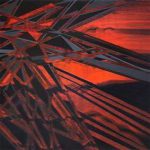
Shahla Dadsetan is a graduate of Fach Hoch Schule in Koln in architecture and Design (1962 – 1967).
After numerous architectural realizations Shahla Dadsetan chose to express herself through painting, She has then carried out extensive research into colour, techniques and abstraction. Her triple rich cultural background (Iranian father, Polish mother and an education in Germany) and her unique understanding of architecture, design and applied sciences has given her paintings a unique sense of space. She has created and developed a unique, organic and, aesthetic style of her own.
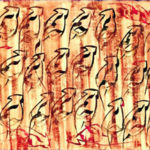
Hassan Makaremi is an Iranian painter, calligrapher, born in Shiraz, Iran, in 1950. Since 1983, he has settled and is currently working in France. He has a diploma from the Polytechnic University of Tehran, Amirkabir University of Technology and École Centrale Paris.
He has exhibited his work in France, U.S.A., Russia, Cuba and Morocco. The modern museum of calligraphy in Moscow is displaying seven of his works.
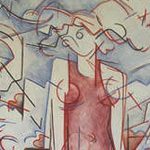
Iraj Zand (1950-2006) was a painter and a graduate of Fine Arts School of Tehran (1969) and also Ecole Nationale Superieure des beaux Arts de Paris (1980)
He participated in more than 35 painting and sculpture exhibitions in Iran and France and was an instructor of Art at Universities of Iran. He was also a board member of the first association for Iranian Painters .
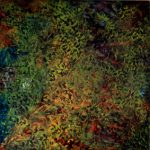
Ali Nassiri (1950-) is a highly regarded abstract painter born in Tehran who now lives in Washington DC.
Although he avoids publicity and dislikes the commercial art world he is one of the most talented of Iranian abstract painters. It is difficult to define his style. He has in over 40 years of painting produced many and varying styles. He himself considers his style as “no style”.
His canvases are what would make Knadinsky proud who believed a painting must directly appeal to your senses without any mediation or representation. In the sense that Nasiri’s painting are so expressive some have called his style abstract expressionism. But that would be inaccurate. These are no “action paintings”. His canvases are well planned and thought out with many carefully considered layers. Maybe a better label could be sensual abstractions. Looking at his paintings you would enter into a new world of visualising your sensations. He is the abstract painter par excellence. He has a lyrical-visual language of sensations all his own!
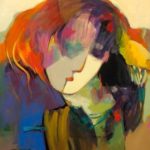
Hessam Abrishami was born in Shiraz, Iran, in 1951. He was greatly influenced by the ancient history surrounding him in his childhood. Seeking freedom from the limitations imposed on contemporary Iranian society, Hessam left his home country to expand his knowledge and awareness of the outside, changing world. His quest for artistic excellence took him to Italy where he began his higher education at the Academia di Belle Arti Pietro Vanucci in Perugia, Italy.
Hessam Abrishami is a master of vibrant colors, dynamic composition, and powerful expression. He has been professionally contributing to the contemporary art scene for more than forty years. Today, Hessam has countless private collectors worldwide and has exhibited in over 100 One-Man Gallery Shows, over 25 International Exhibitions and multiple Museums exhibits.
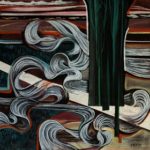
li Faramarzi was born in Tehran in 1950. He started his early private art classes in 1969 and in 1976 won the youngest artists Scholarship. He committed his first group Exhibition in 1977; two years later in 1979 he received the Encouragement Letter from Tehran Museum of art for Revival of the Museum; in the same year Ali Faramarzi held his first Workshop at Museum of Modern Art. His Second group Exhibition took place in 1980 at the Tehran Modern Art Museum.
His expertise in visual art training made him another great opportunity; He began to educate trainees in Iran‐Italy cultural Association in 1984. In 1988 he held his solo exhibition and 3rd group exhibition in Tehran Museum of Contemporary art. First Painting Association in Iran had a chance to have him as a Member of the board of directors in 1997. He was chosen as one of the best member of the board of directors of Gallery owner in Tehran
So far, he has held totally 26 solo exhibitions in Tehran and other countries, such as Qatar, Singapore, Pakistan, Italy, South Korea, China and North America; and attended over 51 group exhibitions both in Tehran, Iran and other countries for instance North America, Qatar and Pakistan.
Reza Derakshani (born 1952) is a multi-talented painter, poet, musician and performance artist. A child prodigy, Reza Derakshani received his first commission at the age of nine and held his first solo exhibition at the age of 19 at the renowned Ghandriz Art Gallery in Tehran, going on to exhibit internationally. Derakshani graduated from the University of Tehran in 1976. He continued his studies at the Pasadena School of Art in California, and returned to Iran to teach at the University of Tehran and the School of Decorative Arts. He left Iran in 1983 and went to live in the city of New York.
The artist became engrossed in Abstract Expressionism while living in New York and was soon associated with the revival of painting in the USA and Europe in the 1980s through the Neo-Expressionist style. Whilst being loosely affiliated to the movement and evolving in New York artistic circles with fellow artists and friends Francesco Clemente, Shirin Neshat, Alessandro and Cy Twombly, the experience of emigration led Derakshani to reconnect with his Iranian roots. After experimenting with pure abstraction, the artist devised his personal artistic style blending abstract and figurative elements from both Western and Eastern cultures, thereby creating an idiosyncratic oeuvre at the confluence of civilizations.
The artist subsequently moved to Italy, before returning again to Iran for seven years. He now divides his time between Dubai, UAE and Austin, USA, where in parallel to his career within visual arts, he collaborated with legendary musicians such as John Densmore, the drummer of the Doors, releasing a critically acclaimed album. Reza Derakshani is known both in the Middle East and in the West as one of the most significant contemporary Iranian artists. His work features in many public art collections including The British Museum, London; The Metropolitan Museum of Art, New York; The Tehran Museum of Contemporary Art; The Russian Museum in St Petersburg, Russia and the Kunstsammlungen Chemnitz, Germany.
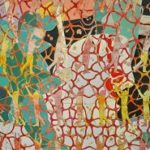
Roya Akhavan was born in Tehran, Iran in 1953. She graduated with a BFA in Art from Simmons College in Boston in 1974. She also attended the Arts Students League in New York City and the Ecole Nationale Supérieure des Arts Decoratifs in Paris.
Akhavan’s expressive work employs repetition and pattern as an instrument for metaphor. She builds upon traditional Persian painting techniques, creating a fresh visual aesthetic and engaging fragmentation as a style.
Akhavan has had several solo exhibitions, including Nexus in 2009 at Leila Heller Gallery, and at Galerie Transversale in Paris in 1998. Her work has appeared in a number of group exhibitions worldwide, such as at Art Dubai and Art Abu Dhabi.
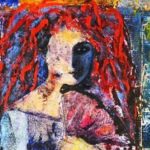
Fariba Ameri was born in 1959 in Tehran. She began to paint at age 14, enchanted by a book about Van Gogh’s life. Fariba fell in love with Van Gogh’s style and the emotional intensity of his paintings. She moved to the United States in 1977 to attend the University of Southern California (USC). She has now made California her permanent home.
Ameri’s most intense bodies of work have been produced since 2010 when she began to work full time in her studio in Santa Monica, California. Her work has been shown in multiple exhibitions in California. She has developed a unique style of expression in her paintings that is self-reflective and honest. Her unpretentious approach to painting reflects her life experiences through a non-traditional use of mixed media, intense colour, and surface tension which foster a personal connection with the viewer. Drawing on Persian mythological themes for their powerful imagery, she brings an emotional and intellectual intensity to each canvas.
Ameri’s work is influenced by her personal experiences as a woman with a diverse heritage. Her primitive style produces a sense of urgency, presence and movement. Her inimitable fusion of form and content is powerful, dramatic and emotional.
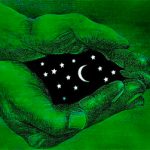
Ali Divandari ( 1957 -) is an Iranian Cartoonist, Painter, Graphic Designer, Sculptor and Journalist.
Divandari studied Graphics at the Faculty of Fine Arts in Tehran University. He began his career as Graphic Designer and Cartoonist in 1975. In 1997, He directed a new International Cartoon Festival in Iran with a main theme of “man and Nature – Only one, Share & Care”. Over his career, Divandari was a jury member of several cartoon exhibitions in Iran and Turkey. His works have been published in many international newspapers and magazines and have been exhibited in over than 34 countries.
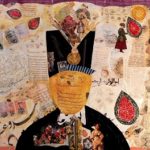
Shiva Pakdel born in 1958 is an artist, curator, and a collector. With more than 30 years of marketing and advertising experience, she offers a unique sampling of her art and that of the artists she represents. Her lifelong project is centred around defining Iran through its art and imagery as she believes art has the power to communicate a better understanding of our differences and therefore create a connection. Shiva Pakdel currently lives in Novato, CA; and previously lived in San Rafael, CA, San Francisco, CA and San Francisco, CA. She currently works as a Marketing Director at AT&T Advertising and Publishing Services.
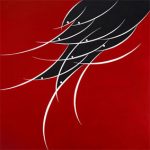
Amir Sadegh Tehrani (1959-) is a calligrapher and graphic designer. He has a degree in calligraphy (1981-1984 – Iranian association of calligraphy) and in graphics (1989-1993 – Faculty of fine arts, University of Tehran).
Mostafa Dashti (1960 -) is a painter. He has studied painting and calligraphy under the tuition of Aidin Aghadashlou, the late Seyed Ahmad Abtahi and Abdulah Faradi.
His early work depicted powerful desert scenes. This relationship with landscapes, whether natural or human created, has continued over the years and is still apparent in most of his work today. In recent years he has used a more abstract mode of communication and some of his work have indeed been abstract compositions. He has also preferred the use of darker colours.
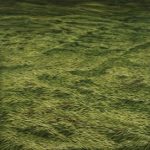
Flora Feizbakhsh was born in June 1958, Babol. She has a BSc in Social Economy, University of Tehran. She is also a Member of Iranian Painters Association.
She has been a professional painter with more than 15 years of experience, having good knowledge of figurative study rules and styles of painting. She started to experience abstract painting, using symbols and female inner metaphors and expressing them in artistic motifs of painting. She has held 10 solo exhibitions and more than 40 group exhibitions in Iran and abroad.
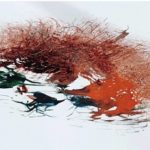
Zoya Tavakoli was born in Shiraz, Iran. On the long way of building up her own personal style in painting, Zoya was greatly benefited and deeply influenced by lessons of the two well-known artists, Irandokht Mohasses and Mohsen Vaziri Moqaddam. She started her serious engagement in 1985.
She attended some painting courses at University of Soureh in Shiraz, where she instructed fundamentals of painting for two semesters later. Since 2012, Zoya Tavakoli held long-time workshop for children and young adults of her town and led them to win international prizes. Zoya considers this experience of working with children very fruitful and inspiring that fostered her attitude and abled her of exquisitely visualizing her momentary impressions. Zoya Tavakoli was a juror at Cinewest Short Film Festival at Sydney, Australia, 2008
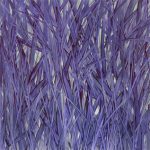
Reza Khodadadi is a contempora y Iranian artist born in Ardabil (1961) and living and working in Tehran. He is an academic, a painter, sculptor, Urban artist and Muralist. He teaches art at Tehran University of Art and is the author of a number of well received books in the field of urban murals. He has been involved in a major study project: “The Murals of Tehran: musts and musts not”
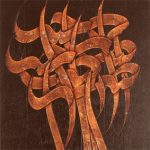
Ali Shirazi (1960 -) is a calligrapher and painter.
He received the ” Distinction ” certificate from the Iranian Calligraphy Society, Shirazi worked for a while as the Head of Esfahan Calligraphy Society but moved to Tehran in 1988. He was elected as the member of the high council of the Iranian Calligraphy Society.
He has produced over a 100 works and has exhibited in a number of solo and mixed group exhibitions.
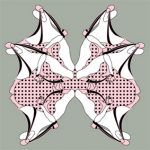
Parastou Forouhar (1962-) was born in Tehran, where she studied art at the University of Tehran from 1984 to 1990 and continued her studies at the Hochschule für Gestaltung in Offenbach am Main, Germany. She has exhibited internationally, including as part of Global Feminisms (2007) at the Brooklyn Museum. In 1998, Forouhar’s parents were murdered because of their political beliefs, and many of her works express a critical attitude toward Iranian politics and Islamic Fundamentalism.

Farhad Moshiri (1963-) is an Iranian artist currently based in Tehran.
Moshiri studied fine arts at CalArts in Pasadena, California, in the 1980s, where he first started experimenting with installations, video art and painting, before moving back to Tehran in 1991. He subsequently became well known for his ironic interpretations of hybrids between traditional Iranian forms and those of the consumerist and globalized popular culture widespread in his country.
His work is held in several public collections, including the Virginia Museum of Fine Arts, Richmond, the Farjam Collection, Dubai, and the British Museum, London.
He is represented by The Third Line, Dubai, Galerie Emmanuel Perrotin in Paris, Rodolphe Janssen in Brussels, and Thaddeus Ropac in Salzburg.
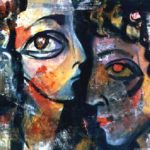
Farzaneh Ghoreishi (born in Ghaem-Shahr, 1962) is an Iranian painter. She studied at Azad University (1994-1999) and has had a number of solo and group exhibitions.
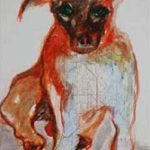
Akram Abouee (1964 -) is an Iranian painter. She has been living in Germany since 1996.
A literature graduate who studied art under Hannibal Alkhas and Parviz Kalantari She also studied at Tehran’s modern Academy under Roueen Pakbaz. She has had a number of solo and group exhibitions and has also published three books about her work.
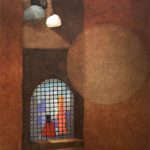
Rezvan Sadeghzadeh (1964 -) is an Iranian painter whose poignant paintings comment on the situation of women in a male-dominated society. But they are also about the human condition in general. The figures in Sadeghzadeh’s paintings are always women. He attributes this to the bond he shares with his mother. “As a child I was very close to my mother and troubled her a lot. When I was at university, ‘mother’ became the central theme of my work, and this abstract female figure became a part of my mind and my life. Today, in my daily life I see women struggling with the restrictions, injustices and suppression imposed on them by society. So this figure has stayed in my work, acquiring multiple meanings,” he says.
Other recurring elements in his work include stones, bayonets, candles, doors, chairs and sandals. These are all everyday things that he sees in and around his home. But in his paintings they acquire multiple meanings. A candle, which is lit to celebrate a birthday as well as to mourn a death, becomes a symbol of both hope and loss. The bayonet, used in war, also looks like a cypress tree that signifies peace and freedom. The empty chair could represent an absent figure, a position in society, or memories of a place. And the stones too can be seen as a symbol of invasion and war, or of fortitude and patience.
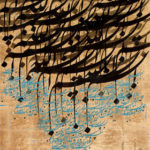
Ahmad Mohammadpour (1965-) is a painter calligrapher. He graduated from the Iranian Calligraphers Association. He also teaches calligraphy. He has had many solo and group exhibitions both in Iran and abroad..
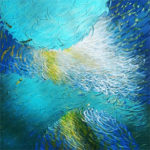
Khalil Koiki (1965-) is a calligrapher painter. He has a post-graduate degree from the Association of Iranian Calligraphers. He teaches at Shariaty University, Tehran.
Koiki has taken part in more than 50 group exhibition inside and outside of Iran.
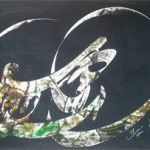
Bahram Hanafi (1966-)
He studied handicrafts and has a post graduate degree in Art Research. He has been teaching history of art and applied art since 1985. He is involved in research about “Book Making” and its connected Arts.
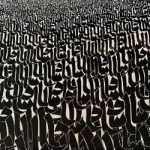
Azra Aghighi Bakhshayeshi, (1968-) is one of the few professional female calligraphic artist working in Iran. She is a descendent of the famous court Calligrapher Mirza Karim Khoshnevish Tabhari, Her work explores the rich aesthetic possibilities inherent in the internal architecture of Persian script. For her, there is beauty not just in the meaning letters express but also in the form and texture of those letters.
Aghighi, who considers herself a “Painter’s Scribe,” has found a way to express beauty with words – but in a non-literary way. For her, viewers need not understand the meaning of the letters and words to gain access to the meaning of her art; in fact, not understanding the words is exactly what she wants from viewers:
While Aghighi is inspired by religion the heart of her practice is not religious: “it is not my intention to pass [my religious inspirations] on to the viewer… I am trying to show the viewer that my artistic inspiration continues to be part of a rich heritage from the golden treasure of Middle Eastern culture.”
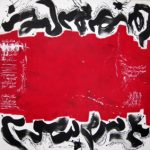
Golnaz Fathi (1972 -) is a contemporary Iranian artist.
Whilst studying Graphic Design at Azad University in Tehran, Fathi became fascinated by the expressive potential of traditional Persian calligraphic forms and immersed herself in a sustained six-year study of traditional calligraphy, where she became one of only a handful of women trained to the highest level within that discipline.
Fathi investigated ever more abstract forms of representation, using modern media to aid these explorations, whilst still basing her work on fundamental calligraphic practices and techniques. The introduction of bold swatches of colour further emphasised her transition to an alternative idiom that gave precedence to her own imaginative modes of subjective expression.
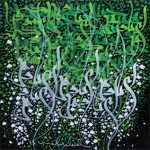
Mehrdad Shoghi (1972-) is a painter and graphic designer.
He is a graduate of Azad University, Tehran, in Graphic Design, He studied Traditional Persian Painting, Calligraphy, Illumination and Restoration under the guidance of Aydin Aghdashloo & Biuk Ahmari. He also has a diploma from the, Academy of Traditional Persian Calligraphy, Tehran.
He has held many solo and group exhibitions and some of his murals are installed in different stations of Tehran’s Subway Stations.
Robabeh Hoseinpour (1974 -) is a graduate of the Calligraphers Association and has taught calligraphy herself for many years. She has been working at the Centre for the Intellectual Development of Children and Adolescents since 1997.
Her first solo exhibition of Persian poetry with the poetry of Simin Behbahani and to commemorate her 85th birthday was held in 2012.
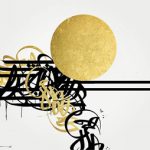
Sasan Nasernia (born in 1974) is a painter calligrapher.
Nasernia is one of the modern calligraphy painters that emerged in the wake of the pioneering works of artists such as Mohammad Ehsaie, Hosein Zendehroodi and Faramarz Pilaram.
As a graphic artist, he started with digital typography under the influence of Reza Abedini at Azad Art University, Tehran where he graduated with a bachelor’s degree in graphic design and fine art. There, he absorbed an acute attention to form associated with modern typography and later developed a kind of vocabulary that emerged through his focus on the deformation of letters and of intersection between graphic, calligraphy and painting. Currently he works mainly on large sized acrylic paintings.
He has had numerous solo and group shows in Tehran and Dubai. He currently lives and works in Dubai, United Arab Emirates.

Afshin Pirhashemi (1974-) is an Iranian painter. He is a graduate of arts from Azad University, Tehran. He also studied in Italy for a short period. His works examine the complexities of life in modern day Iran. Often on sparse or empty backgrounds, his largely monochromatic, photo-realistic depictions of women attempt an exploration of issues of contemporary social and political identity in Iran.
His works are housed in public and private collections throughout the Middle East and Europe and he is the recipient of awards from the 2003 Tehran 6th International Art Biennial, and the 2004 Beijing Art Biennial Award. Solo exhibitions include Homa art Gallery, Tehran (2009); Seyhoun Art Gallery, Tehran (2005); and Barg Gallery, Tehran (2005). Group exhibitions include In & Out, Milan (2009); Tehran Museum of Contemporary Art, Tehran (2006); Museum of Contemporary Art, Tehran (2004, 2003).

Shiva Ahmadi (born 1975) is an Iranian-American artist known for her paintings, videos and installations, which have been exhibited at galleries and museums in North America and the Middle East. Ahmadi was born in Tehran, Iran. Her upbringing, which is reflected in her art, was marked by the Iranian Revolution and the Iran–Iraq War. She obtained a bachelor of fine art from Azad University in 1998 and right after moved to USA to pursue her graduate studies. She completed her first MFA in drawing from Wayne State University in 2003. In 2005 Ahmadi obtained her second MFA, in painting, at the Cranbrook Academy of Art. Ahmadi was appointed as an Associate Professor of Art at the University of California, Davis in 2015.
Ahmadi’s practice borrows from the artistic traditions of Iran and the Middle East to critically examine contemporary political tensions. Incorporating cultural symbols Ahmadi has taken a critical look at current social and political issues. Her work often mirrors the patterned design of Persian miniatures and has included embedded depictions of war, corruption or religion. Known for her achievements in painting, her later career has been marked by the use of video-animation. Her first animation Lotus was exhibited extensively in US and around the world and gained recognition from many critics and curators. Her latest animation titled Ascend (2017) was inspired by the death of Aylan Kurdi and Syrian refugee crisis in 2015. Ahmadi’s work is included in the collections of the Museum of Contemporary Art in Los Angeles, the Asia Society Museum, the Detroit Institute of Arts, the DePaul Art Museum, the Morgan Library & Museum, the Asian Art Museum in San Francisco, the TDIC Corporate Collection in the United Arab Emirates, and the Farjam Collection in Dubai.
Kamrooz Aram (1978) is a contemporary artist whose work explores the complicated relationship between traditional non-Western art and Western Modernism. His work uses iconography as well as abstraction, revealing the essential role that ornament played in the development of Modern art in the West. Taking floral motifs from Persian carpets, Aram repeatedly reconfigures them into painterly mediations resulting in images, always in a state of flux.
Aram received his master’s degree in Fine Arts from Columbia University in 2003. He lives and works in Brooklyn, New York. His work has been featured and reviewed widely in publications such as Art in America, Artforum.com, The New York Times, Asian Art Newspaper, The Village Voice and the arts and culture segment on BBC Persian: Tamasha. Aram’s recent solo and two-person exhibitions include Ornament for Indifferent Architecture, Museum Dhondt-Dhaenens, Deurle, Belgium (2017); Recollections for a Room, Green Art Gallery, Dubai, UAE (2016); Unstable Paintings for Anxious Interiors at Green Art Gallery, Dubai, UAE (2014); Kamrooz Aram/Julie Weitz at The Suburban, Chicago, Illinois (2013). Current and upcoming exhibitions include a solo exhibition, Ancient Blue Ornament, at the Atlanta Contemporary, Atlanta, Georgia in January 2018, a two-person exhibition with the work of Anwar Jalal Shemza at the Hales Project Room, New York in January 2018, and FOCUS: Kamrooz Aram at The Modern, Fort Worth, Texas in March 2018.
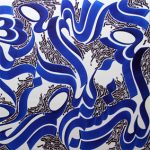
Ebrahim Olfat (1979) is a calligrapher painter and a member of Calligraphers Association.
He has held a number of solo and group exhibitions and won a number of international prizes for his work
The Musée d’Art Moderne de la Ville de Paris is presenting “Unedited History, Iran 1960-2014” at ARC. Comprising over 200 works for the most part never shown in France before, the exhibition brings a fresh eye to art and visual culture in Iran from the 1960s up to the present. Its survey of the contemporary history of the country is arranged in sequences; the years 1960–1970, the revolutionary era of 1979, the Iran-Iraq war (1980–1988) and the postwar period up until today.
“Unedited History” will run from May 16 to 24 August, 2014 at The Musée d’Art Moderne de la Ville de Paris.
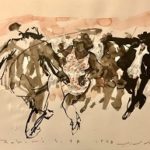
Born in 1980, Rahimi grew up in Tehran where he currently resides. Mohammad was chosen as one of fourteen of Iran’s most notable painters in 2007 and travelled to Washington D.C. to display his art in the Meridian Exhibition.
He began pursuing his career as an artist starting at university where he studied painting. Rahimi’s works focus on an abstract expression and surrealist style. Well known in the Iranian art scene, Rahimi has exhibited extensively in Iran as well as across the globe including USA, UAE and South Korea.
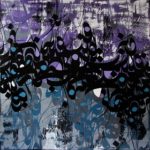
Babak Rashvand (born 1980 in Tehran-Iran) is an Iranian painter/calligrapher educated at Tehran University-Faculty of Fine Arts. He receive his master degree in Visual Communication,in 2009.
He has held a number of solo exhibitions at Shirin Art Gallery Tehran, 8 Gallery, London, Seyhoun Art Gallery, Tehran, Shokouh Art Gallery, Tehran.
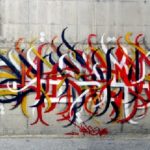
A1One is the pseudonym of Karan Reshad (born 1981), an Iranian visual artist who pioneered graffiti and street art in Iran. His career as a street artist began in his hometown, Tehran. A1one grew up in Iran during a period of war and the Khatami reform era (1997-2005). A1one studied for 5 years at the Art and architecture university in Tehran. While still a student, he began using graffiti around the university campus, as a protest against student conditions. He was eventually expelled from the University after which his graffiti activities in the city of Tehran increased. A1one was the first person to start painting on the city walls. His name can be interpreted as “Alone” or “First One.” A1one started painting walls in the late 1990s. He is the pioneer of the urban art scene in Middle East. When he began, it was a time when nobody knew what graffiti was in his country. He had a very influential role in the rise of street art and stenciling within Iran.
By 2010, A1One was an established name within Tehran’s youth culture and a key figure in the emergence of Iranian street art/ A1one’s art world is dynamic and made of many different styles, from portraits to calligraphy and funky characters which he mostly uses for his stickers. A1one has been working on a distinctly Iranian style of calligraffiti, which is “a fusion of hip-hop graffiti and Persian typography.” His style is recognised across the Islamic graffiti world.
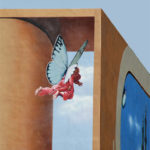
Mehdi Ghadyanloo (1981) is an Iranian painter. known for his utopian and philosophical paintings that interrogate universal human precepts such as fear, hope and loss. His work makes use of trompe-l’œil and shows the influence of Surrealism; he has been compared to Magritte. Through the portrayal of minimal heterotopic environments, surreal architectural arrangements, and the repeated use of symbolic elements such as stairs, balloons and aeroplanes, Ghadyanloo invites us to consider new realities and the shared universality of our existence. In 2006, on commission from the city of Tehran authorities, he started painting large-scale murals on bare walls in the city of Tehran; he has painted more than 100 of them. In 2015 he visited London for an exhibition of his “indoor” paintings, and painted murals there also, including one in Shoreditch.

An International Seminar on ˈWorld Studies on Shakespeareˈ will be held at Tehran University on September 22-23. Topics for discussion in the seminar include ˈShakespeare and Iranian attitudeˈ, ˈShakespeare from eastern perspectiveˈ, ˈShakespeare and Mysticismˈ, ˈShakespeare and political discourseˈ and ˈShakespeare and cinemaˈ.
“Burnt Generation” is the title of an exhibition of work by eight contemporary Iranian photographers which is currently held at The Terrace Rooms, Somerset House, The Strand in London. On view from 10th April until 31st May, 2014, the exhibition has been organized by Candlestar and showcases works by Azadeh Akhlaghi; Gohar Dashti; Shadi Ghadirian; Babak Kazemi; Abbas Kowsari; Ali Nadjian/Ramyar Manouchehrzadeh; Newsha Tavakolian and Sadegh Tirafkan.
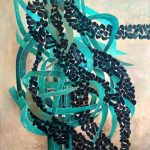
Maryam Ghanbarian (1987) is an Iranian painter/calligrapher and has a post graduate degree in graphics from the Faculty of Fine Arts, the University of Tehran, Iran.
Maryam is interested in combining Persian calligraphic forms and elements of nature to show the similarity and universality of both in her paintings. She has participated in several Solo and Group exhibitions including: Illuminating the Word, Kashya Hildebrand Gallery, London,2015. Grand Opening of Shirazi Art Gallery, Melbourne 2015, Opera Gallery, London 2013. Les Mots Devoiles, Geneva, 2012. Solo Exhibition in Shirin Gallery Tehran, 2013 and ProArt Gallery, Dubai 2015. She has won a number of awards including the special award in the first international visual arts festival of ECO (Global celebrations of Norooz).
California State University, L.A. will host an exhibition of contemporary Iranian photography scheduled to open on April 12, 2014, at the Fine Arts Gallery of California State Los Angeles. Curated by Abbas Daneshvari, Simin Dehghani, and Marjan Asgari, the exhibit showcases works by a group of Iranian contemporary photographers such as Mohammad Ghazali, Shirin Aliabadi, Parastou Forouhar, Peyman Hooshmandzadeh, Sadegh tirafkan, and others
Iranian filmmaker Mehran Tammadon won the Grand Prize of Cinéma du Réel film festival in Paris for his documentary entitled “Iranien”. The filmmaker, an Iranian living in France, invites three religious people to live in his family home. His purpose is to see how life in their shared living room can lead to the first rules of co-existence.

A group of Iranian artists represented by the Tehran based gallery “Shirin”, are to participate in the second annual edition of London Art Fair, which will be held in London’s Olympia Grand Hall, in West Kensington from February 28 to March 2, 2014.
Los Angeles, Wilshire Ebbel Theatre, 9th Feb 2014
An international, collaborative project, based at Columbia University in New York. It is a research tool dedicated to the study of Iranian civilization. The academic reference work will eventually cover all aspects of Iranian history and culture as well as all Iranian languages and literatures, facilitating the whole range of Iranian studies research
Farhang Foundation (Iranian American Heritage Foundation of Southern California) is a non-religious, non-political, and not-for-profit foundation established in 2008 in Los Angeles to celebrate and to promote the study and research of Iranian art and culture for the benefit of the community at large.
Baroness Cox, a cross-bench member of the British House of Lords was the Deputy Speaker of the House from 1985 to 2004. She is also the Chair of the British Armenia All-Party Parliamentary Group and the Chancellor of Liverpool Hope University.
She is the founder of The Humanitarian Aid Relief Trust (HART), which works to provide change through aid for that suffering persecution. Baroness Cox travels to HART-funded aid and advocacy programmes in Nagorno Karabagh, East and West Burma, East Timor, India, Nigeria, southern Sudan and northern Uganda.
Baroness Cox is a patron of the Toos Foundation and has supported its activities from its early beginnings.
Hafez – Wikipedia >>>
Hafez – Iranica >>>
Life and poetry of Khajeh Shamseddin Mohammad Hafiz Shirazi >>>
Sonnets of Khajeh Hafez Shirazi >>>
Hafez poetry on Ganjoor network (in Persian) >>>
A selection of Ghazaliyate Hafez in English and Farsi >>>
Hafez: Dance of Life – Poetry Read In Persian and English – Mage Publishers >>>
Introduction Shams al-Din Hafez Shirazi >>>
Mohammad Reza Darvishi recreating Abdolqader Maraghi music >>>
The National Iranian Photographer’s Society is organising “10 Days with Photographers”. The exhibition is not aimed at individual photos but to display “Photo Projects” of Iranian photographers over the last 35 years.
Nikol Faridani, Fakhreddin Fakhreddini, Maryam Zandi, Kaveh Golestan, Mohammad Farnud, Ebrahim Haqiqi, Mahmud Kalari and Samad Qorbanzadeh are among the photographers whose works have been selected for the exhibition.
“Barekat”, a production of Islamic Republic of Iran Broadcasting (IRIB), has won a Gold Panda Award for Best Short Documentary at the 2013 Sichuan TV Festival, which ran from November 16 to 18 in Chengdu, China. The Gold Panda was handed to director Ali-Akbar Kazemi during the closing ceremony, IRIB announced in a press release on Monday.
“Barekat” is a non-verbal documentary featuring the historical process of producing bread from farm to bakery, examining the traditional method of baking in Iran.
Mohammad Reza Shajarian – NPR Music, Tiny Desk Concert >>>
Mohammad Reza Shajarian – Silent Lute (Saze Khamoosh) >>>
Mohammad Reza Shajarian – Aah Iran >>>
Mohammad Reza Shajarian and the Pournazeri brothers >>>
Mohammad-Reza Shajarian tour >>>
Mohammad Reza Shajarian – Iran >>>
Mohammad Reza Shajarian – Rendan Mast >>>
Mohammad Reza Shajarian – Saghia >>>
Mohammad Reza Shajarian, Kayhan Kalhor >>>
Mohammad Reza Shajarian – Golha No 147 >>>
Kayhan Kalhor and Rembrandt Trio – The Opening >>>
Kayhan Kalhor and Rembrandt Trio – Chaharpareh >>>
Kayhan Kalhor & Erdal Erzincan – Live in Tahran (2012) >>>
Kayhan Kalhor – Brooklyn Rider Ensemble – Ascending Bird >>>
Kayhan Kalhor – NPR Music Tiny Desk Concert >>>
Kayhan Kalhor & Yo-Yo Ma – Morghe Sahar >>>
Kayhan Kalhor in Concert >>>
Kayhan Kalhor live at Morgenland Festival Osnabrück (2012) >>>
Kayhan Kalhor & Toumani Diabaté live at Morgenland Festival Osnabrück >>>
Kayhan Kalhor / Dresden Sinfoniker – Symphony for Palestine >>>
Kayhan Kalhor and Behrouz Jamali – improvisation >>>
Kayhan Kalhor & Ali Bahrami Fard – Where Are You? >>>
Kayhan Kalhor – Setar Solo >>>
Tehran Symphony Orchestra – A Night On Bald Mountain by Modest Mussorgsky – Conductor:Manuchehr Sahbayi.>>>
Hamed Sabet – August >>>
The British Film Institue launches the 57th London Film Fest which kicked on October 9th, 2013 Odeon West End, in London. It will showcase films by Iranian filmmakers.
Jafar Panahi and Kambozia Partovi’s Closed Curtain, Mohammad Rasoulof’s Manuscripts Don’t Burn and Asghar Farhadi`s “The Past” will be screened at the festival. “The Fox Who Followed the Sound” an animated Iranian short film directed by Fatemeh Gudarzi and “More Than Two Hours” by Ali Asgari will also go on screen at the event.
A Directory of Iranian Architects >>>
Iranian Architecture (articles in Encyclopaedia Iranica) >>>
About Arthur Upham Pope (an ardent advocate of Persian art and architecture) >>>
Iranian Architecture Today, A Bridge Between East and West >>>
Iranian Architecture (Compiled By: Firouzeh Mirrazavi) >>>
With ‘The Fascination of Persia’, Museum Rietberg in Zurich presents a special exhibition including some 200 works that concentrate on three themes: the fascination with Persia among artists in Baroque Europe, the engagement with European images in Safavid Persia (1590–1720), and contemporary art from Tehran.
The exhibition will open on September 26, 2013.
A restoration plan for the Tabriz Bazaar has won one of the five Aga Khan Awards for Architecture. The award was established by international business magnate Aga Khan IV in 1977 to honour architectural concepts that successfully address the needs and aspirations of Islamic societies in the fields of contemporary design, social housing, community development and improvement, restoration, reuse and area conservation, as well as landscape design and improvement of the environment.
The Tabriz Bazaar, one of the main trade centres on the Silk Road, was registered on the UNESCO World Heritage List in August 2010. The bazaar comprises 23 caravanserais, 22 corridors, 20 malls, 28 mosques, 8 madrasahs, 5 bathhouses, 2 icehouses, and a zurkhaneh – a traditional Iranian sports club.
Asia Society is organizing a landmark exhibition, Iran Modern, that will focus on Iranian art created during the three decades leading up to the revolution of 1979. Asia Society’s aim is to shed light on a period when Iranian artists were engaged with the world through the Tehran Biennial in Iran as well as exhibitions overseas, and when their work was collected by institutions inside and outside of Iran. The exhibition maps the genesis of Iranian modernism in order to argue that the development of modernist art is inherently more globally interconnected than previously understood.
6 September 2013 – 5 January 2014
Sunday June 23rd 2013 – London Artsdepot
at Arts Depot on
The Toos Foundation presents its hugely popular, vibrant dance/music production, Along the Silk Road – Marco Polo’s travels through music and dance.
A cast of dancers, musicians, poets and actors will take the audience on a musical and historical journey along the Silk Road of ancient times, dropping into different countries along the way to sample their art and culture.
The Dresden Symphony Orchestra (Dresdner Sinfoniker) is scheduled to perform the Symphony for Palestine by the Iranian composer Kayhan Kalhor together with Palestinian and Azerbaijani soloists in its concert tour in Palestine in May and June.
The first performance will be held at the Cultural Palace in Ramallah on May 30 and the orchestra will travel to Al-Quds to perform at Al Hakawati Palestinian National Theater on June 1.
To mark its 10th anniversary, the Mori Art Museum in Tokyo will take up the theme of “love.” and exhibit 200 works by the greatest names in the history of art, including Shirin Neshat and Gohar Dashti.
The exhibition will showcase some 200 works by the greatest artists such as Richard Billingham, Marc Chagall, Salvador Dali, Damien Hirst, David Hockney, Frida Kahlo, Jeff Koons, Auguste Rodin, Shirin Neshat, Barbara Kruger…
The exhibition will be running from April 26 through September 1, 2013, at Mori Art Museum in Tokyo, Japan.
Symposia Iranica, an international, biennial graduate conference on 13-14 April 2013 with 99 speakers and 24 panels at St Mary’s College, University of St Andrews, United Kingdom. The symposium aims to support current and future generations of scholars in Iranian studies by facilitating dialogue and exchange and supporting professional development.
3rd March 2013, Logan Hall, London
The Cyrus Cylinder is a 2600-year old object of modern importance, and a symbol of multi-culturalism, tolerance, diversity, and human rights. The Cylinder will visit the US for the first time in 2013 through a national tour officially sponsored by Iran Heritage Foundation. It will be on exhibit in five major museums across the country.
The Aga Khan Trust for Culture (AKTC) is hosting the Jashne Khusrau festival from 15 February onwards.
The performances will be held at the India Habitat Centre and at specially built venues of the 16th century Chausath Khambha in Hazrat Nizamuddin Basti and at the CPWD Sundar Nursery (near Humayun’s Tomb). During the festival, National Museum & National Archives will hold special exhibits focused on Hazrat Amir Khusrau. Doordarshan’s Bharati channel will telecast many of the performances live and also telecast archival recordings related to the legacy of Hazrat Amir Khusrau Dehlavi.
An exhibition entitled “Unexposed” will be on view in Athens showcasing works by 40 young women artists from Iran. Presented by Elaheh Gallery in Tehran and Art Cantara non-profit organization in Brussels, the exhibition showcases works by 40 young Iranian women artists aged between 20 and 40.
“Unexposed” has been previously exhibited in Brussels in November 2012, and after Athens, the exhibition will also go on display in Warsaw. “Unexposed” will be on view from February 18 to March 31, 2013, in Athens.
The 8th programme of the Toos Foundation is titled The Silk Road and is presented as A Tribute to Amir Khosrow, the renowned Persian-Indian musician and sufi-poet of the 13th-14thcentury. This route not only brought the largest volume of goods and services to people everywhere but was instrumental in the global exchange of art and culture and the general broadening of human knowledge and understanding.
This event is devoted to Amir Khosrow, the renowned musician and Persian speaking sufi poet living in Dehli, deservedly so well loved and respected by peoples of different nations along the Silk Road
The Art of Stepping Through Time (Buffalo, N.Y.: White Pine, 2011), a selection of work by the Persian-language poet H. E. Sayeh, a highly regarded figure on the Iranian literary landscape, is a welcome addition to the slim body of modern Persian literature in translation. Sayeh is the pen name of Houshang Ebtehaj, born in Rasht in 1927. This book, the first collection of Sayeh’s verse to appear in English, is the result of a collaboration between native English speaker Chad Sweeney, an author of four books of poetry and native Persian speaker Mojdeh Marashi, an artist, writer, and translator.
The Boston Festival of Films from Iran is screening eight productions by Iranian filmmakers in Boston’s Museum of Fine Arts in the United States. The 2013 edition of the festival kicked off on January 19, showing dramas and documentaries from Iranian filmmakers.
The Boston Festival of Films from Iran will run until January 31, 2013.